Women’s knowledge regarding cervical smear test
VerifiedAdded on 2022/11/28
|56
|13370
|489
AI Summary
This document is a thesis submitted in partial fulfillment of the requirements for the degree of M.Sc. Nursing Studies. It explores women’s knowledge regarding cervical smear test and factors contributing to not performing the test. The document provides background information, rationale, and methodology of the study.
Contribute Materials
Your contribution can guide someone’s learning journey. Share your
documents today.
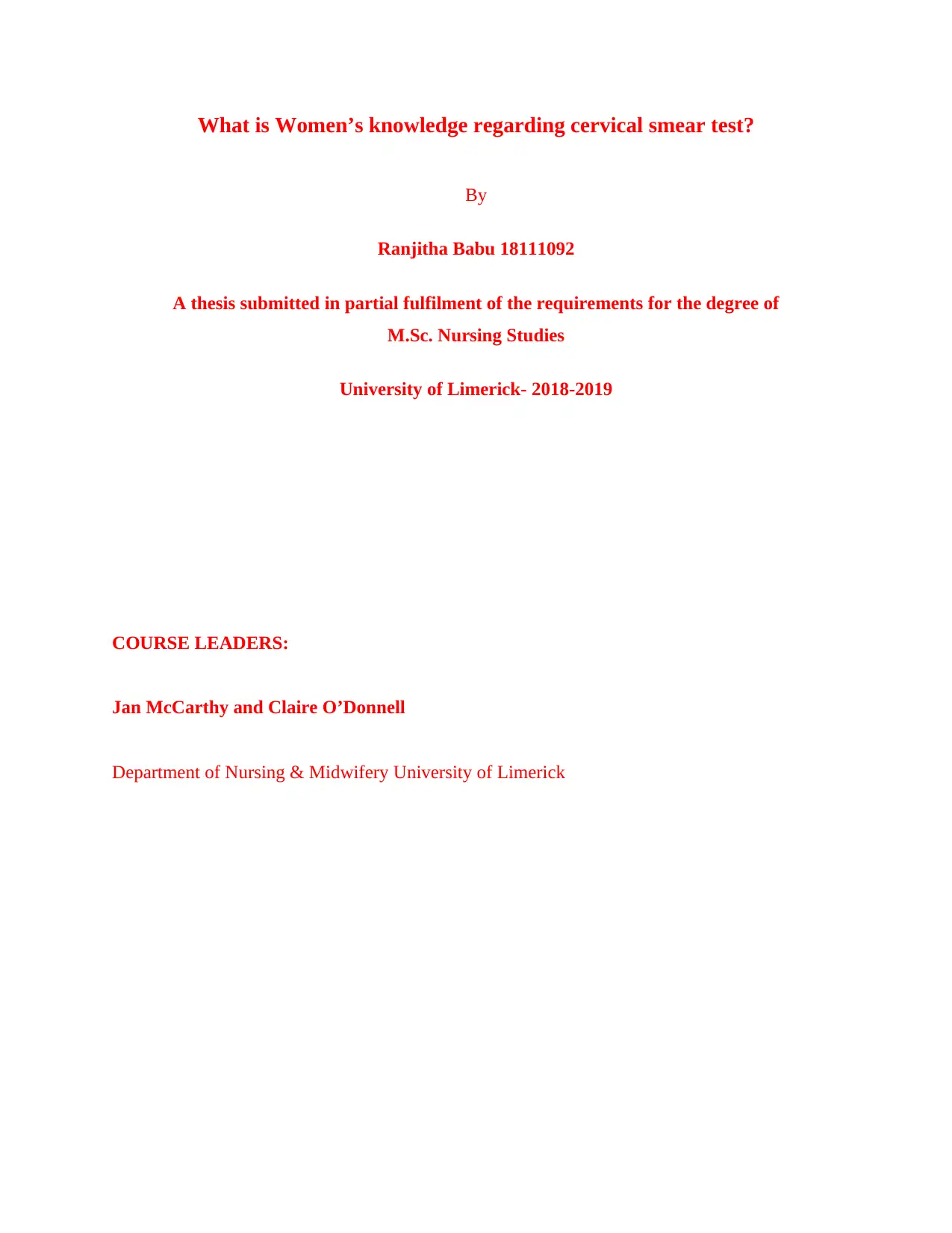
What is Women’s knowledge regarding cervical smear test?
By
Ranjitha Babu 18111092
A thesis submitted in partial fulfilment of the requirements for the degree of
M.Sc. Nursing Studies
University of Limerick- 2018-2019
COURSE LEADERS:
Jan McCarthy and Claire O’Donnell
Department of Nursing & Midwifery University of Limerick
By
Ranjitha Babu 18111092
A thesis submitted in partial fulfilment of the requirements for the degree of
M.Sc. Nursing Studies
University of Limerick- 2018-2019
COURSE LEADERS:
Jan McCarthy and Claire O’Donnell
Department of Nursing & Midwifery University of Limerick
Secure Best Marks with AI Grader
Need help grading? Try our AI Grader for instant feedback on your assignments.
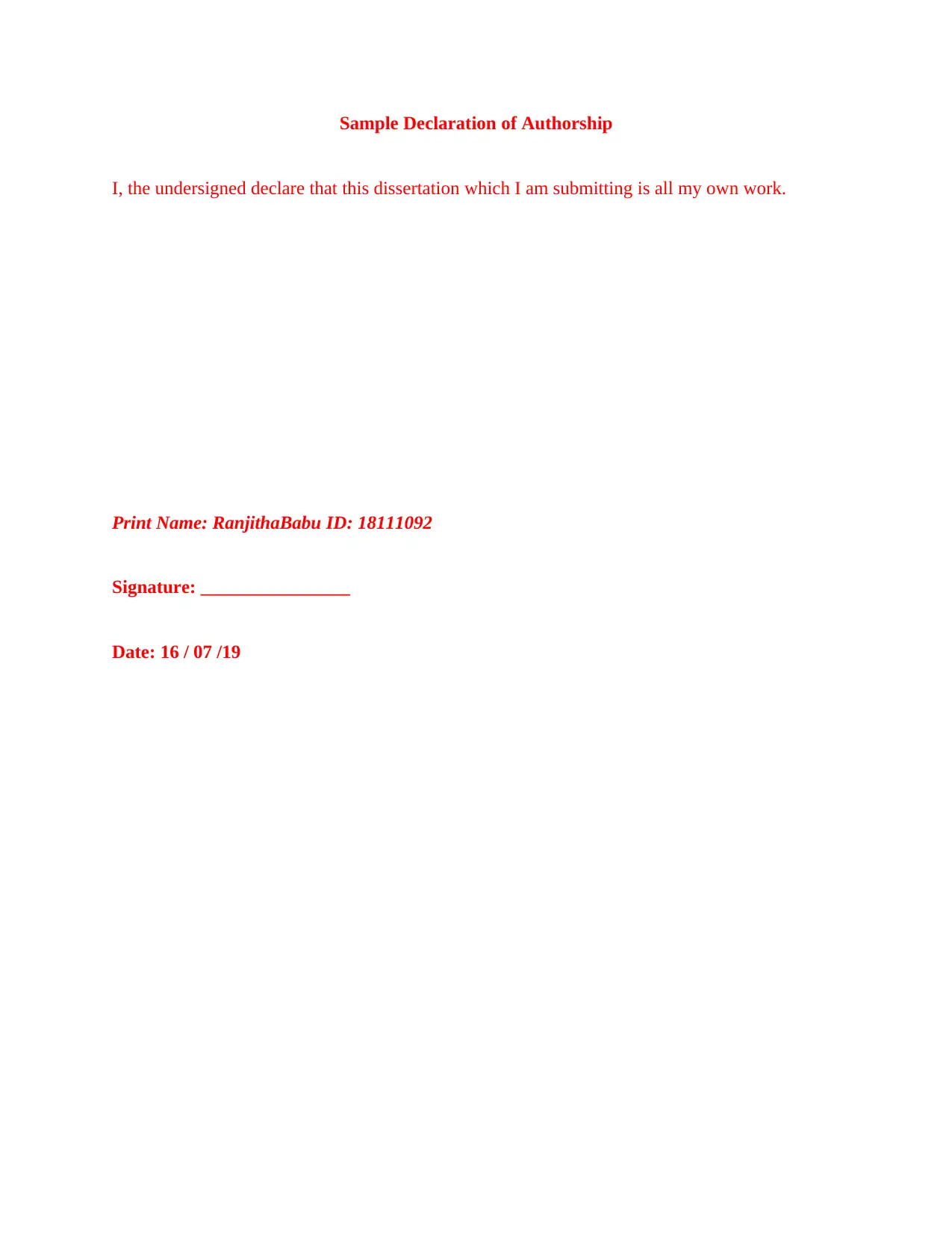
Sample Declaration of Authorship
I, the undersigned declare that this dissertation which I am submitting is all my own work.
Print Name: RanjithaBabu ID: 18111092
Signature: ________________
Date: 16 / 07 /19
I, the undersigned declare that this dissertation which I am submitting is all my own work.
Print Name: RanjithaBabu ID: 18111092
Signature: ________________
Date: 16 / 07 /19


ACKNOWLEDGMENT
I would first like to thank my thesis advisor Jan McCarthy of the department
of Nursing at the University of Limerick. The door to her office was always
open whenever I ran into a trouble or had a question about my thesis or
writing. She consistently allowed this paper to be my own work and steered
me in the right direction whenever she thought I needed it.
I would also like to acknowledge Claire O Donnel of the department of
Nursing at the University of Limerick. Her smile and positive words inspired
and motivated me throughout the period of course. I am also gratefully
indebted to her for her very valuable comments on this thesis.
I would also like to thank my friends for the stimulating discussions, for the
sleepless nights we were working together before deadlines, and for all the
fun we have had in the last one year.
Last but not the least, I would like to thank my family: my parents and to my
sister for supporting me spiritually throughout writing this thesis and my life
in general.
I would first like to thank my thesis advisor Jan McCarthy of the department
of Nursing at the University of Limerick. The door to her office was always
open whenever I ran into a trouble or had a question about my thesis or
writing. She consistently allowed this paper to be my own work and steered
me in the right direction whenever she thought I needed it.
I would also like to acknowledge Claire O Donnel of the department of
Nursing at the University of Limerick. Her smile and positive words inspired
and motivated me throughout the period of course. I am also gratefully
indebted to her for her very valuable comments on this thesis.
I would also like to thank my friends for the stimulating discussions, for the
sleepless nights we were working together before deadlines, and for all the
fun we have had in the last one year.
Last but not the least, I would like to thank my family: my parents and to my
sister for supporting me spiritually throughout writing this thesis and my life
in general.
Secure Best Marks with AI Grader
Need help grading? Try our AI Grader for instant feedback on your assignments.
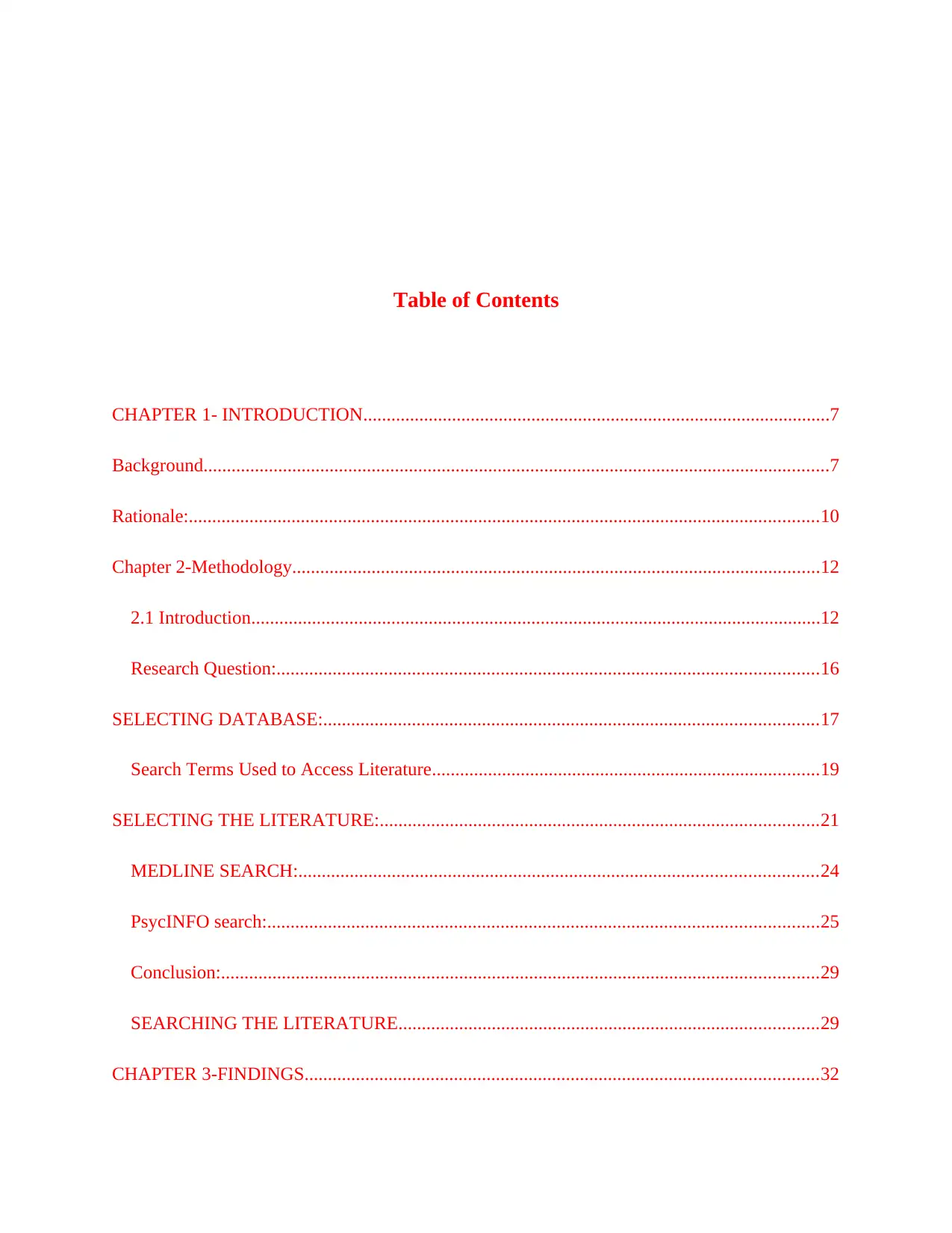
Table of Contents
CHAPTER 1- INTRODUCTION....................................................................................................7
Background......................................................................................................................................7
Rationale:.......................................................................................................................................10
Chapter 2-Methodology.................................................................................................................12
2.1 Introduction..........................................................................................................................12
Research Question:....................................................................................................................16
SELECTING DATABASE:..........................................................................................................17
Search Terms Used to Access Literature...................................................................................19
SELECTING THE LITERATURE:..............................................................................................21
MEDLINE SEARCH:...............................................................................................................24
PsycINFO search:......................................................................................................................25
Conclusion:................................................................................................................................29
SEARCHING THE LITERATURE..........................................................................................29
CHAPTER 3-FINDINGS..............................................................................................................32
CHAPTER 1- INTRODUCTION....................................................................................................7
Background......................................................................................................................................7
Rationale:.......................................................................................................................................10
Chapter 2-Methodology.................................................................................................................12
2.1 Introduction..........................................................................................................................12
Research Question:....................................................................................................................16
SELECTING DATABASE:..........................................................................................................17
Search Terms Used to Access Literature...................................................................................19
SELECTING THE LITERATURE:..............................................................................................21
MEDLINE SEARCH:...............................................................................................................24
PsycINFO search:......................................................................................................................25
Conclusion:................................................................................................................................29
SEARCHING THE LITERATURE..........................................................................................29
CHAPTER 3-FINDINGS..............................................................................................................32
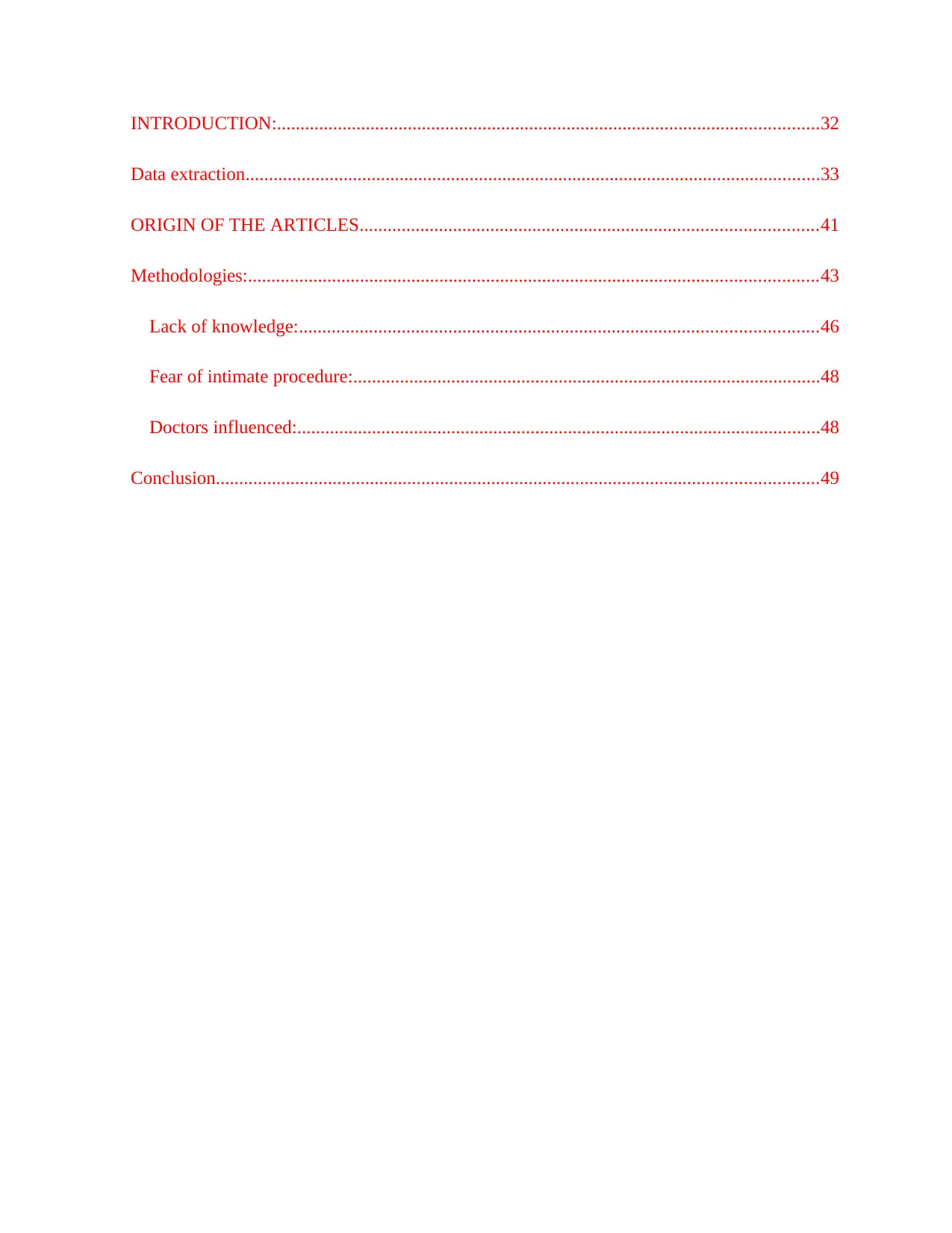
INTRODUCTION:....................................................................................................................32
Data extraction...........................................................................................................................33
ORIGIN OF THE ARTICLES..................................................................................................41
Methodologies:..........................................................................................................................43
Lack of knowledge:...............................................................................................................46
Fear of intimate procedure:....................................................................................................48
Doctors influenced:................................................................................................................48
Conclusion.................................................................................................................................49
Data extraction...........................................................................................................................33
ORIGIN OF THE ARTICLES..................................................................................................41
Methodologies:..........................................................................................................................43
Lack of knowledge:...............................................................................................................46
Fear of intimate procedure:....................................................................................................48
Doctors influenced:................................................................................................................48
Conclusion.................................................................................................................................49
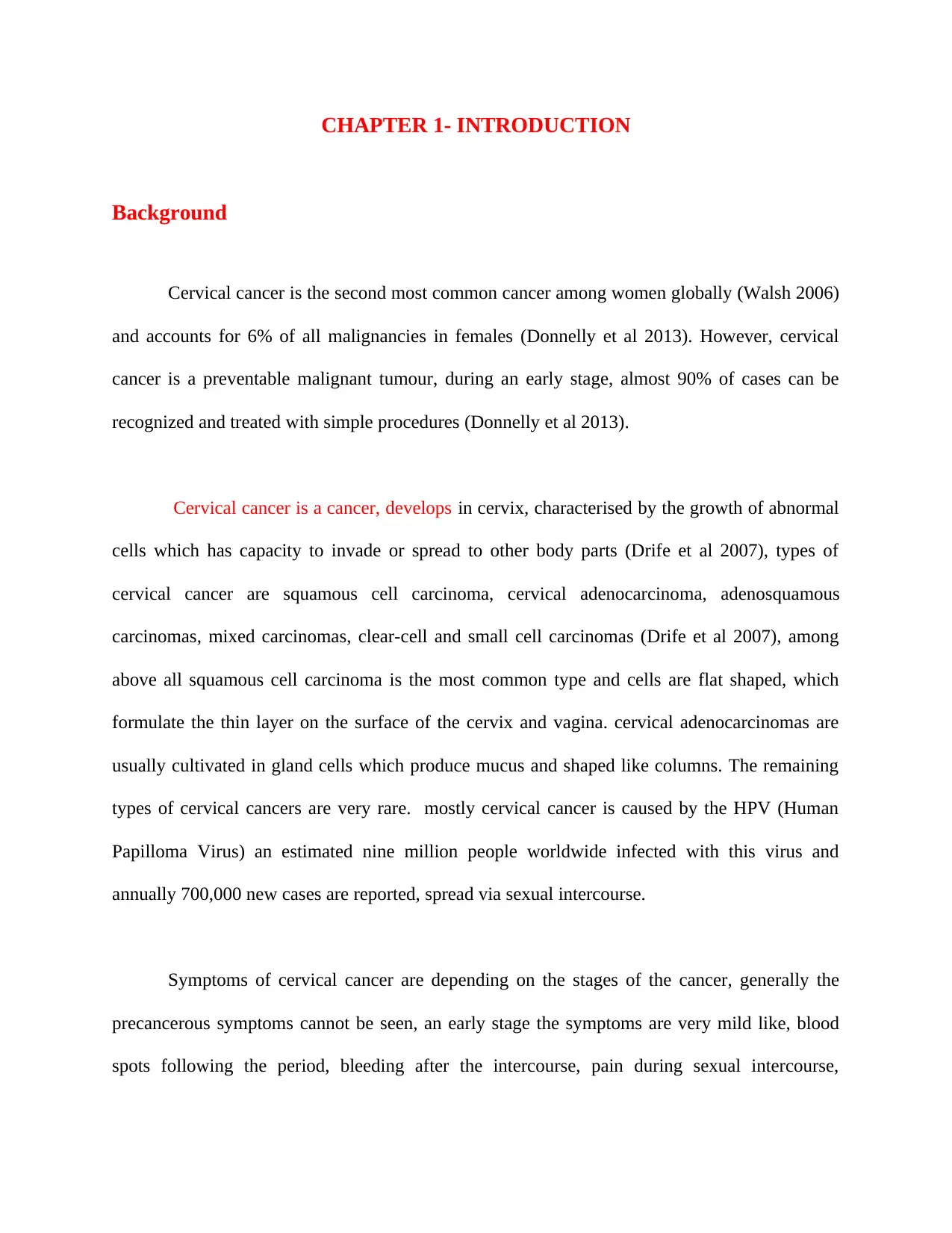
CHAPTER 1- INTRODUCTION
Background
Cervical cancer is the second most common cancer among women globally (Walsh 2006)
and accounts for 6% of all malignancies in females (Donnelly et al 2013). However, cervical
cancer is a preventable malignant tumour, during an early stage, almost 90% of cases can be
recognized and treated with simple procedures (Donnelly et al 2013).
Cervical cancer is a cancer, develops in cervix, characterised by the growth of abnormal
cells which has capacity to invade or spread to other body parts (Drife et al 2007), types of
cervical cancer are squamous cell carcinoma, cervical adenocarcinoma, adenosquamous
carcinomas, mixed carcinomas, clear-cell and small cell carcinomas (Drife et al 2007), among
above all squamous cell carcinoma is the most common type and cells are flat shaped, which
formulate the thin layer on the surface of the cervix and vagina. cervical adenocarcinomas are
usually cultivated in gland cells which produce mucus and shaped like columns. The remaining
types of cervical cancers are very rare. mostly cervical cancer is caused by the HPV (Human
Papilloma Virus) an estimated nine million people worldwide infected with this virus and
annually 700,000 new cases are reported, spread via sexual intercourse.
Symptoms of cervical cancer are depending on the stages of the cancer, generally the
precancerous symptoms cannot be seen, an early stage the symptoms are very mild like, blood
spots following the period, bleeding after the intercourse, pain during sexual intercourse,
Background
Cervical cancer is the second most common cancer among women globally (Walsh 2006)
and accounts for 6% of all malignancies in females (Donnelly et al 2013). However, cervical
cancer is a preventable malignant tumour, during an early stage, almost 90% of cases can be
recognized and treated with simple procedures (Donnelly et al 2013).
Cervical cancer is a cancer, develops in cervix, characterised by the growth of abnormal
cells which has capacity to invade or spread to other body parts (Drife et al 2007), types of
cervical cancer are squamous cell carcinoma, cervical adenocarcinoma, adenosquamous
carcinomas, mixed carcinomas, clear-cell and small cell carcinomas (Drife et al 2007), among
above all squamous cell carcinoma is the most common type and cells are flat shaped, which
formulate the thin layer on the surface of the cervix and vagina. cervical adenocarcinomas are
usually cultivated in gland cells which produce mucus and shaped like columns. The remaining
types of cervical cancers are very rare. mostly cervical cancer is caused by the HPV (Human
Papilloma Virus) an estimated nine million people worldwide infected with this virus and
annually 700,000 new cases are reported, spread via sexual intercourse.
Symptoms of cervical cancer are depending on the stages of the cancer, generally the
precancerous symptoms cannot be seen, an early stage the symptoms are very mild like, blood
spots following the period, bleeding after the intercourse, pain during sexual intercourse,
Paraphrase This Document
Need a fresh take? Get an instant paraphrase of this document with our AI Paraphraser
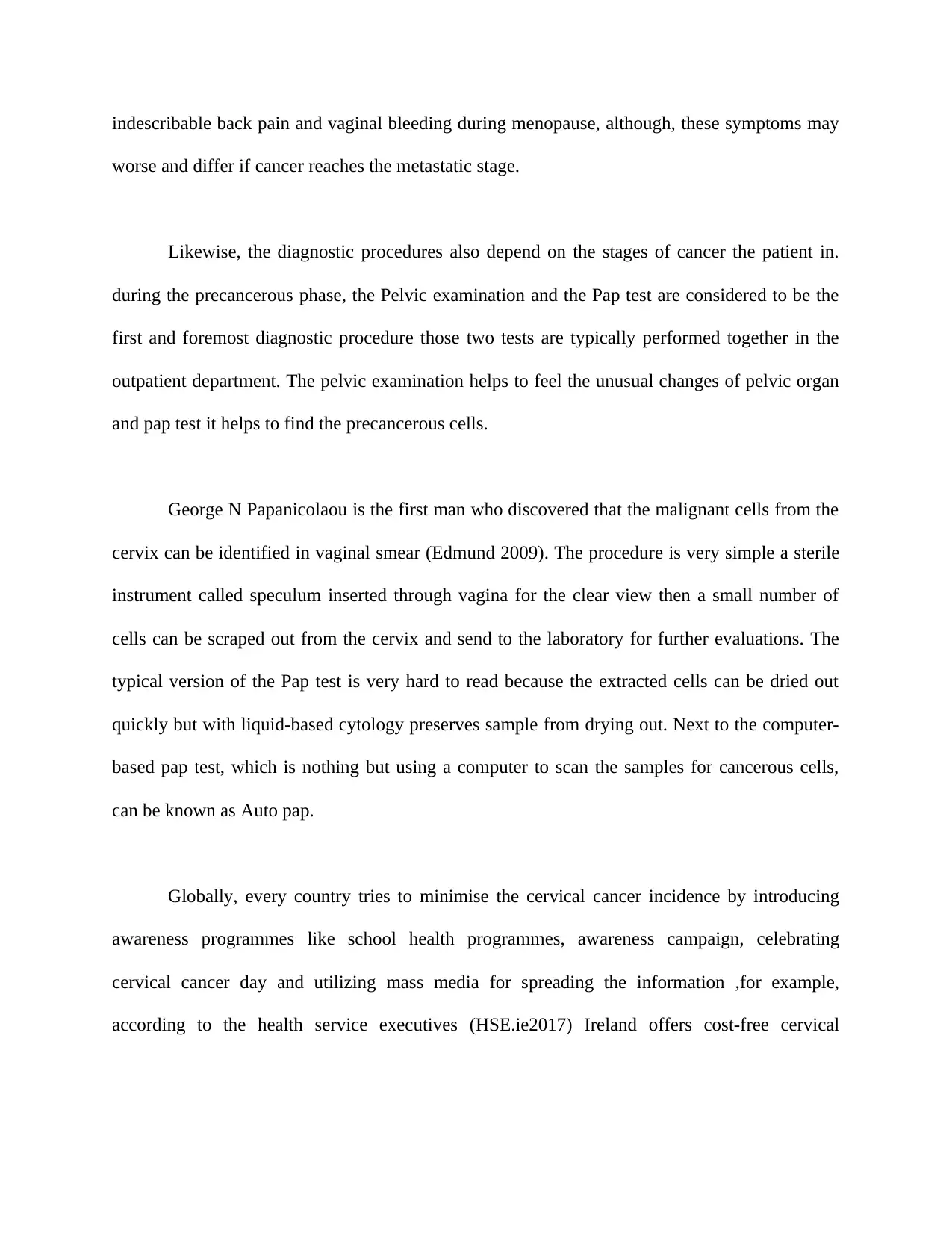
indescribable back pain and vaginal bleeding during menopause, although, these symptoms may
worse and differ if cancer reaches the metastatic stage.
Likewise, the diagnostic procedures also depend on the stages of cancer the patient in.
during the precancerous phase, the Pelvic examination and the Pap test are considered to be the
first and foremost diagnostic procedure those two tests are typically performed together in the
outpatient department. The pelvic examination helps to feel the unusual changes of pelvic organ
and pap test it helps to find the precancerous cells.
George N Papanicolaou is the first man who discovered that the malignant cells from the
cervix can be identified in vaginal smear (Edmund 2009). The procedure is very simple a sterile
instrument called speculum inserted through vagina for the clear view then a small number of
cells can be scraped out from the cervix and send to the laboratory for further evaluations. The
typical version of the Pap test is very hard to read because the extracted cells can be dried out
quickly but with liquid-based cytology preserves sample from drying out. Next to the computer-
based pap test, which is nothing but using a computer to scan the samples for cancerous cells,
can be known as Auto pap.
Globally, every country tries to minimise the cervical cancer incidence by introducing
awareness programmes like school health programmes, awareness campaign, celebrating
cervical cancer day and utilizing mass media for spreading the information ,for example,
according to the health service executives (HSE.ie2017) Ireland offers cost-free cervical
worse and differ if cancer reaches the metastatic stage.
Likewise, the diagnostic procedures also depend on the stages of cancer the patient in.
during the precancerous phase, the Pelvic examination and the Pap test are considered to be the
first and foremost diagnostic procedure those two tests are typically performed together in the
outpatient department. The pelvic examination helps to feel the unusual changes of pelvic organ
and pap test it helps to find the precancerous cells.
George N Papanicolaou is the first man who discovered that the malignant cells from the
cervix can be identified in vaginal smear (Edmund 2009). The procedure is very simple a sterile
instrument called speculum inserted through vagina for the clear view then a small number of
cells can be scraped out from the cervix and send to the laboratory for further evaluations. The
typical version of the Pap test is very hard to read because the extracted cells can be dried out
quickly but with liquid-based cytology preserves sample from drying out. Next to the computer-
based pap test, which is nothing but using a computer to scan the samples for cancerous cells,
can be known as Auto pap.
Globally, every country tries to minimise the cervical cancer incidence by introducing
awareness programmes like school health programmes, awareness campaign, celebrating
cervical cancer day and utilizing mass media for spreading the information ,for example,
according to the health service executives (HSE.ie2017) Ireland offers cost-free cervical
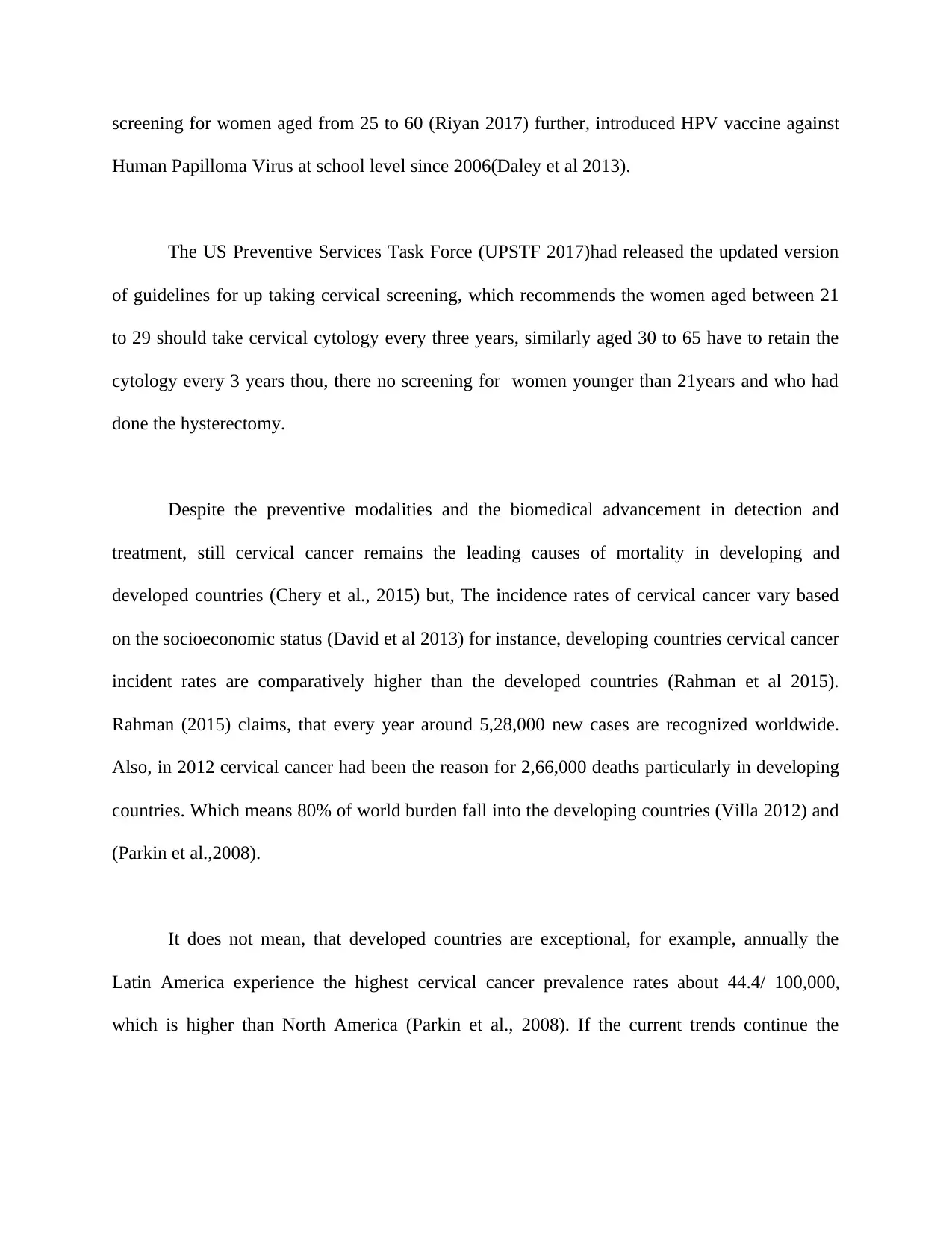
screening for women aged from 25 to 60 (Riyan 2017) further, introduced HPV vaccine against
Human Papilloma Virus at school level since 2006(Daley et al 2013).
The US Preventive Services Task Force (UPSTF 2017)had released the updated version
of guidelines for up taking cervical screening, which recommends the women aged between 21
to 29 should take cervical cytology every three years, similarly aged 30 to 65 have to retain the
cytology every 3 years thou, there no screening for women younger than 21years and who had
done the hysterectomy.
Despite the preventive modalities and the biomedical advancement in detection and
treatment, still cervical cancer remains the leading causes of mortality in developing and
developed countries (Chery et al., 2015) but, The incidence rates of cervical cancer vary based
on the socioeconomic status (David et al 2013) for instance, developing countries cervical cancer
incident rates are comparatively higher than the developed countries (Rahman et al 2015).
Rahman (2015) claims, that every year around 5,28,000 new cases are recognized worldwide.
Also, in 2012 cervical cancer had been the reason for 2,66,000 deaths particularly in developing
countries. Which means 80% of world burden fall into the developing countries (Villa 2012) and
(Parkin et al.,2008).
It does not mean, that developed countries are exceptional, for example, annually the
Latin America experience the highest cervical cancer prevalence rates about 44.4/ 100,000,
which is higher than North America (Parkin et al., 2008). If the current trends continue the
Human Papilloma Virus at school level since 2006(Daley et al 2013).
The US Preventive Services Task Force (UPSTF 2017)had released the updated version
of guidelines for up taking cervical screening, which recommends the women aged between 21
to 29 should take cervical cytology every three years, similarly aged 30 to 65 have to retain the
cytology every 3 years thou, there no screening for women younger than 21years and who had
done the hysterectomy.
Despite the preventive modalities and the biomedical advancement in detection and
treatment, still cervical cancer remains the leading causes of mortality in developing and
developed countries (Chery et al., 2015) but, The incidence rates of cervical cancer vary based
on the socioeconomic status (David et al 2013) for instance, developing countries cervical cancer
incident rates are comparatively higher than the developed countries (Rahman et al 2015).
Rahman (2015) claims, that every year around 5,28,000 new cases are recognized worldwide.
Also, in 2012 cervical cancer had been the reason for 2,66,000 deaths particularly in developing
countries. Which means 80% of world burden fall into the developing countries (Villa 2012) and
(Parkin et al.,2008).
It does not mean, that developed countries are exceptional, for example, annually the
Latin America experience the highest cervical cancer prevalence rates about 44.4/ 100,000,
which is higher than North America (Parkin et al., 2008). If the current trends continue the
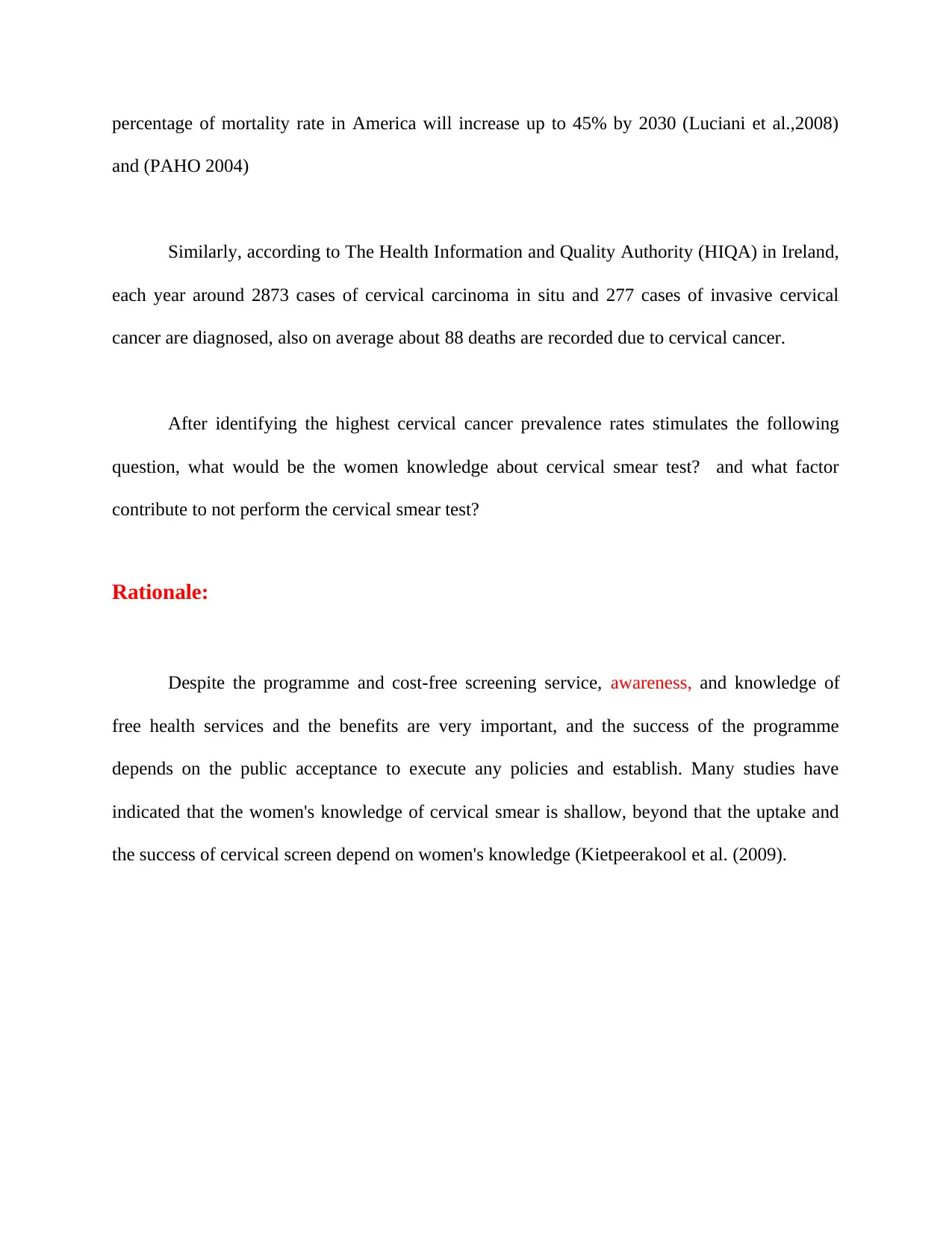
percentage of mortality rate in America will increase up to 45% by 2030 (Luciani et al.,2008)
and (PAHO 2004)
Similarly, according to The Health Information and Quality Authority (HIQA) in Ireland,
each year around 2873 cases of cervical carcinoma in situ and 277 cases of invasive cervical
cancer are diagnosed, also on average about 88 deaths are recorded due to cervical cancer.
After identifying the highest cervical cancer prevalence rates stimulates the following
question, what would be the women knowledge about cervical smear test? and what factor
contribute to not perform the cervical smear test?
Rationale:
Despite the programme and cost-free screening service, awareness, and knowledge of
free health services and the benefits are very important, and the success of the programme
depends on the public acceptance to execute any policies and establish. Many studies have
indicated that the women's knowledge of cervical smear is shallow, beyond that the uptake and
the success of cervical screen depend on women's knowledge (Kietpeerakool et al. (2009).
and (PAHO 2004)
Similarly, according to The Health Information and Quality Authority (HIQA) in Ireland,
each year around 2873 cases of cervical carcinoma in situ and 277 cases of invasive cervical
cancer are diagnosed, also on average about 88 deaths are recorded due to cervical cancer.
After identifying the highest cervical cancer prevalence rates stimulates the following
question, what would be the women knowledge about cervical smear test? and what factor
contribute to not perform the cervical smear test?
Rationale:
Despite the programme and cost-free screening service, awareness, and knowledge of
free health services and the benefits are very important, and the success of the programme
depends on the public acceptance to execute any policies and establish. Many studies have
indicated that the women's knowledge of cervical smear is shallow, beyond that the uptake and
the success of cervical screen depend on women's knowledge (Kietpeerakool et al. (2009).
Secure Best Marks with AI Grader
Need help grading? Try our AI Grader for instant feedback on your assignments.
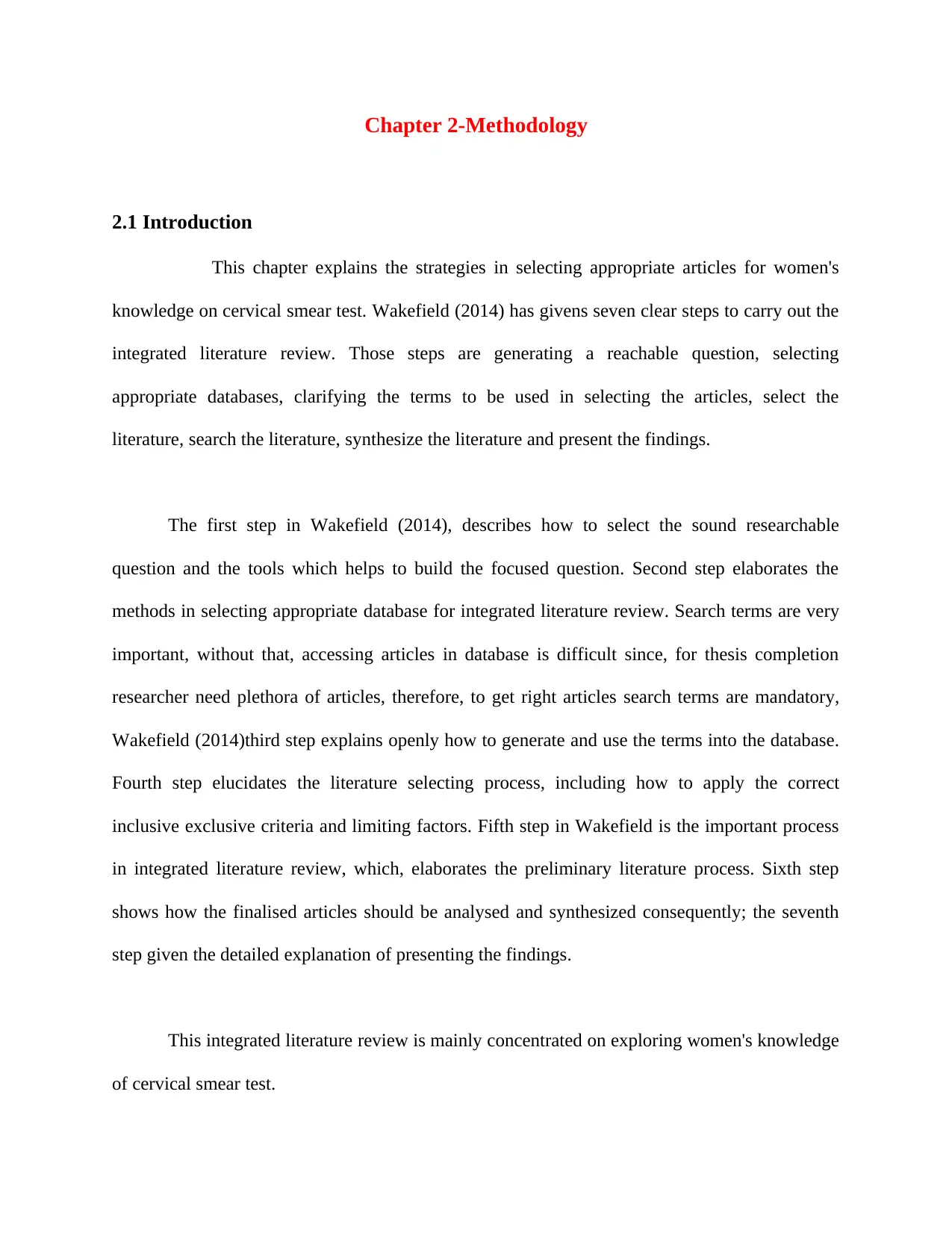
Chapter 2-Methodology
2.1 Introduction
This chapter explains the strategies in selecting appropriate articles for women's
knowledge on cervical smear test. Wakefield (2014) has givens seven clear steps to carry out the
integrated literature review. Those steps are generating a reachable question, selecting
appropriate databases, clarifying the terms to be used in selecting the articles, select the
literature, search the literature, synthesize the literature and present the findings.
The first step in Wakefield (2014), describes how to select the sound researchable
question and the tools which helps to build the focused question. Second step elaborates the
methods in selecting appropriate database for integrated literature review. Search terms are very
important, without that, accessing articles in database is difficult since, for thesis completion
researcher need plethora of articles, therefore, to get right articles search terms are mandatory,
Wakefield (2014)third step explains openly how to generate and use the terms into the database.
Fourth step elucidates the literature selecting process, including how to apply the correct
inclusive exclusive criteria and limiting factors. Fifth step in Wakefield is the important process
in integrated literature review, which, elaborates the preliminary literature process. Sixth step
shows how the finalised articles should be analysed and synthesized consequently; the seventh
step given the detailed explanation of presenting the findings.
This integrated literature review is mainly concentrated on exploring women's knowledge
of cervical smear test.
2.1 Introduction
This chapter explains the strategies in selecting appropriate articles for women's
knowledge on cervical smear test. Wakefield (2014) has givens seven clear steps to carry out the
integrated literature review. Those steps are generating a reachable question, selecting
appropriate databases, clarifying the terms to be used in selecting the articles, select the
literature, search the literature, synthesize the literature and present the findings.
The first step in Wakefield (2014), describes how to select the sound researchable
question and the tools which helps to build the focused question. Second step elaborates the
methods in selecting appropriate database for integrated literature review. Search terms are very
important, without that, accessing articles in database is difficult since, for thesis completion
researcher need plethora of articles, therefore, to get right articles search terms are mandatory,
Wakefield (2014)third step explains openly how to generate and use the terms into the database.
Fourth step elucidates the literature selecting process, including how to apply the correct
inclusive exclusive criteria and limiting factors. Fifth step in Wakefield is the important process
in integrated literature review, which, elaborates the preliminary literature process. Sixth step
shows how the finalised articles should be analysed and synthesized consequently; the seventh
step given the detailed explanation of presenting the findings.
This integrated literature review is mainly concentrated on exploring women's knowledge
of cervical smear test.
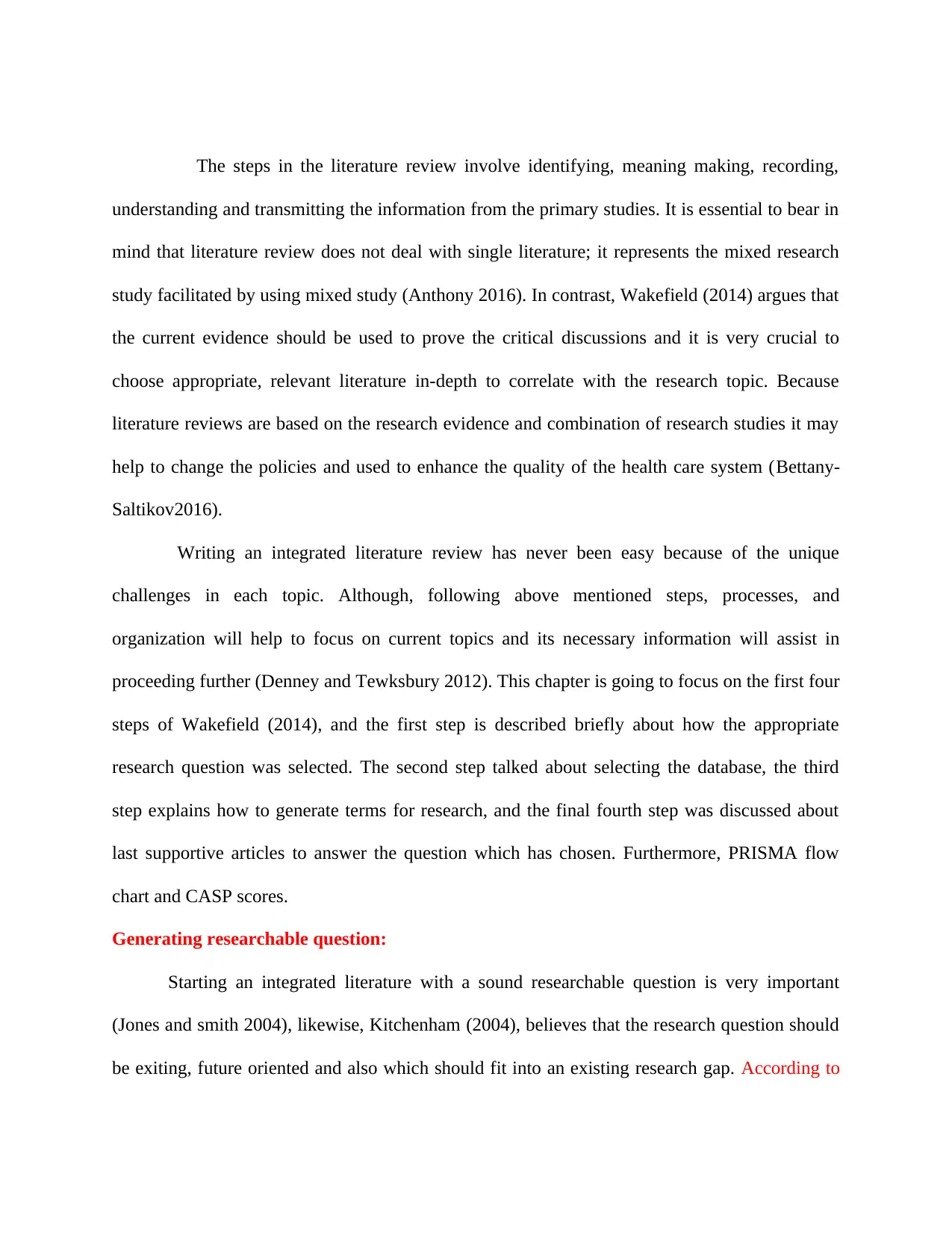
The steps in the literature review involve identifying, meaning making, recording,
understanding and transmitting the information from the primary studies. It is essential to bear in
mind that literature review does not deal with single literature; it represents the mixed research
study facilitated by using mixed study (Anthony 2016). In contrast, Wakefield (2014) argues that
the current evidence should be used to prove the critical discussions and it is very crucial to
choose appropriate, relevant literature in-depth to correlate with the research topic. Because
literature reviews are based on the research evidence and combination of research studies it may
help to change the policies and used to enhance the quality of the health care system (Bettany-
Saltikov2016).
Writing an integrated literature review has never been easy because of the unique
challenges in each topic. Although, following above mentioned steps, processes, and
organization will help to focus on current topics and its necessary information will assist in
proceeding further (Denney and Tewksbury 2012). This chapter is going to focus on the first four
steps of Wakefield (2014), and the first step is described briefly about how the appropriate
research question was selected. The second step talked about selecting the database, the third
step explains how to generate terms for research, and the final fourth step was discussed about
last supportive articles to answer the question which has chosen. Furthermore, PRISMA flow
chart and CASP scores.
Generating researchable question:
Starting an integrated literature with a sound researchable question is very important
(Jones and smith 2004), likewise, Kitchenham (2004), believes that the research question should
be exiting, future oriented and also which should fit into an existing research gap. According to
understanding and transmitting the information from the primary studies. It is essential to bear in
mind that literature review does not deal with single literature; it represents the mixed research
study facilitated by using mixed study (Anthony 2016). In contrast, Wakefield (2014) argues that
the current evidence should be used to prove the critical discussions and it is very crucial to
choose appropriate, relevant literature in-depth to correlate with the research topic. Because
literature reviews are based on the research evidence and combination of research studies it may
help to change the policies and used to enhance the quality of the health care system (Bettany-
Saltikov2016).
Writing an integrated literature review has never been easy because of the unique
challenges in each topic. Although, following above mentioned steps, processes, and
organization will help to focus on current topics and its necessary information will assist in
proceeding further (Denney and Tewksbury 2012). This chapter is going to focus on the first four
steps of Wakefield (2014), and the first step is described briefly about how the appropriate
research question was selected. The second step talked about selecting the database, the third
step explains how to generate terms for research, and the final fourth step was discussed about
last supportive articles to answer the question which has chosen. Furthermore, PRISMA flow
chart and CASP scores.
Generating researchable question:
Starting an integrated literature with a sound researchable question is very important
(Jones and smith 2004), likewise, Kitchenham (2004), believes that the research question should
be exiting, future oriented and also which should fit into an existing research gap. According to
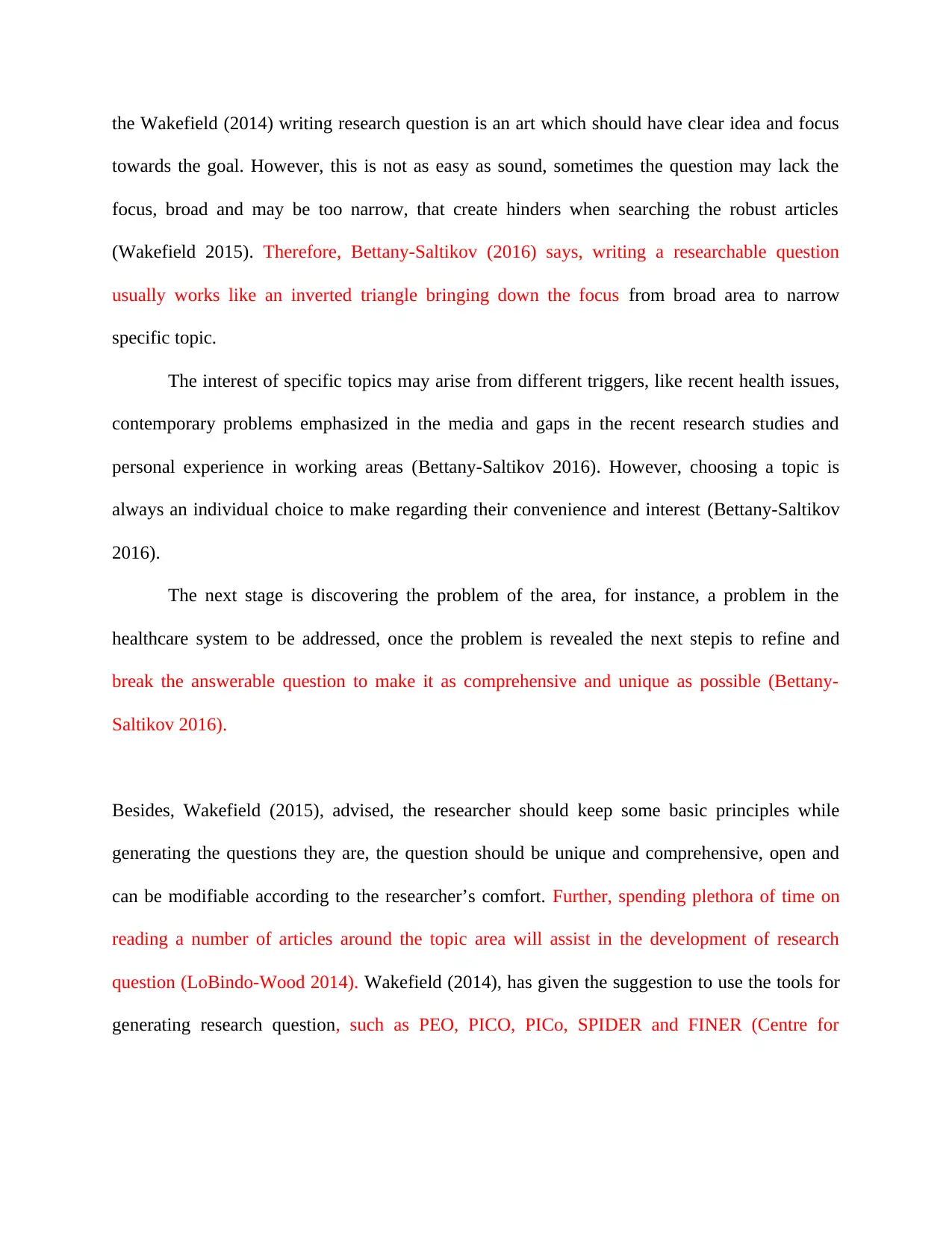
the Wakefield (2014) writing research question is an art which should have clear idea and focus
towards the goal. However, this is not as easy as sound, sometimes the question may lack the
focus, broad and may be too narrow, that create hinders when searching the robust articles
(Wakefield 2015). Therefore, Bettany-Saltikov (2016) says, writing a researchable question
usually works like an inverted triangle bringing down the focus from broad area to narrow
specific topic.
The interest of specific topics may arise from different triggers, like recent health issues,
contemporary problems emphasized in the media and gaps in the recent research studies and
personal experience in working areas (Bettany-Saltikov 2016). However, choosing a topic is
always an individual choice to make regarding their convenience and interest (Bettany-Saltikov
2016).
The next stage is discovering the problem of the area, for instance, a problem in the
healthcare system to be addressed, once the problem is revealed the next stepis to refine and
break the answerable question to make it as comprehensive and unique as possible (Bettany-
Saltikov 2016).
Besides, Wakefield (2015), advised, the researcher should keep some basic principles while
generating the questions they are, the question should be unique and comprehensive, open and
can be modifiable according to the researcher’s comfort. Further, spending plethora of time on
reading a number of articles around the topic area will assist in the development of research
question (LoBindo-Wood 2014). Wakefield (2014), has given the suggestion to use the tools for
generating research question, such as PEO, PICO, PICo, SPIDER and FINER (Centre for
towards the goal. However, this is not as easy as sound, sometimes the question may lack the
focus, broad and may be too narrow, that create hinders when searching the robust articles
(Wakefield 2015). Therefore, Bettany-Saltikov (2016) says, writing a researchable question
usually works like an inverted triangle bringing down the focus from broad area to narrow
specific topic.
The interest of specific topics may arise from different triggers, like recent health issues,
contemporary problems emphasized in the media and gaps in the recent research studies and
personal experience in working areas (Bettany-Saltikov 2016). However, choosing a topic is
always an individual choice to make regarding their convenience and interest (Bettany-Saltikov
2016).
The next stage is discovering the problem of the area, for instance, a problem in the
healthcare system to be addressed, once the problem is revealed the next stepis to refine and
break the answerable question to make it as comprehensive and unique as possible (Bettany-
Saltikov 2016).
Besides, Wakefield (2015), advised, the researcher should keep some basic principles while
generating the questions they are, the question should be unique and comprehensive, open and
can be modifiable according to the researcher’s comfort. Further, spending plethora of time on
reading a number of articles around the topic area will assist in the development of research
question (LoBindo-Wood 2014). Wakefield (2014), has given the suggestion to use the tools for
generating research question, such as PEO, PICO, PICo, SPIDER and FINER (Centre for
Paraphrase This Document
Need a fresh take? Get an instant paraphrase of this document with our AI Paraphraser
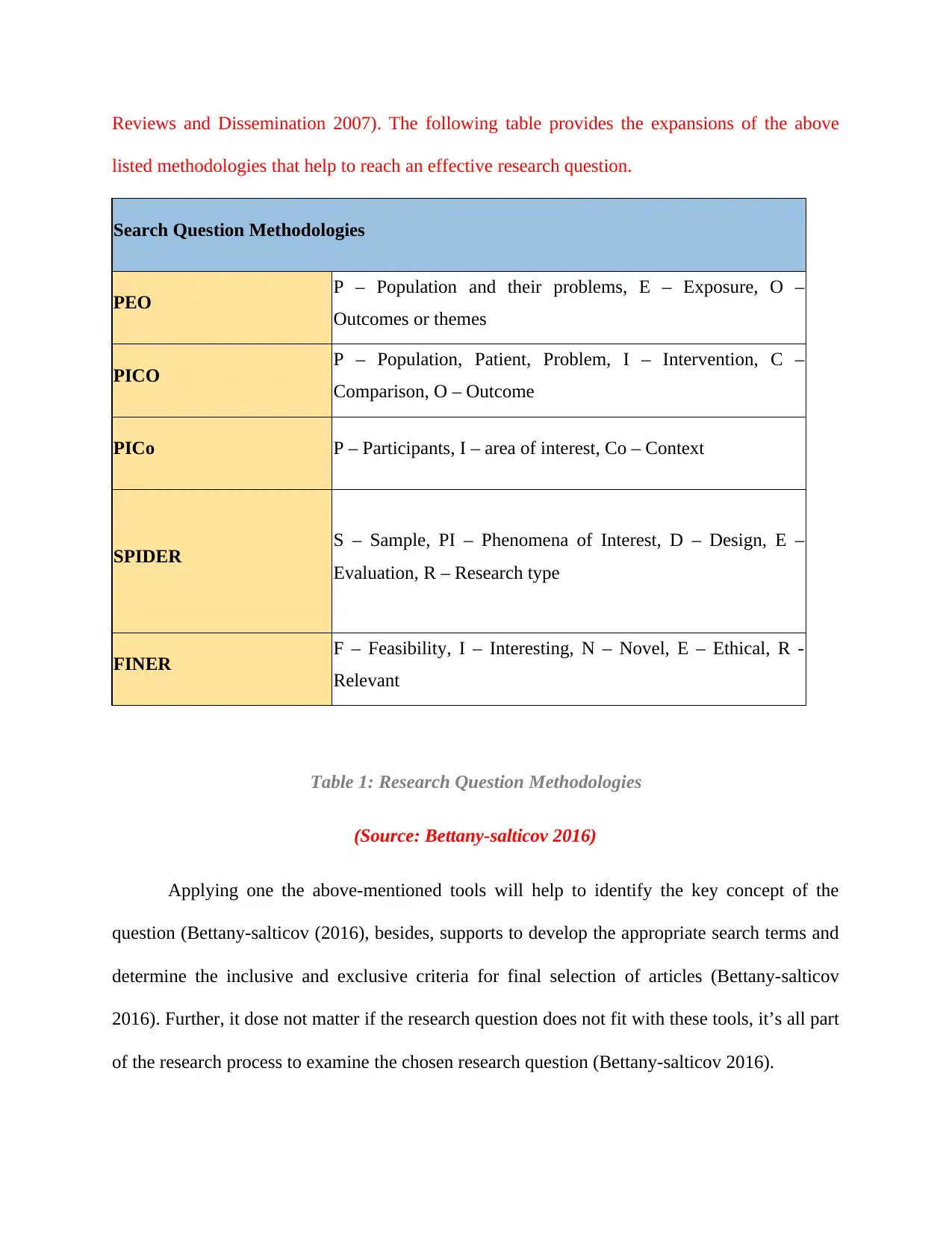
Reviews and Dissemination 2007). The following table provides the expansions of the above
listed methodologies that help to reach an effective research question.
Search Question Methodologies
PEO P – Population and their problems, E – Exposure, O –
Outcomes or themes
PICO P – Population, Patient, Problem, I – Intervention, C –
Comparison, O – Outcome
PICo P – Participants, I – area of interest, Co – Context
SPIDER S – Sample, PI – Phenomena of Interest, D – Design, E –
Evaluation, R – Research type
FINER F – Feasibility, I – Interesting, N – Novel, E – Ethical, R -
Relevant
Table 1: Research Question Methodologies
(Source: Bettany-salticov 2016)
Applying one the above-mentioned tools will help to identify the key concept of the
question (Bettany-salticov (2016), besides, supports to develop the appropriate search terms and
determine the inclusive and exclusive criteria for final selection of articles (Bettany-salticov
2016). Further, it dose not matter if the research question does not fit with these tools, it’s all part
of the research process to examine the chosen research question (Bettany-salticov 2016).
listed methodologies that help to reach an effective research question.
Search Question Methodologies
PEO P – Population and their problems, E – Exposure, O –
Outcomes or themes
PICO P – Population, Patient, Problem, I – Intervention, C –
Comparison, O – Outcome
PICo P – Participants, I – area of interest, Co – Context
SPIDER S – Sample, PI – Phenomena of Interest, D – Design, E –
Evaluation, R – Research type
FINER F – Feasibility, I – Interesting, N – Novel, E – Ethical, R -
Relevant
Table 1: Research Question Methodologies
(Source: Bettany-salticov 2016)
Applying one the above-mentioned tools will help to identify the key concept of the
question (Bettany-salticov (2016), besides, supports to develop the appropriate search terms and
determine the inclusive and exclusive criteria for final selection of articles (Bettany-salticov
2016). Further, it dose not matter if the research question does not fit with these tools, it’s all part
of the research process to examine the chosen research question (Bettany-salticov 2016).
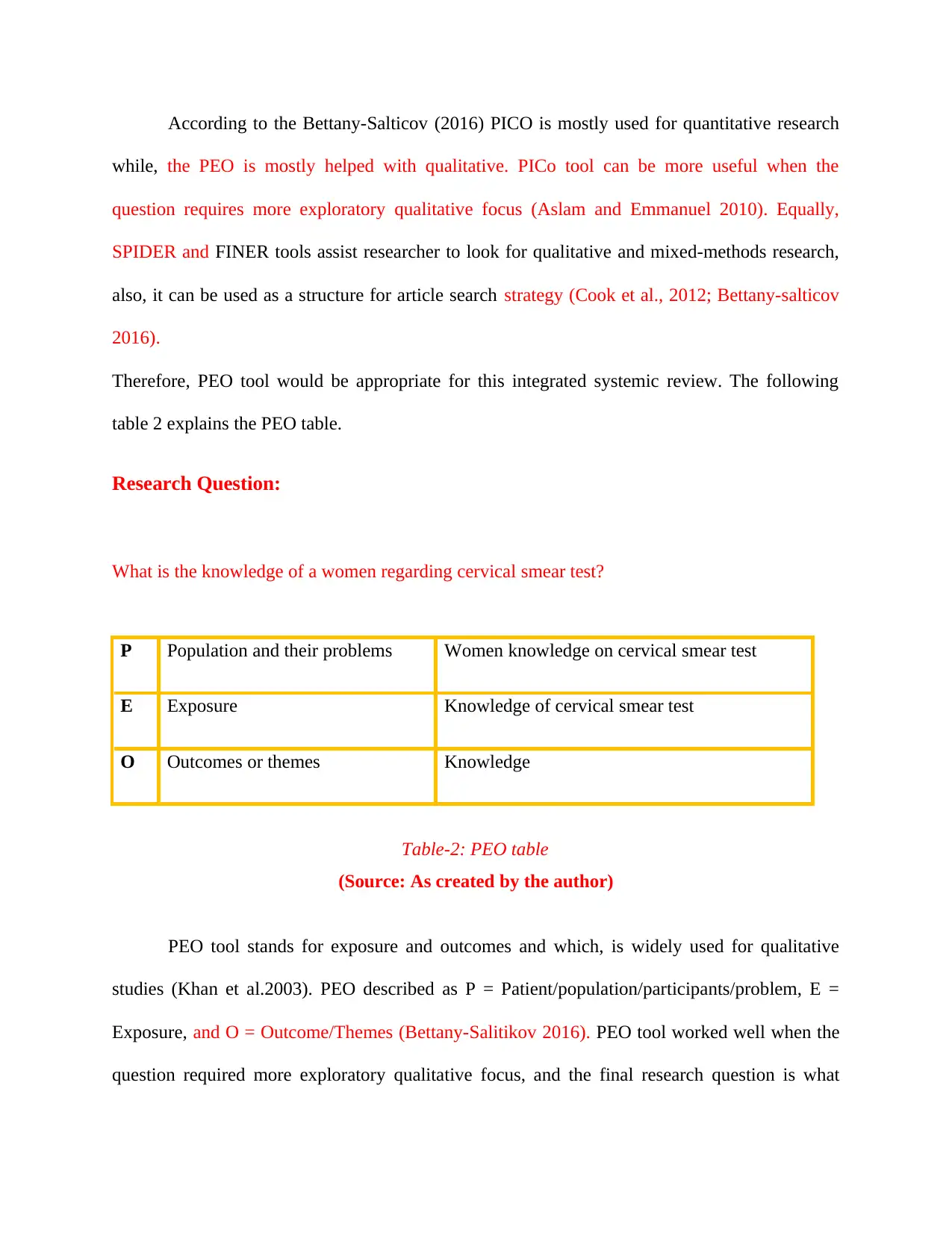
According to the Bettany-Salticov (2016) PICO is mostly used for quantitative research
while, the PEO is mostly helped with qualitative. PICo tool can be more useful when the
question requires more exploratory qualitative focus (Aslam and Emmanuel 2010). Equally,
SPIDER and FINER tools assist researcher to look for qualitative and mixed-methods research,
also, it can be used as a structure for article search strategy (Cook et al., 2012; Bettany-salticov
2016).
Therefore, PEO tool would be appropriate for this integrated systemic review. The following
table 2 explains the PEO table.
Research Question:
What is the knowledge of a women regarding cervical smear test?
P Population and their problems Women knowledge on cervical smear test
E Exposure Knowledge of cervical smear test
O Outcomes or themes Knowledge
Table-2: PEO table
(Source: As created by the author)
PEO tool stands for exposure and outcomes and which, is widely used for qualitative
studies (Khan et al.2003). PEO described as P = Patient/population/participants/problem, E =
Exposure, and O = Outcome/Themes (Bettany-Salitikov 2016). PEO tool worked well when the
question required more exploratory qualitative focus, and the final research question is what
while, the PEO is mostly helped with qualitative. PICo tool can be more useful when the
question requires more exploratory qualitative focus (Aslam and Emmanuel 2010). Equally,
SPIDER and FINER tools assist researcher to look for qualitative and mixed-methods research,
also, it can be used as a structure for article search strategy (Cook et al., 2012; Bettany-salticov
2016).
Therefore, PEO tool would be appropriate for this integrated systemic review. The following
table 2 explains the PEO table.
Research Question:
What is the knowledge of a women regarding cervical smear test?
P Population and their problems Women knowledge on cervical smear test
E Exposure Knowledge of cervical smear test
O Outcomes or themes Knowledge
Table-2: PEO table
(Source: As created by the author)
PEO tool stands for exposure and outcomes and which, is widely used for qualitative
studies (Khan et al.2003). PEO described as P = Patient/population/participants/problem, E =
Exposure, and O = Outcome/Themes (Bettany-Salitikov 2016). PEO tool worked well when the
question required more exploratory qualitative focus, and the final research question is what
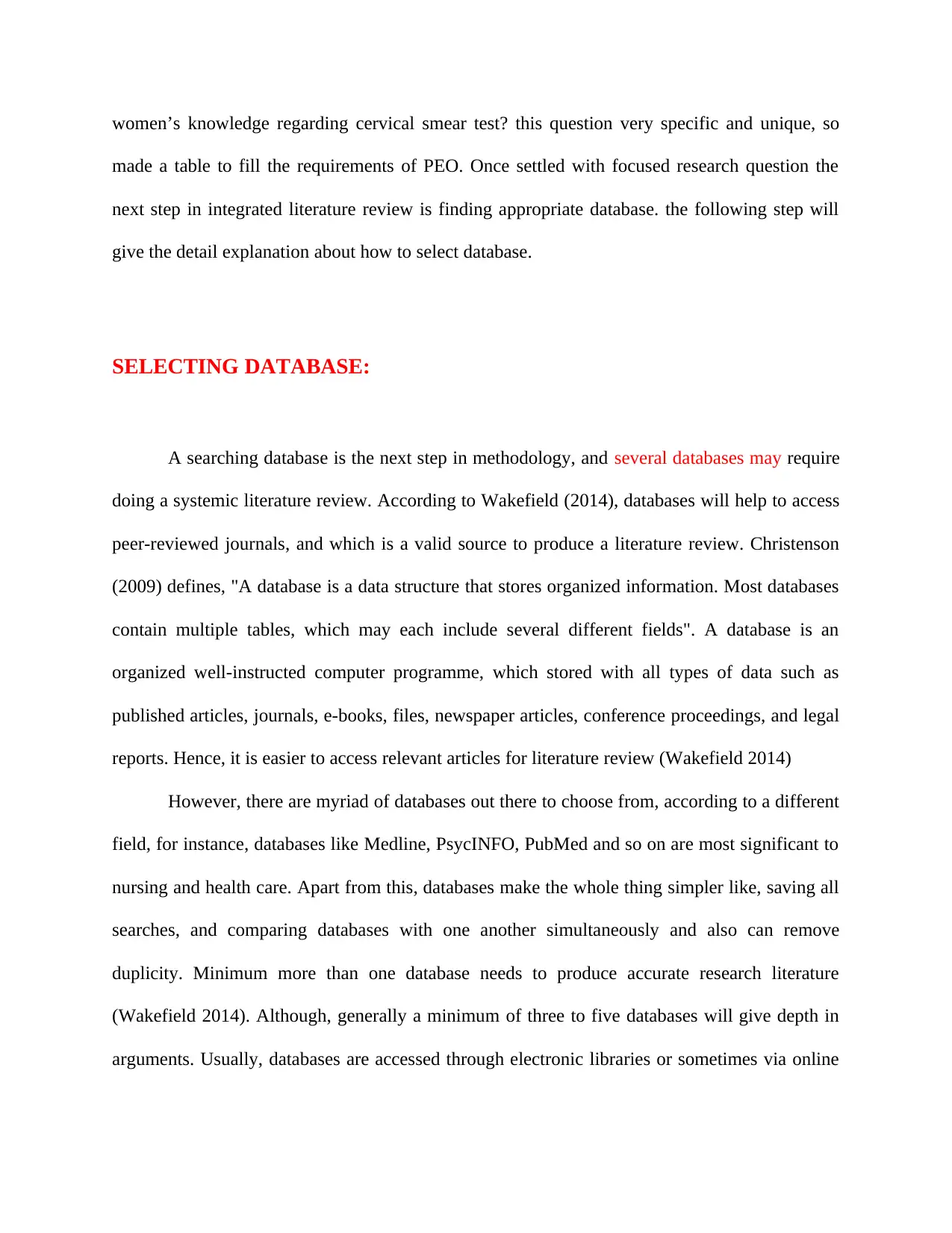
women’s knowledge regarding cervical smear test? this question very specific and unique, so
made a table to fill the requirements of PEO. Once settled with focused research question the
next step in integrated literature review is finding appropriate database. the following step will
give the detail explanation about how to select database.
SELECTING DATABASE:
A searching database is the next step in methodology, and several databases may require
doing a systemic literature review. According to Wakefield (2014), databases will help to access
peer-reviewed journals, and which is a valid source to produce a literature review. Christenson
(2009) defines, "A database is a data structure that stores organized information. Most databases
contain multiple tables, which may each include several different fields". A database is an
organized well-instructed computer programme, which stored with all types of data such as
published articles, journals, e-books, files, newspaper articles, conference proceedings, and legal
reports. Hence, it is easier to access relevant articles for literature review (Wakefield 2014)
However, there are myriad of databases out there to choose from, according to a different
field, for instance, databases like Medline, PsycINFO, PubMed and so on are most significant to
nursing and health care. Apart from this, databases make the whole thing simpler like, saving all
searches, and comparing databases with one another simultaneously and also can remove
duplicity. Minimum more than one database needs to produce accurate research literature
(Wakefield 2014). Although, generally a minimum of three to five databases will give depth in
arguments. Usually, databases are accessed through electronic libraries or sometimes via online
made a table to fill the requirements of PEO. Once settled with focused research question the
next step in integrated literature review is finding appropriate database. the following step will
give the detail explanation about how to select database.
SELECTING DATABASE:
A searching database is the next step in methodology, and several databases may require
doing a systemic literature review. According to Wakefield (2014), databases will help to access
peer-reviewed journals, and which is a valid source to produce a literature review. Christenson
(2009) defines, "A database is a data structure that stores organized information. Most databases
contain multiple tables, which may each include several different fields". A database is an
organized well-instructed computer programme, which stored with all types of data such as
published articles, journals, e-books, files, newspaper articles, conference proceedings, and legal
reports. Hence, it is easier to access relevant articles for literature review (Wakefield 2014)
However, there are myriad of databases out there to choose from, according to a different
field, for instance, databases like Medline, PsycINFO, PubMed and so on are most significant to
nursing and health care. Apart from this, databases make the whole thing simpler like, saving all
searches, and comparing databases with one another simultaneously and also can remove
duplicity. Minimum more than one database needs to produce accurate research literature
(Wakefield 2014). Although, generally a minimum of three to five databases will give depth in
arguments. Usually, databases are accessed through electronic libraries or sometimes via online
Secure Best Marks with AI Grader
Need help grading? Try our AI Grader for instant feedback on your assignments.
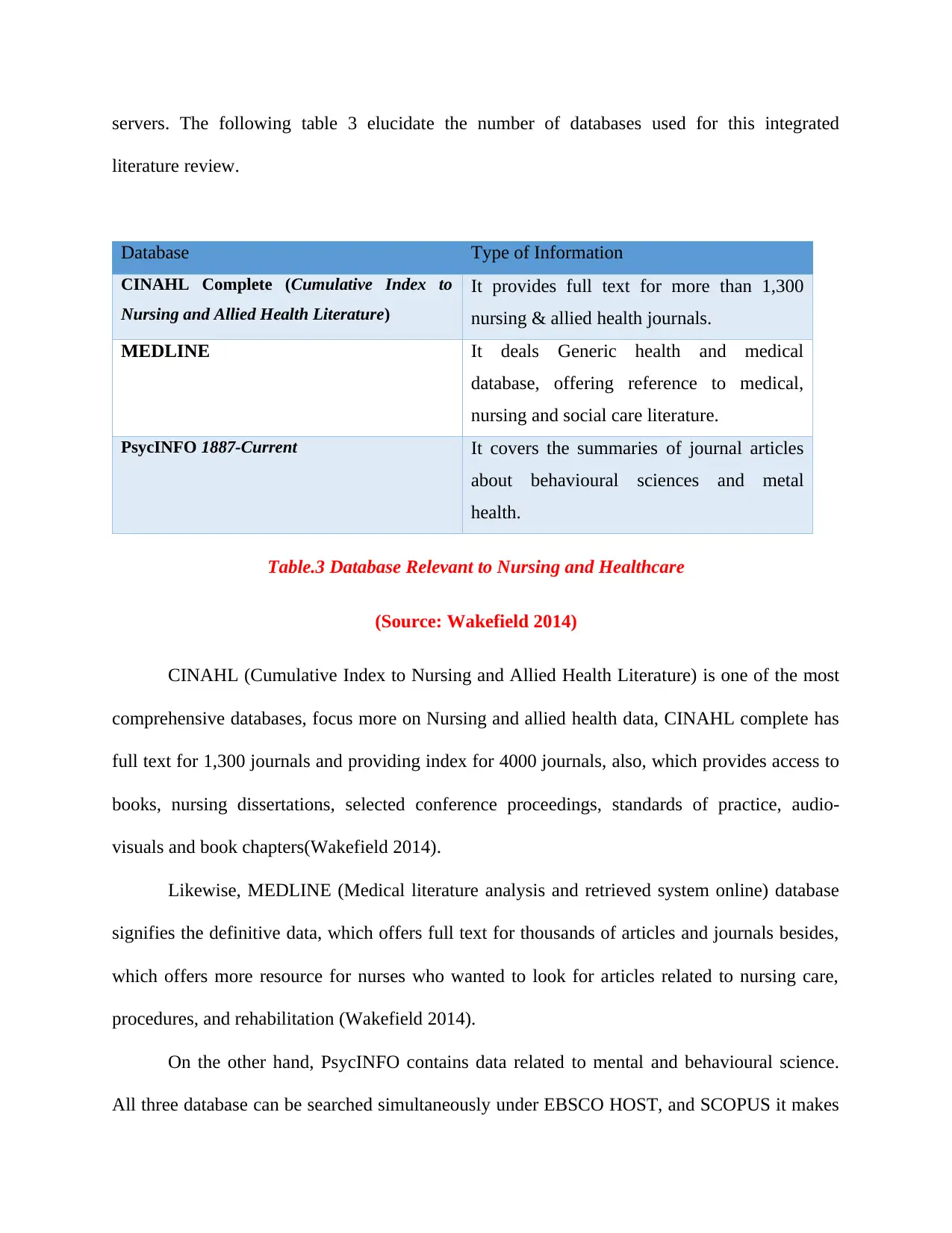
servers. The following table 3 elucidate the number of databases used for this integrated
literature review.
Database Type of Information
CINAHL Complete (Cumulative Index to
Nursing and Allied Health Literature)
It provides full text for more than 1,300
nursing & allied health journals.
MEDLINE It deals Generic health and medical
database, offering reference to medical,
nursing and social care literature.
PsycINFO 1887-Current It covers the summaries of journal articles
about behavioural sciences and metal
health.
Table.3 Database Relevant to Nursing and Healthcare
(Source: Wakefield 2014)
CINAHL (Cumulative Index to Nursing and Allied Health Literature) is one of the most
comprehensive databases, focus more on Nursing and allied health data, CINAHL complete has
full text for 1,300 journals and providing index for 4000 journals, also, which provides access to
books, nursing dissertations, selected conference proceedings, standards of practice, audio-
visuals and book chapters(Wakefield 2014).
Likewise, MEDLINE (Medical literature analysis and retrieved system online) database
signifies the definitive data, which offers full text for thousands of articles and journals besides,
which offers more resource for nurses who wanted to look for articles related to nursing care,
procedures, and rehabilitation (Wakefield 2014).
On the other hand, PsycINFO contains data related to mental and behavioural science.
All three database can be searched simultaneously under EBSCO HOST, and SCOPUS it makes
literature review.
Database Type of Information
CINAHL Complete (Cumulative Index to
Nursing and Allied Health Literature)
It provides full text for more than 1,300
nursing & allied health journals.
MEDLINE It deals Generic health and medical
database, offering reference to medical,
nursing and social care literature.
PsycINFO 1887-Current It covers the summaries of journal articles
about behavioural sciences and metal
health.
Table.3 Database Relevant to Nursing and Healthcare
(Source: Wakefield 2014)
CINAHL (Cumulative Index to Nursing and Allied Health Literature) is one of the most
comprehensive databases, focus more on Nursing and allied health data, CINAHL complete has
full text for 1,300 journals and providing index for 4000 journals, also, which provides access to
books, nursing dissertations, selected conference proceedings, standards of practice, audio-
visuals and book chapters(Wakefield 2014).
Likewise, MEDLINE (Medical literature analysis and retrieved system online) database
signifies the definitive data, which offers full text for thousands of articles and journals besides,
which offers more resource for nurses who wanted to look for articles related to nursing care,
procedures, and rehabilitation (Wakefield 2014).
On the other hand, PsycINFO contains data related to mental and behavioural science.
All three database can be searched simultaneously under EBSCO HOST, and SCOPUS it makes
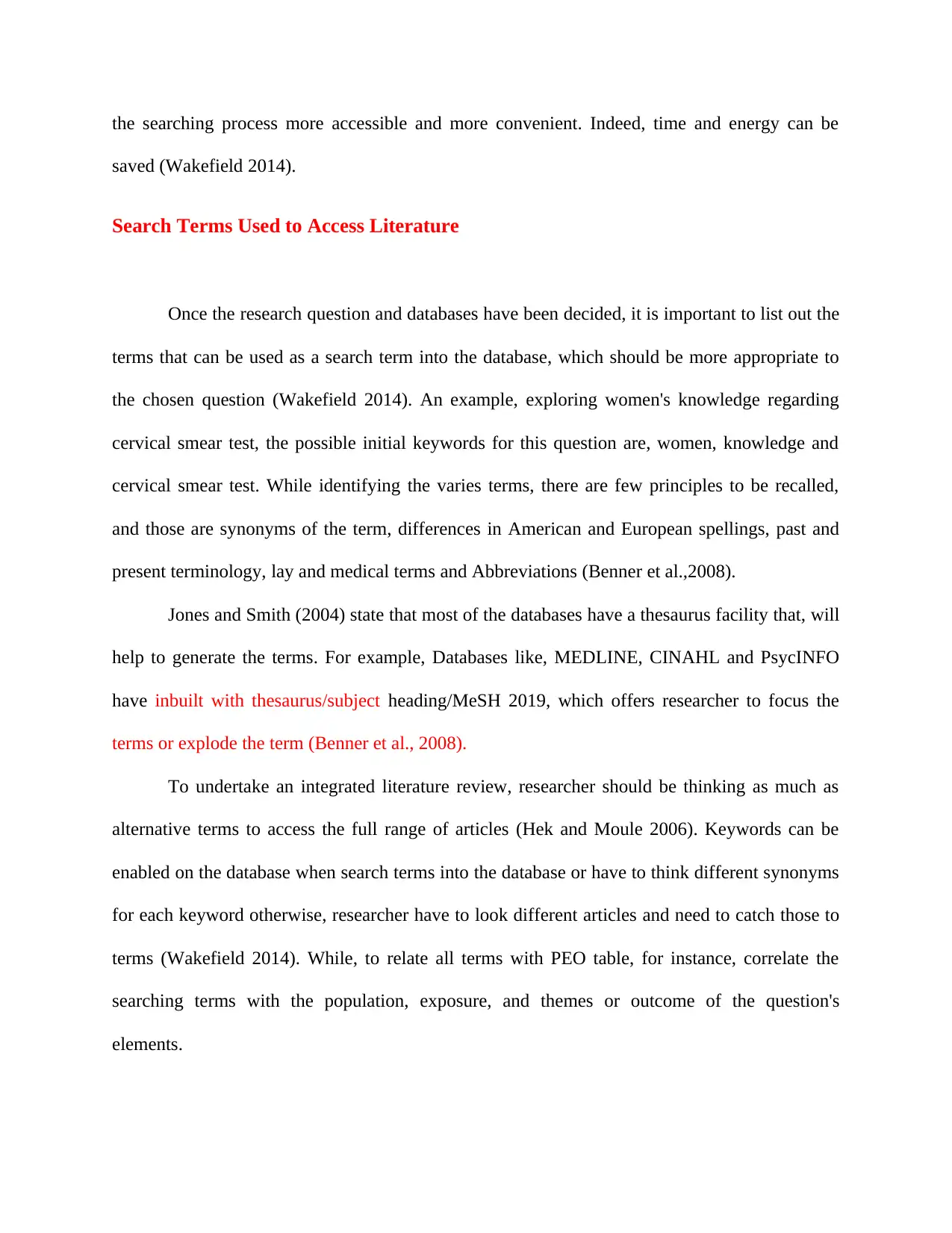
the searching process more accessible and more convenient. Indeed, time and energy can be
saved (Wakefield 2014).
Search Terms Used to Access Literature
Once the research question and databases have been decided, it is important to list out the
terms that can be used as a search term into the database, which should be more appropriate to
the chosen question (Wakefield 2014). An example, exploring women's knowledge regarding
cervical smear test, the possible initial keywords for this question are, women, knowledge and
cervical smear test. While identifying the varies terms, there are few principles to be recalled,
and those are synonyms of the term, differences in American and European spellings, past and
present terminology, lay and medical terms and Abbreviations (Benner et al.,2008).
Jones and Smith (2004) state that most of the databases have a thesaurus facility that, will
help to generate the terms. For example, Databases like, MEDLINE, CINAHL and PsycINFO
have inbuilt with thesaurus/subject heading/MeSH 2019, which offers researcher to focus the
terms or explode the term (Benner et al., 2008).
To undertake an integrated literature review, researcher should be thinking as much as
alternative terms to access the full range of articles (Hek and Moule 2006). Keywords can be
enabled on the database when search terms into the database or have to think different synonyms
for each keyword otherwise, researcher have to look different articles and need to catch those to
terms (Wakefield 2014). While, to relate all terms with PEO table, for instance, correlate the
searching terms with the population, exposure, and themes or outcome of the question's
elements.
saved (Wakefield 2014).
Search Terms Used to Access Literature
Once the research question and databases have been decided, it is important to list out the
terms that can be used as a search term into the database, which should be more appropriate to
the chosen question (Wakefield 2014). An example, exploring women's knowledge regarding
cervical smear test, the possible initial keywords for this question are, women, knowledge and
cervical smear test. While identifying the varies terms, there are few principles to be recalled,
and those are synonyms of the term, differences in American and European spellings, past and
present terminology, lay and medical terms and Abbreviations (Benner et al.,2008).
Jones and Smith (2004) state that most of the databases have a thesaurus facility that, will
help to generate the terms. For example, Databases like, MEDLINE, CINAHL and PsycINFO
have inbuilt with thesaurus/subject heading/MeSH 2019, which offers researcher to focus the
terms or explode the term (Benner et al., 2008).
To undertake an integrated literature review, researcher should be thinking as much as
alternative terms to access the full range of articles (Hek and Moule 2006). Keywords can be
enabled on the database when search terms into the database or have to think different synonyms
for each keyword otherwise, researcher have to look different articles and need to catch those to
terms (Wakefield 2014). While, to relate all terms with PEO table, for instance, correlate the
searching terms with the population, exposure, and themes or outcome of the question's
elements.
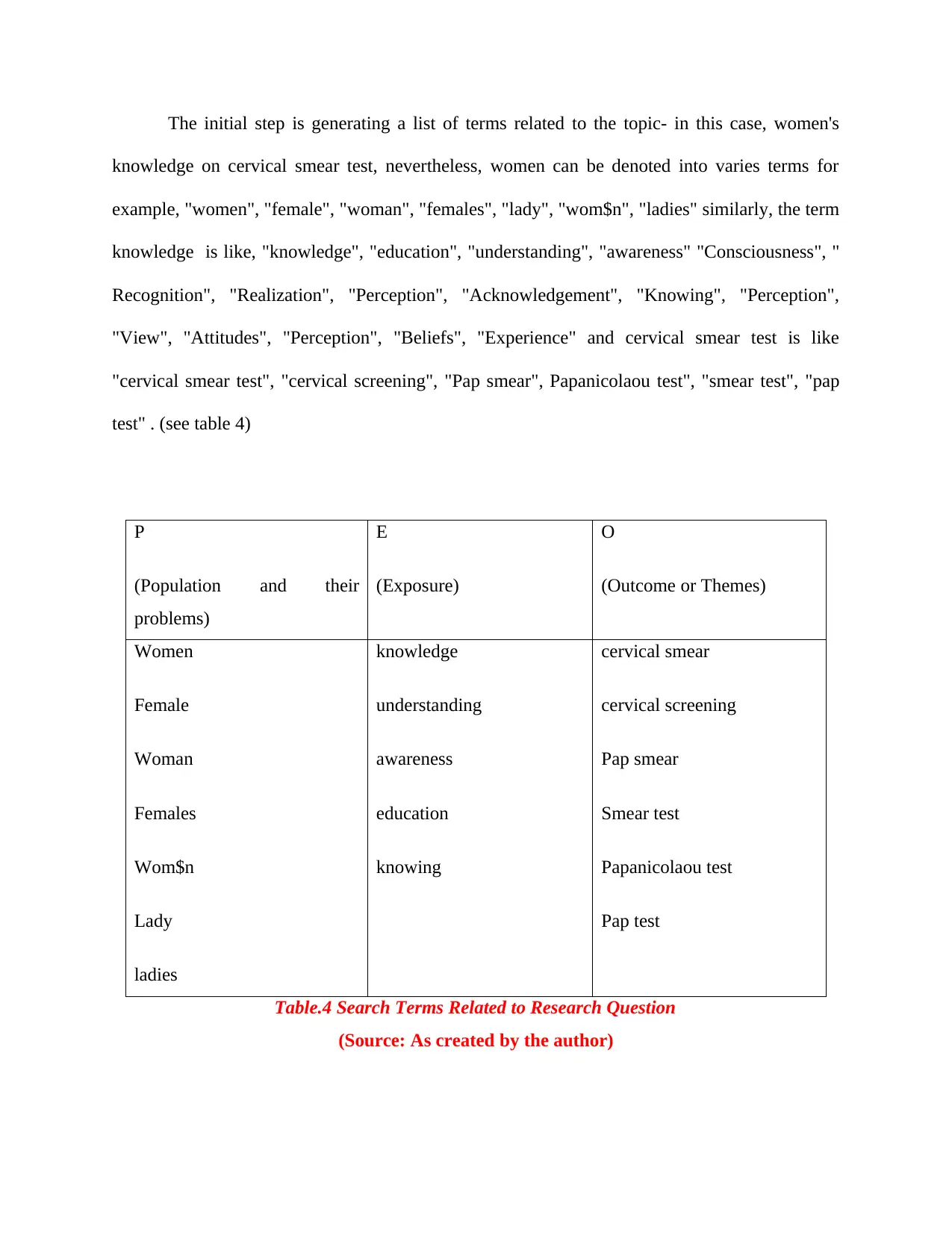
The initial step is generating a list of terms related to the topic- in this case, women's
knowledge on cervical smear test, nevertheless, women can be denoted into varies terms for
example, "women", "female", "woman", "females", "lady", "wom$n", "ladies" similarly, the term
knowledge is like, "knowledge", "education", "understanding", "awareness" "Consciousness", "
Recognition", "Realization", "Perception", "Acknowledgement", "Knowing", "Perception",
"View", "Attitudes", "Perception", "Beliefs", "Experience" and cervical smear test is like
"cervical smear test", "cervical screening", "Pap smear", Papanicolaou test", "smear test", "pap
test" . (see table 4)
P
(Population and their
problems)
E
(Exposure)
O
(Outcome or Themes)
Women
Female
Woman
Females
Wom$n
Lady
ladies
knowledge
understanding
awareness
education
knowing
cervical smear
cervical screening
Pap smear
Smear test
Papanicolaou test
Pap test
Table.4 Search Terms Related to Research Question
(Source: As created by the author)
knowledge on cervical smear test, nevertheless, women can be denoted into varies terms for
example, "women", "female", "woman", "females", "lady", "wom$n", "ladies" similarly, the term
knowledge is like, "knowledge", "education", "understanding", "awareness" "Consciousness", "
Recognition", "Realization", "Perception", "Acknowledgement", "Knowing", "Perception",
"View", "Attitudes", "Perception", "Beliefs", "Experience" and cervical smear test is like
"cervical smear test", "cervical screening", "Pap smear", Papanicolaou test", "smear test", "pap
test" . (see table 4)
P
(Population and their
problems)
E
(Exposure)
O
(Outcome or Themes)
Women
Female
Woman
Females
Wom$n
Lady
ladies
knowledge
understanding
awareness
education
knowing
cervical smear
cervical screening
Pap smear
Smear test
Papanicolaou test
Pap test
Table.4 Search Terms Related to Research Question
(Source: As created by the author)
Paraphrase This Document
Need a fresh take? Get an instant paraphrase of this document with our AI Paraphraser
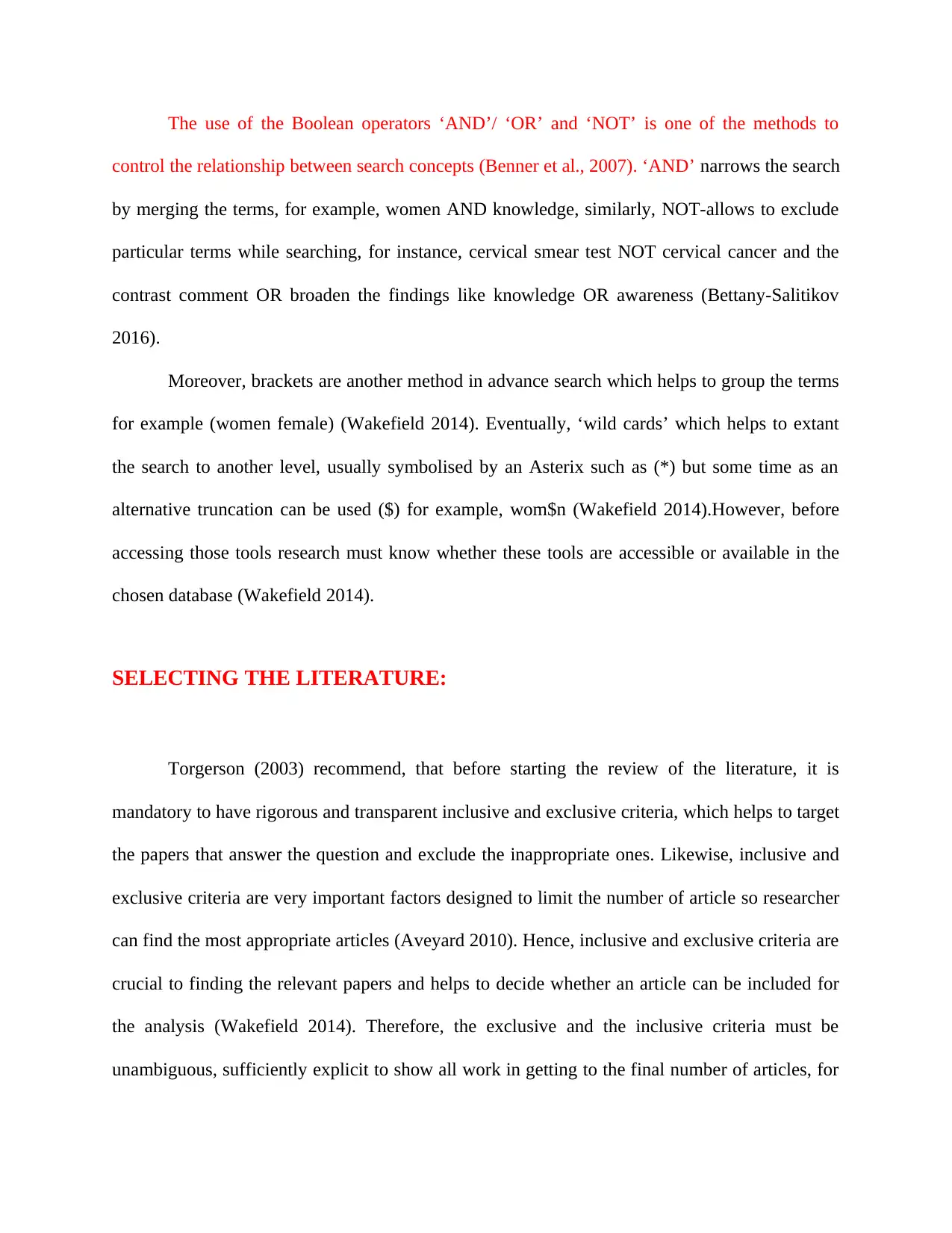
The use of the Boolean operators ‘AND’/ ‘OR’ and ‘NOT’ is one of the methods to
control the relationship between search concepts (Benner et al., 2007). ‘AND’ narrows the search
by merging the terms, for example, women AND knowledge, similarly, NOT-allows to exclude
particular terms while searching, for instance, cervical smear test NOT cervical cancer and the
contrast comment OR broaden the findings like knowledge OR awareness (Bettany-Salitikov
2016).
Moreover, brackets are another method in advance search which helps to group the terms
for example (women female) (Wakefield 2014). Eventually, ‘wild cards’ which helps to extant
the search to another level, usually symbolised by an Asterix such as (*) but some time as an
alternative truncation can be used ($) for example, wom$n (Wakefield 2014).However, before
accessing those tools research must know whether these tools are accessible or available in the
chosen database (Wakefield 2014).
SELECTING THE LITERATURE:
Torgerson (2003) recommend, that before starting the review of the literature, it is
mandatory to have rigorous and transparent inclusive and exclusive criteria, which helps to target
the papers that answer the question and exclude the inappropriate ones. Likewise, inclusive and
exclusive criteria are very important factors designed to limit the number of article so researcher
can find the most appropriate articles (Aveyard 2010). Hence, inclusive and exclusive criteria are
crucial to finding the relevant papers and helps to decide whether an article can be included for
the analysis (Wakefield 2014). Therefore, the exclusive and the inclusive criteria must be
unambiguous, sufficiently explicit to show all work in getting to the final number of articles, for
control the relationship between search concepts (Benner et al., 2007). ‘AND’ narrows the search
by merging the terms, for example, women AND knowledge, similarly, NOT-allows to exclude
particular terms while searching, for instance, cervical smear test NOT cervical cancer and the
contrast comment OR broaden the findings like knowledge OR awareness (Bettany-Salitikov
2016).
Moreover, brackets are another method in advance search which helps to group the terms
for example (women female) (Wakefield 2014). Eventually, ‘wild cards’ which helps to extant
the search to another level, usually symbolised by an Asterix such as (*) but some time as an
alternative truncation can be used ($) for example, wom$n (Wakefield 2014).However, before
accessing those tools research must know whether these tools are accessible or available in the
chosen database (Wakefield 2014).
SELECTING THE LITERATURE:
Torgerson (2003) recommend, that before starting the review of the literature, it is
mandatory to have rigorous and transparent inclusive and exclusive criteria, which helps to target
the papers that answer the question and exclude the inappropriate ones. Likewise, inclusive and
exclusive criteria are very important factors designed to limit the number of article so researcher
can find the most appropriate articles (Aveyard 2010). Hence, inclusive and exclusive criteria are
crucial to finding the relevant papers and helps to decide whether an article can be included for
the analysis (Wakefield 2014). Therefore, the exclusive and the inclusive criteria must be
unambiguous, sufficiently explicit to show all work in getting to the final number of articles, for
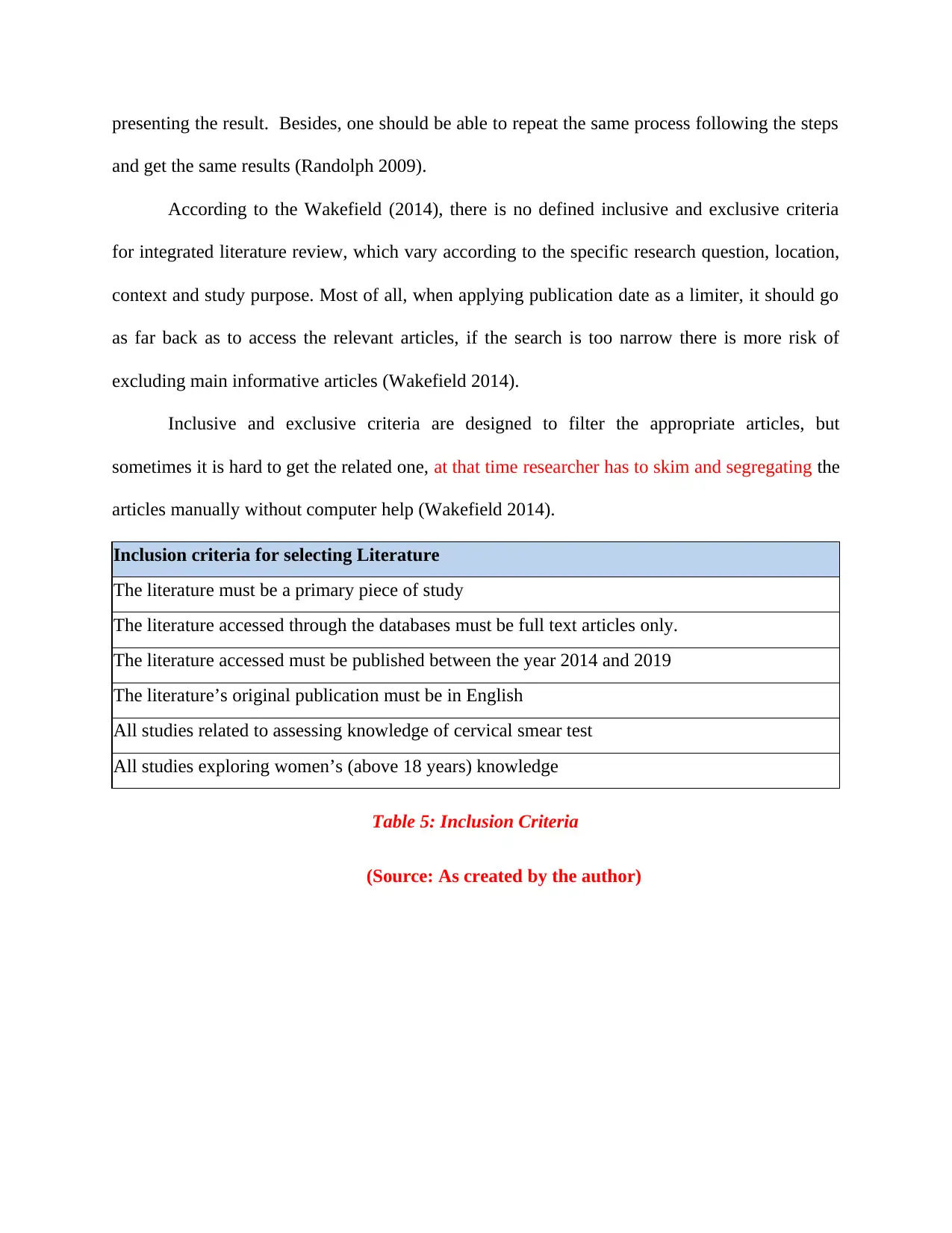
presenting the result. Besides, one should be able to repeat the same process following the steps
and get the same results (Randolph 2009).
According to the Wakefield (2014), there is no defined inclusive and exclusive criteria
for integrated literature review, which vary according to the specific research question, location,
context and study purpose. Most of all, when applying publication date as a limiter, it should go
as far back as to access the relevant articles, if the search is too narrow there is more risk of
excluding main informative articles (Wakefield 2014).
Inclusive and exclusive criteria are designed to filter the appropriate articles, but
sometimes it is hard to get the related one, at that time researcher has to skim and segregating the
articles manually without computer help (Wakefield 2014).
Inclusion criteria for selecting Literature
The literature must be a primary piece of study
The literature accessed through the databases must be full text articles only.
The literature accessed must be published between the year 2014 and 2019
The literature’s original publication must be in English
All studies related to assessing knowledge of cervical smear test
All studies exploring women’s (above 18 years) knowledge
Table 5: Inclusion Criteria
(Source: As created by the author)
and get the same results (Randolph 2009).
According to the Wakefield (2014), there is no defined inclusive and exclusive criteria
for integrated literature review, which vary according to the specific research question, location,
context and study purpose. Most of all, when applying publication date as a limiter, it should go
as far back as to access the relevant articles, if the search is too narrow there is more risk of
excluding main informative articles (Wakefield 2014).
Inclusive and exclusive criteria are designed to filter the appropriate articles, but
sometimes it is hard to get the related one, at that time researcher has to skim and segregating the
articles manually without computer help (Wakefield 2014).
Inclusion criteria for selecting Literature
The literature must be a primary piece of study
The literature accessed through the databases must be full text articles only.
The literature accessed must be published between the year 2014 and 2019
The literature’s original publication must be in English
All studies related to assessing knowledge of cervical smear test
All studies exploring women’s (above 18 years) knowledge
Table 5: Inclusion Criteria
(Source: As created by the author)
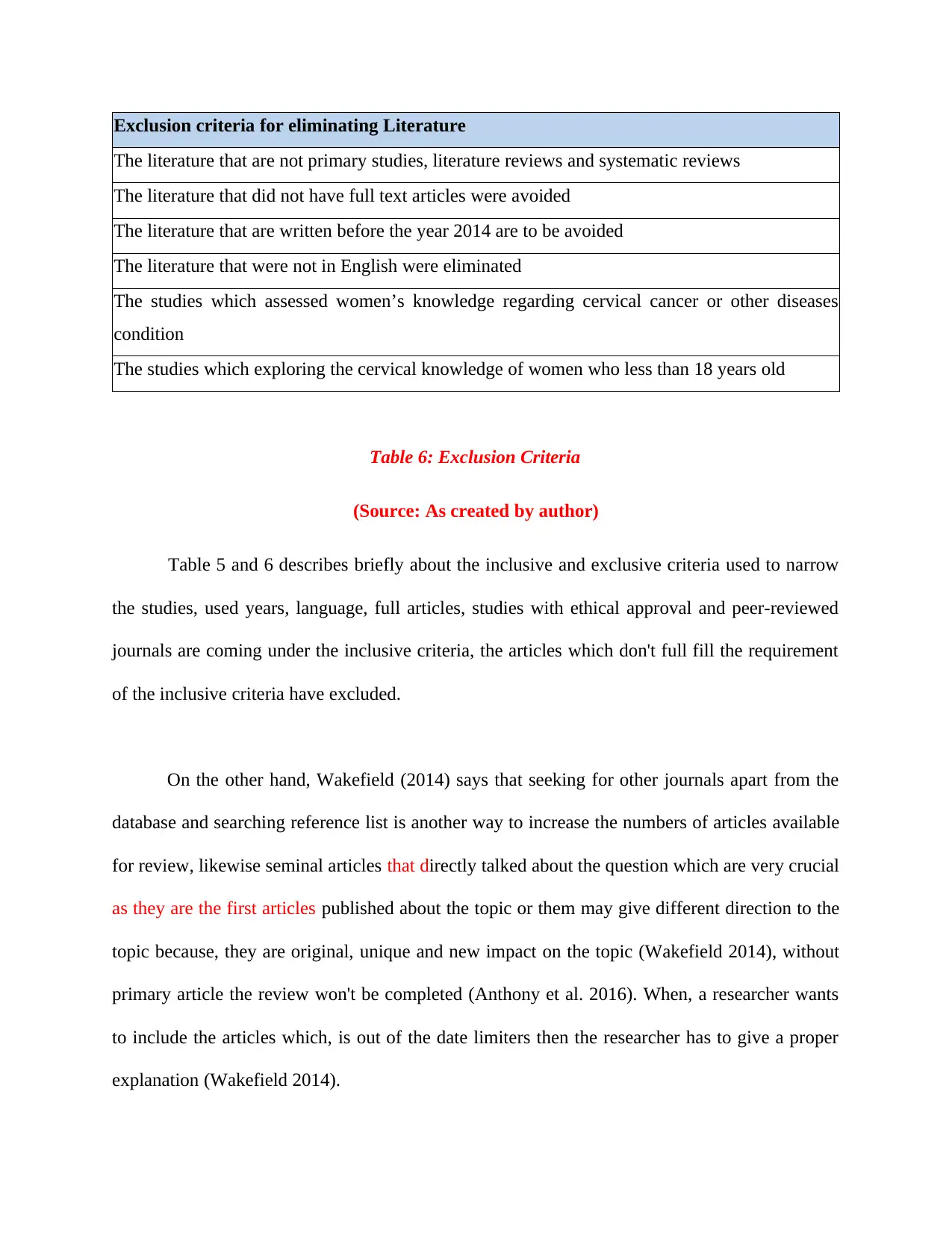
Exclusion criteria for eliminating Literature
The literature that are not primary studies, literature reviews and systematic reviews
The literature that did not have full text articles were avoided
The literature that are written before the year 2014 are to be avoided
The literature that were not in English were eliminated
The studies which assessed women’s knowledge regarding cervical cancer or other diseases
condition
The studies which exploring the cervical knowledge of women who less than 18 years old
Table 6: Exclusion Criteria
(Source: As created by author)
Table 5 and 6 describes briefly about the inclusive and exclusive criteria used to narrow
the studies, used years, language, full articles, studies with ethical approval and peer-reviewed
journals are coming under the inclusive criteria, the articles which don't full fill the requirement
of the inclusive criteria have excluded.
On the other hand, Wakefield (2014) says that seeking for other journals apart from the
database and searching reference list is another way to increase the numbers of articles available
for review, likewise seminal articles that directly talked about the question which are very crucial
as they are the first articles published about the topic or them may give different direction to the
topic because, they are original, unique and new impact on the topic (Wakefield 2014), without
primary article the review won't be completed (Anthony et al. 2016). When, a researcher wants
to include the articles which, is out of the date limiters then the researcher has to give a proper
explanation (Wakefield 2014).
The literature that are not primary studies, literature reviews and systematic reviews
The literature that did not have full text articles were avoided
The literature that are written before the year 2014 are to be avoided
The literature that were not in English were eliminated
The studies which assessed women’s knowledge regarding cervical cancer or other diseases
condition
The studies which exploring the cervical knowledge of women who less than 18 years old
Table 6: Exclusion Criteria
(Source: As created by author)
Table 5 and 6 describes briefly about the inclusive and exclusive criteria used to narrow
the studies, used years, language, full articles, studies with ethical approval and peer-reviewed
journals are coming under the inclusive criteria, the articles which don't full fill the requirement
of the inclusive criteria have excluded.
On the other hand, Wakefield (2014) says that seeking for other journals apart from the
database and searching reference list is another way to increase the numbers of articles available
for review, likewise seminal articles that directly talked about the question which are very crucial
as they are the first articles published about the topic or them may give different direction to the
topic because, they are original, unique and new impact on the topic (Wakefield 2014), without
primary article the review won't be completed (Anthony et al. 2016). When, a researcher wants
to include the articles which, is out of the date limiters then the researcher has to give a proper
explanation (Wakefield 2014).
Secure Best Marks with AI Grader
Need help grading? Try our AI Grader for instant feedback on your assignments.
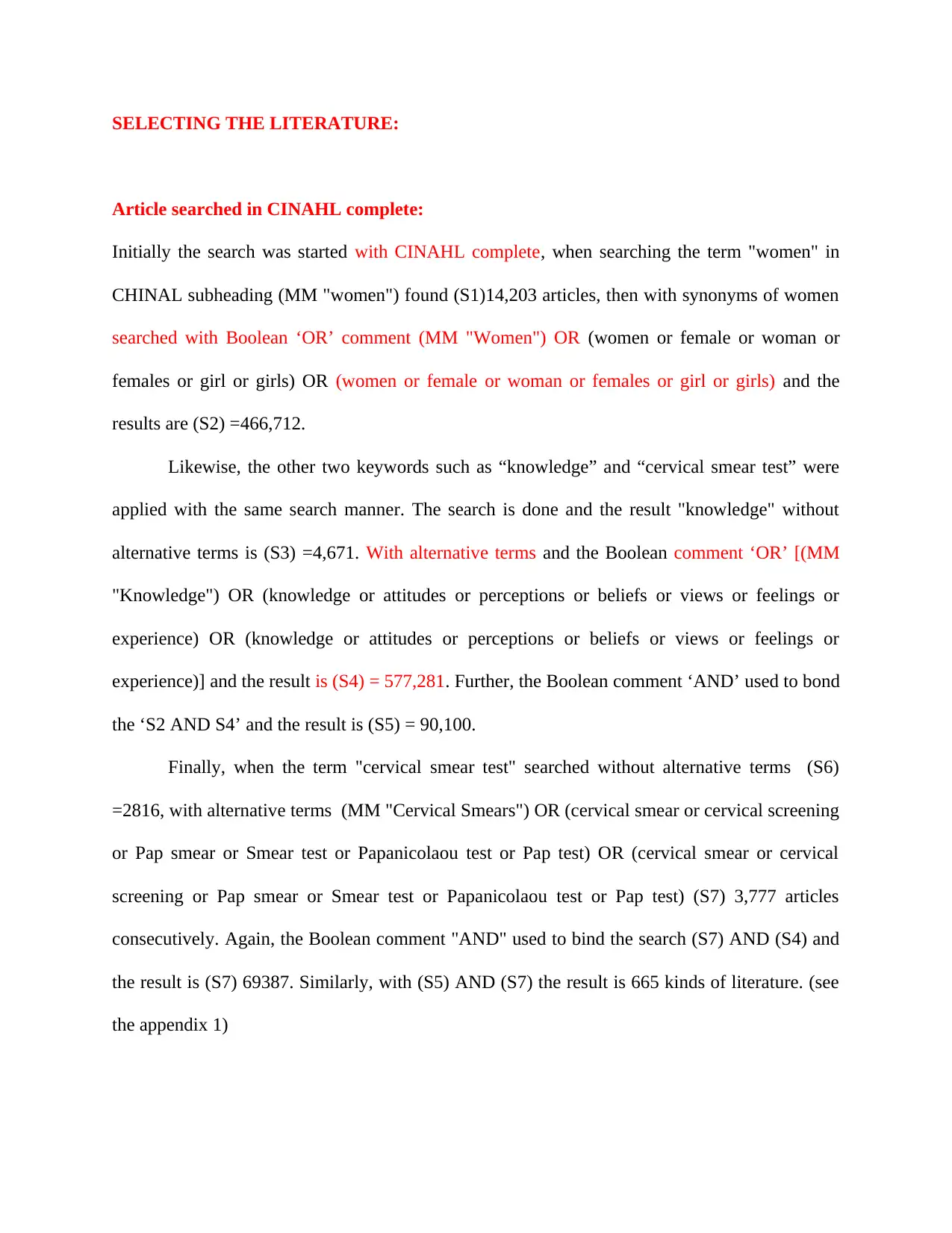
SELECTING THE LITERATURE:
Article searched in CINAHL complete:
Initially the search was started with CINAHL complete, when searching the term "women" in
CHINAL subheading (MM "women") found (S1)14,203 articles, then with synonyms of women
searched with Boolean ‘OR’ comment (MM "Women") OR (women or female or woman or
females or girl or girls) OR (women or female or woman or females or girl or girls) and the
results are (S2) =466,712.
Likewise, the other two keywords such as “knowledge” and “cervical smear test” were
applied with the same search manner. The search is done and the result "knowledge" without
alternative terms is (S3) =4,671. With alternative terms and the Boolean comment ‘OR’ [(MM
"Knowledge") OR (knowledge or attitudes or perceptions or beliefs or views or feelings or
experience) OR (knowledge or attitudes or perceptions or beliefs or views or feelings or
experience)] and the result is (S4) = 577,281. Further, the Boolean comment ‘AND’ used to bond
the ‘S2 AND S4’ and the result is (S5) = 90,100.
Finally, when the term "cervical smear test" searched without alternative terms (S6)
=2816, with alternative terms (MM "Cervical Smears") OR (cervical smear or cervical screening
or Pap smear or Smear test or Papanicolaou test or Pap test) OR (cervical smear or cervical
screening or Pap smear or Smear test or Papanicolaou test or Pap test) (S7) 3,777 articles
consecutively. Again, the Boolean comment "AND" used to bind the search (S7) AND (S4) and
the result is (S7) 69387. Similarly, with (S5) AND (S7) the result is 665 kinds of literature. (see
the appendix 1)
Article searched in CINAHL complete:
Initially the search was started with CINAHL complete, when searching the term "women" in
CHINAL subheading (MM "women") found (S1)14,203 articles, then with synonyms of women
searched with Boolean ‘OR’ comment (MM "Women") OR (women or female or woman or
females or girl or girls) OR (women or female or woman or females or girl or girls) and the
results are (S2) =466,712.
Likewise, the other two keywords such as “knowledge” and “cervical smear test” were
applied with the same search manner. The search is done and the result "knowledge" without
alternative terms is (S3) =4,671. With alternative terms and the Boolean comment ‘OR’ [(MM
"Knowledge") OR (knowledge or attitudes or perceptions or beliefs or views or feelings or
experience) OR (knowledge or attitudes or perceptions or beliefs or views or feelings or
experience)] and the result is (S4) = 577,281. Further, the Boolean comment ‘AND’ used to bond
the ‘S2 AND S4’ and the result is (S5) = 90,100.
Finally, when the term "cervical smear test" searched without alternative terms (S6)
=2816, with alternative terms (MM "Cervical Smears") OR (cervical smear or cervical screening
or Pap smear or Smear test or Papanicolaou test or Pap test) OR (cervical smear or cervical
screening or Pap smear or Smear test or Papanicolaou test or Pap test) (S7) 3,777 articles
consecutively. Again, the Boolean comment "AND" used to bind the search (S7) AND (S4) and
the result is (S7) 69387. Similarly, with (S5) AND (S7) the result is 665 kinds of literature. (see
the appendix 1)
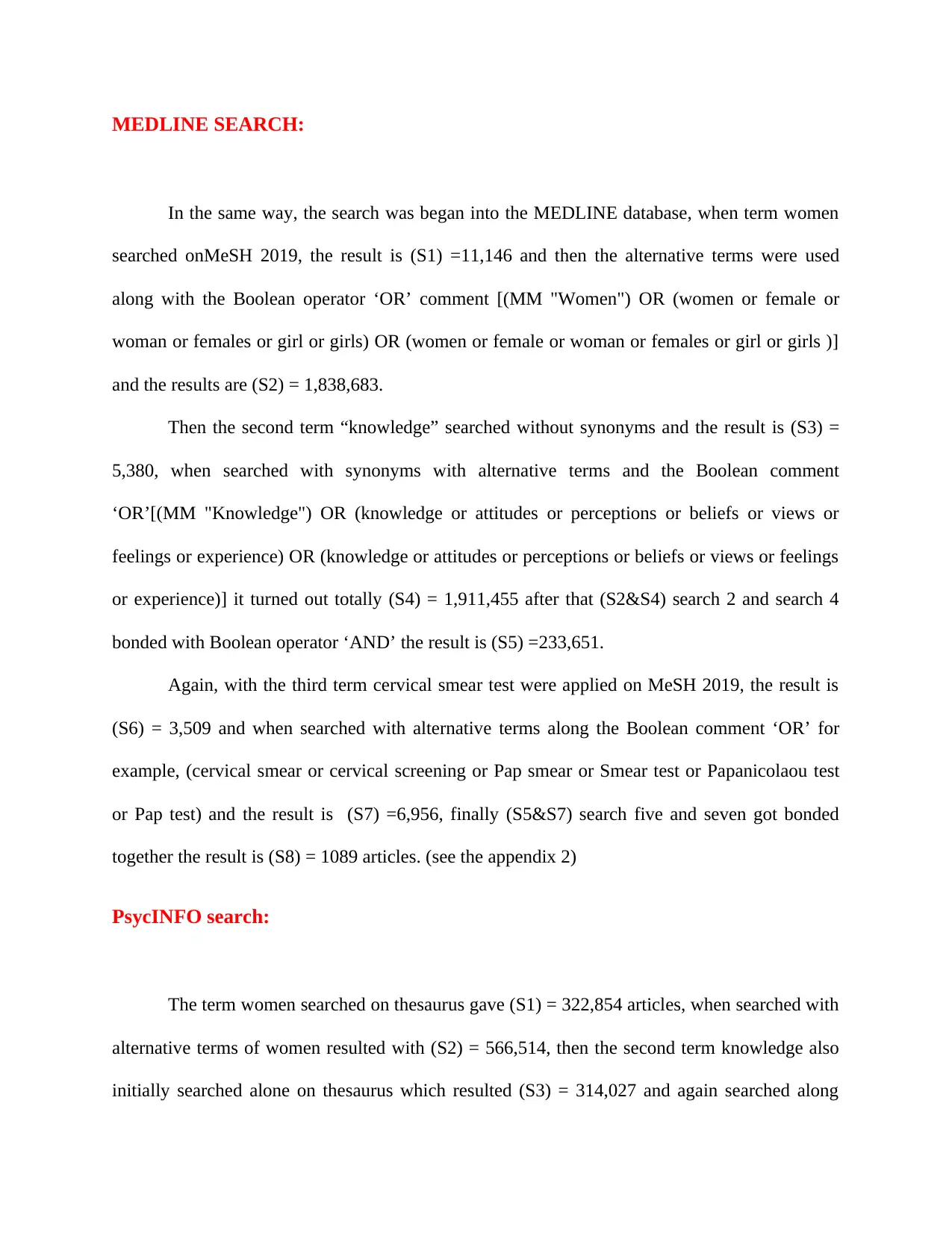
MEDLINE SEARCH:
In the same way, the search was began into the MEDLINE database, when term women
searched onMeSH 2019, the result is (S1) =11,146 and then the alternative terms were used
along with the Boolean operator ‘OR’ comment [(MM "Women") OR (women or female or
woman or females or girl or girls) OR (women or female or woman or females or girl or girls )]
and the results are (S2) = 1,838,683.
Then the second term “knowledge” searched without synonyms and the result is (S3) =
5,380, when searched with synonyms with alternative terms and the Boolean comment
‘OR’[(MM "Knowledge") OR (knowledge or attitudes or perceptions or beliefs or views or
feelings or experience) OR (knowledge or attitudes or perceptions or beliefs or views or feelings
or experience)] it turned out totally (S4) = 1,911,455 after that (S2&S4) search 2 and search 4
bonded with Boolean operator ‘AND’ the result is (S5) =233,651.
Again, with the third term cervical smear test were applied on MeSH 2019, the result is
(S6) = 3,509 and when searched with alternative terms along the Boolean comment ‘OR’ for
example, (cervical smear or cervical screening or Pap smear or Smear test or Papanicolaou test
or Pap test) and the result is (S7) =6,956, finally (S5&S7) search five and seven got bonded
together the result is (S8) = 1089 articles. (see the appendix 2)
PsycINFO search:
The term women searched on thesaurus gave (S1) = 322,854 articles, when searched with
alternative terms of women resulted with (S2) = 566,514, then the second term knowledge also
initially searched alone on thesaurus which resulted (S3) = 314,027 and again searched along
In the same way, the search was began into the MEDLINE database, when term women
searched onMeSH 2019, the result is (S1) =11,146 and then the alternative terms were used
along with the Boolean operator ‘OR’ comment [(MM "Women") OR (women or female or
woman or females or girl or girls) OR (women or female or woman or females or girl or girls )]
and the results are (S2) = 1,838,683.
Then the second term “knowledge” searched without synonyms and the result is (S3) =
5,380, when searched with synonyms with alternative terms and the Boolean comment
‘OR’[(MM "Knowledge") OR (knowledge or attitudes or perceptions or beliefs or views or
feelings or experience) OR (knowledge or attitudes or perceptions or beliefs or views or feelings
or experience)] it turned out totally (S4) = 1,911,455 after that (S2&S4) search 2 and search 4
bonded with Boolean operator ‘AND’ the result is (S5) =233,651.
Again, with the third term cervical smear test were applied on MeSH 2019, the result is
(S6) = 3,509 and when searched with alternative terms along the Boolean comment ‘OR’ for
example, (cervical smear or cervical screening or Pap smear or Smear test or Papanicolaou test
or Pap test) and the result is (S7) =6,956, finally (S5&S7) search five and seven got bonded
together the result is (S8) = 1089 articles. (see the appendix 2)
PsycINFO search:
The term women searched on thesaurus gave (S1) = 322,854 articles, when searched with
alternative terms of women resulted with (S2) = 566,514, then the second term knowledge also
initially searched alone on thesaurus which resulted (S3) = 314,027 and again searched along
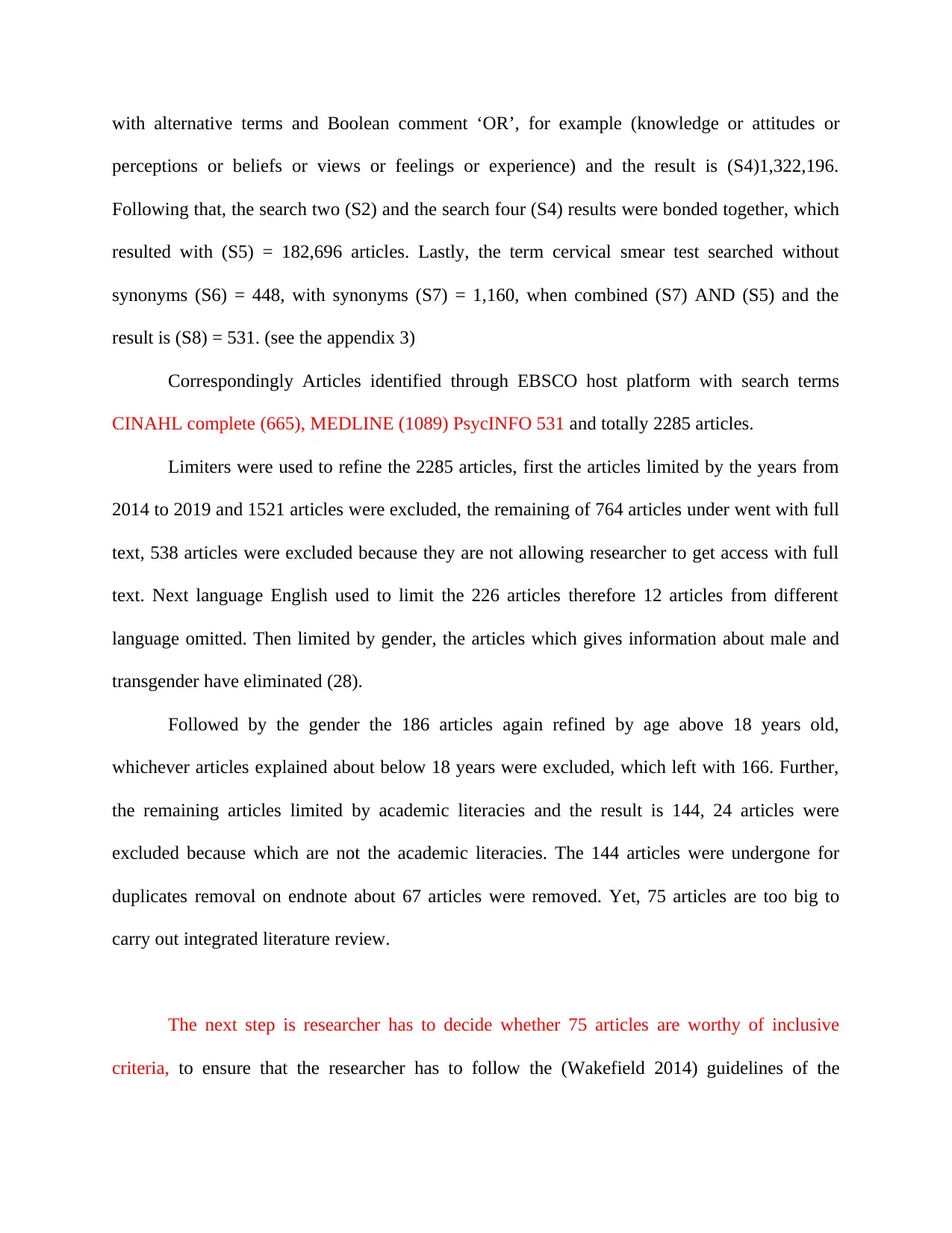
with alternative terms and Boolean comment ‘OR’, for example (knowledge or attitudes or
perceptions or beliefs or views or feelings or experience) and the result is (S4)1,322,196.
Following that, the search two (S2) and the search four (S4) results were bonded together, which
resulted with (S5) = 182,696 articles. Lastly, the term cervical smear test searched without
synonyms (S6) = 448, with synonyms (S7) = 1,160, when combined (S7) AND (S5) and the
result is (S8) = 531. (see the appendix 3)
Correspondingly Articles identified through EBSCO host platform with search terms
CINAHL complete (665), MEDLINE (1089) PsycINFO 531 and totally 2285 articles.
Limiters were used to refine the 2285 articles, first the articles limited by the years from
2014 to 2019 and 1521 articles were excluded, the remaining of 764 articles under went with full
text, 538 articles were excluded because they are not allowing researcher to get access with full
text. Next language English used to limit the 226 articles therefore 12 articles from different
language omitted. Then limited by gender, the articles which gives information about male and
transgender have eliminated (28).
Followed by the gender the 186 articles again refined by age above 18 years old,
whichever articles explained about below 18 years were excluded, which left with 166. Further,
the remaining articles limited by academic literacies and the result is 144, 24 articles were
excluded because which are not the academic literacies. The 144 articles were undergone for
duplicates removal on endnote about 67 articles were removed. Yet, 75 articles are too big to
carry out integrated literature review.
The next step is researcher has to decide whether 75 articles are worthy of inclusive
criteria, to ensure that the researcher has to follow the (Wakefield 2014) guidelines of the
perceptions or beliefs or views or feelings or experience) and the result is (S4)1,322,196.
Following that, the search two (S2) and the search four (S4) results were bonded together, which
resulted with (S5) = 182,696 articles. Lastly, the term cervical smear test searched without
synonyms (S6) = 448, with synonyms (S7) = 1,160, when combined (S7) AND (S5) and the
result is (S8) = 531. (see the appendix 3)
Correspondingly Articles identified through EBSCO host platform with search terms
CINAHL complete (665), MEDLINE (1089) PsycINFO 531 and totally 2285 articles.
Limiters were used to refine the 2285 articles, first the articles limited by the years from
2014 to 2019 and 1521 articles were excluded, the remaining of 764 articles under went with full
text, 538 articles were excluded because they are not allowing researcher to get access with full
text. Next language English used to limit the 226 articles therefore 12 articles from different
language omitted. Then limited by gender, the articles which gives information about male and
transgender have eliminated (28).
Followed by the gender the 186 articles again refined by age above 18 years old,
whichever articles explained about below 18 years were excluded, which left with 166. Further,
the remaining articles limited by academic literacies and the result is 144, 24 articles were
excluded because which are not the academic literacies. The 144 articles were undergone for
duplicates removal on endnote about 67 articles were removed. Yet, 75 articles are too big to
carry out integrated literature review.
The next step is researcher has to decide whether 75 articles are worthy of inclusive
criteria, to ensure that the researcher has to follow the (Wakefield 2014) guidelines of the
Paraphrase This Document
Need a fresh take? Get an instant paraphrase of this document with our AI Paraphraser
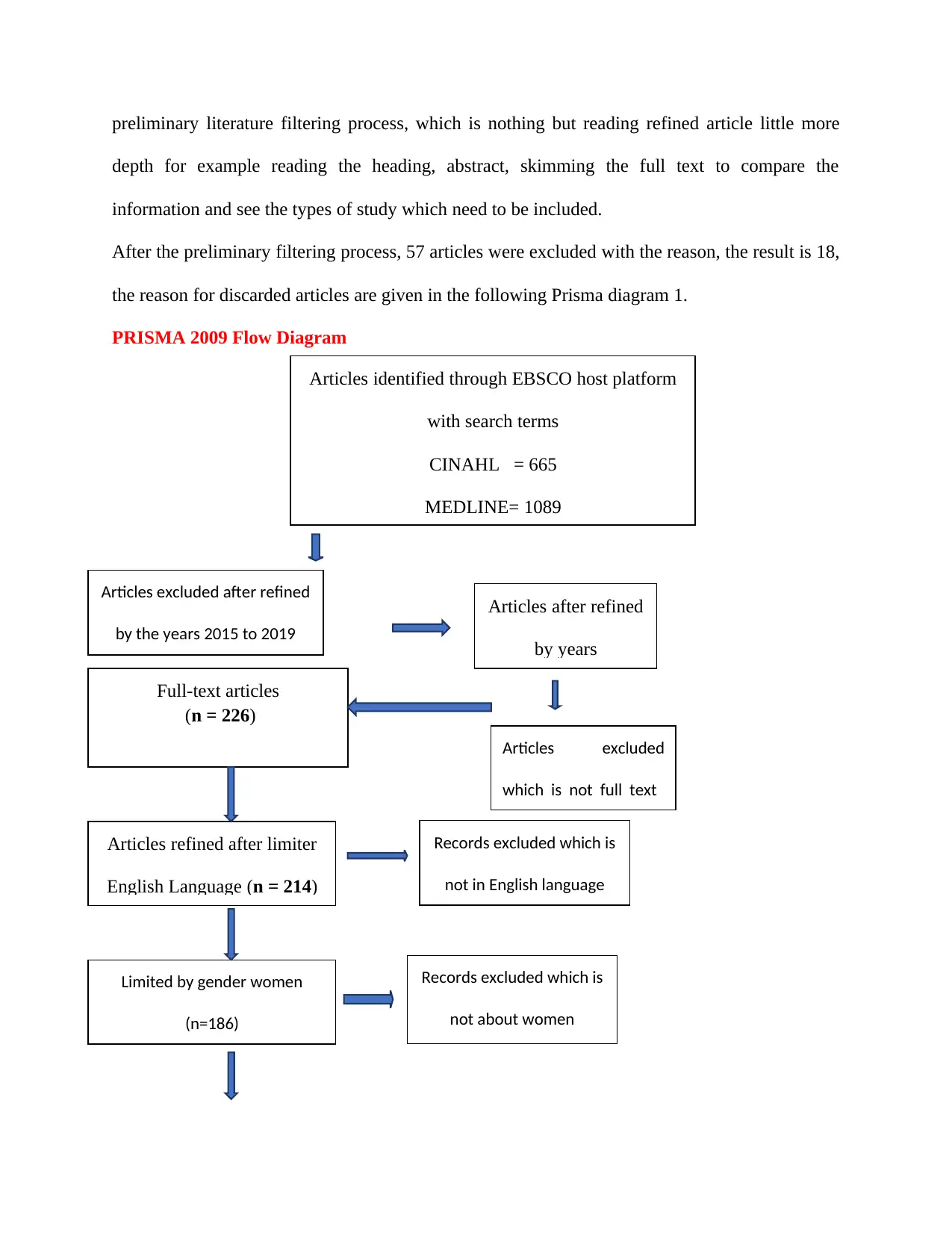
preliminary literature filtering process, which is nothing but reading refined article little more
depth for example reading the heading, abstract, skimming the full text to compare the
information and see the types of study which need to be included.
After the preliminary filtering process, 57 articles were excluded with the reason, the result is 18,
the reason for discarded articles are given in the following Prisma diagram 1.
PRISMA 2009 Flow Diagram
Articles identified through EBSCO host platform
with search terms
CINAHL = 665
MEDLINE= 1089
Articles excluded after refined
by the years 2015 to 2019
Articles after refined
by years
Full-text articles
(n = 226)
Records excluded which is
not in English language
Articles refined after limiter
English Language (n = 214)
Articles excluded
which is not full text
Limited by gender women
(n=186)
Records excluded which is
not about women
(n =28)
depth for example reading the heading, abstract, skimming the full text to compare the
information and see the types of study which need to be included.
After the preliminary filtering process, 57 articles were excluded with the reason, the result is 18,
the reason for discarded articles are given in the following Prisma diagram 1.
PRISMA 2009 Flow Diagram
Articles identified through EBSCO host platform
with search terms
CINAHL = 665
MEDLINE= 1089
Articles excluded after refined
by the years 2015 to 2019
Articles after refined
by years
Full-text articles
(n = 226)
Records excluded which is
not in English language
Articles refined after limiter
English Language (n = 214)
Articles excluded
which is not full text
Limited by gender women
(n=186)
Records excluded which is
not about women
(n =28)
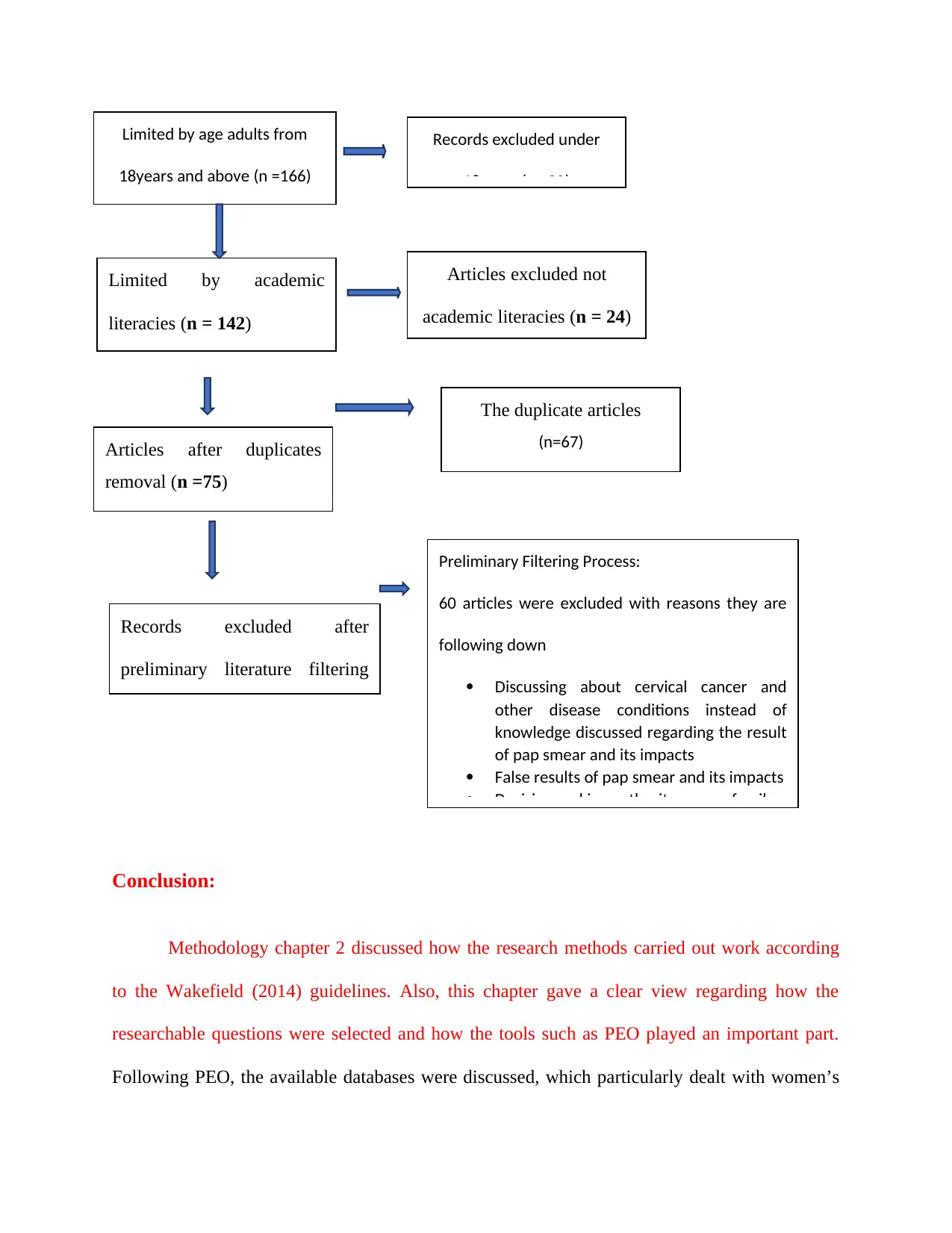
Conclusion:
Methodology chapter 2 discussed how the research methods carried out work according
to the Wakefield (2014) guidelines. Also, this chapter gave a clear view regarding how the
researchable questions were selected and how the tools such as PEO played an important part.
Following PEO, the available databases were discussed, which particularly dealt with women’s
Limited by age adults from
18years and above (n =166)
Limited by academic
literacies (n = 142)
Records excluded under
18years (n =20)
Articles after duplicates
removal (n =75)
Articles excluded not
academic literacies (n = 24)
Records excluded after
preliminary literature filtering
process (n = 15)
The duplicate articles
(n=67)
Preliminary Filtering Process:
60 articles were excluded with reasons they are
following down
Discussing about cervical cancer and
other disease conditions instead of
knowledge discussed regarding the result
of pap smear and its impacts
False results of pap smear and its impacts
Decision making authority among family
Methodology chapter 2 discussed how the research methods carried out work according
to the Wakefield (2014) guidelines. Also, this chapter gave a clear view regarding how the
researchable questions were selected and how the tools such as PEO played an important part.
Following PEO, the available databases were discussed, which particularly dealt with women’s
Limited by age adults from
18years and above (n =166)
Limited by academic
literacies (n = 142)
Records excluded under
18years (n =20)
Articles after duplicates
removal (n =75)
Articles excluded not
academic literacies (n = 24)
Records excluded after
preliminary literature filtering
process (n = 15)
The duplicate articles
(n=67)
Preliminary Filtering Process:
60 articles were excluded with reasons they are
following down
Discussing about cervical cancer and
other disease conditions instead of
knowledge discussed regarding the result
of pap smear and its impacts
False results of pap smear and its impacts
Decision making authority among family
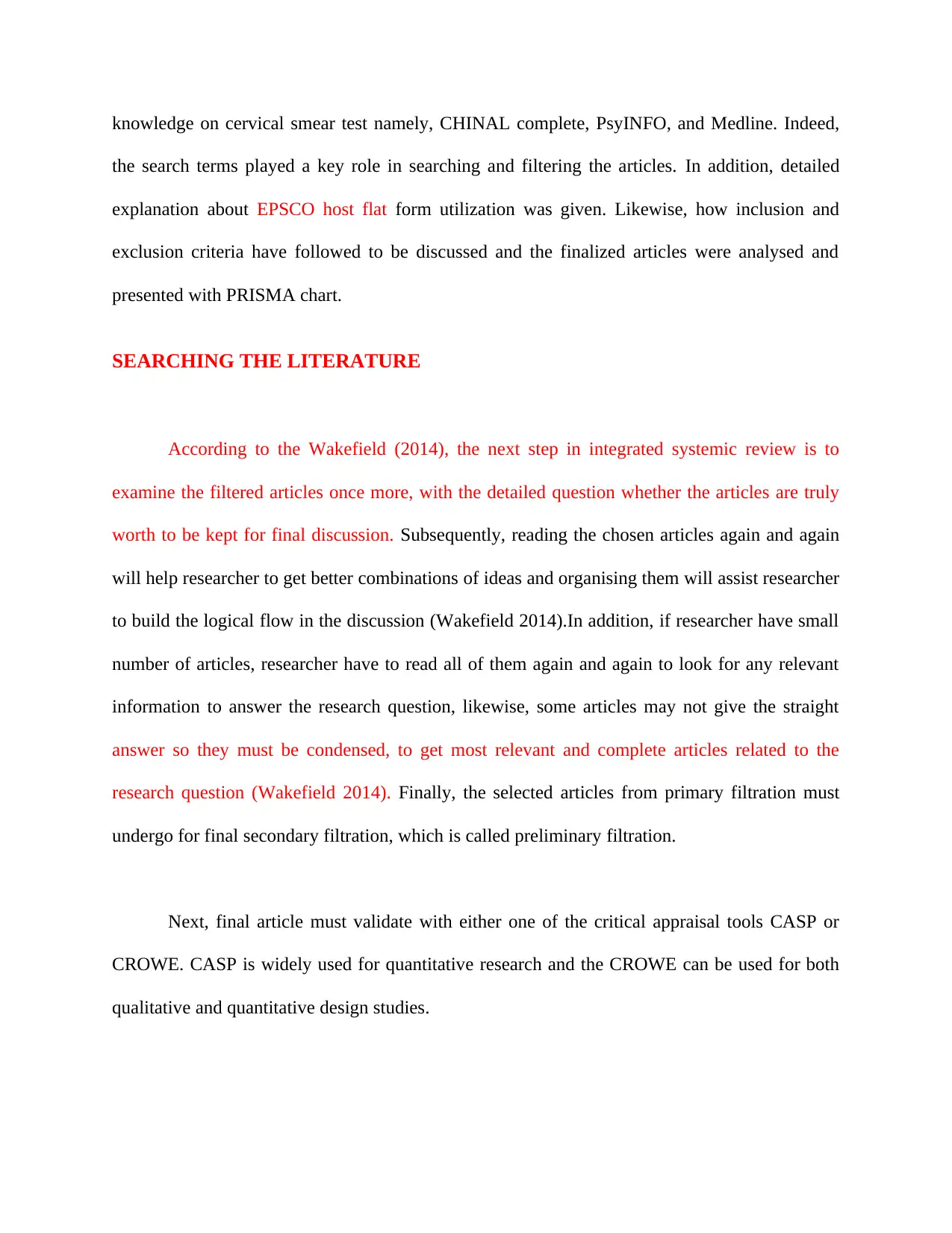
knowledge on cervical smear test namely, CHINAL complete, PsyINFO, and Medline. Indeed,
the search terms played a key role in searching and filtering the articles. In addition, detailed
explanation about EPSCO host flat form utilization was given. Likewise, how inclusion and
exclusion criteria have followed to be discussed and the finalized articles were analysed and
presented with PRISMA chart.
SEARCHING THE LITERATURE
According to the Wakefield (2014), the next step in integrated systemic review is to
examine the filtered articles once more, with the detailed question whether the articles are truly
worth to be kept for final discussion. Subsequently, reading the chosen articles again and again
will help researcher to get better combinations of ideas and organising them will assist researcher
to build the logical flow in the discussion (Wakefield 2014).In addition, if researcher have small
number of articles, researcher have to read all of them again and again to look for any relevant
information to answer the research question, likewise, some articles may not give the straight
answer so they must be condensed, to get most relevant and complete articles related to the
research question (Wakefield 2014). Finally, the selected articles from primary filtration must
undergo for final secondary filtration, which is called preliminary filtration.
Next, final article must validate with either one of the critical appraisal tools CASP or
CROWE. CASP is widely used for quantitative research and the CROWE can be used for both
qualitative and quantitative design studies.
the search terms played a key role in searching and filtering the articles. In addition, detailed
explanation about EPSCO host flat form utilization was given. Likewise, how inclusion and
exclusion criteria have followed to be discussed and the finalized articles were analysed and
presented with PRISMA chart.
SEARCHING THE LITERATURE
According to the Wakefield (2014), the next step in integrated systemic review is to
examine the filtered articles once more, with the detailed question whether the articles are truly
worth to be kept for final discussion. Subsequently, reading the chosen articles again and again
will help researcher to get better combinations of ideas and organising them will assist researcher
to build the logical flow in the discussion (Wakefield 2014).In addition, if researcher have small
number of articles, researcher have to read all of them again and again to look for any relevant
information to answer the research question, likewise, some articles may not give the straight
answer so they must be condensed, to get most relevant and complete articles related to the
research question (Wakefield 2014). Finally, the selected articles from primary filtration must
undergo for final secondary filtration, which is called preliminary filtration.
Next, final article must validate with either one of the critical appraisal tools CASP or
CROWE. CASP is widely used for quantitative research and the CROWE can be used for both
qualitative and quantitative design studies.
Secure Best Marks with AI Grader
Need help grading? Try our AI Grader for instant feedback on your assignments.
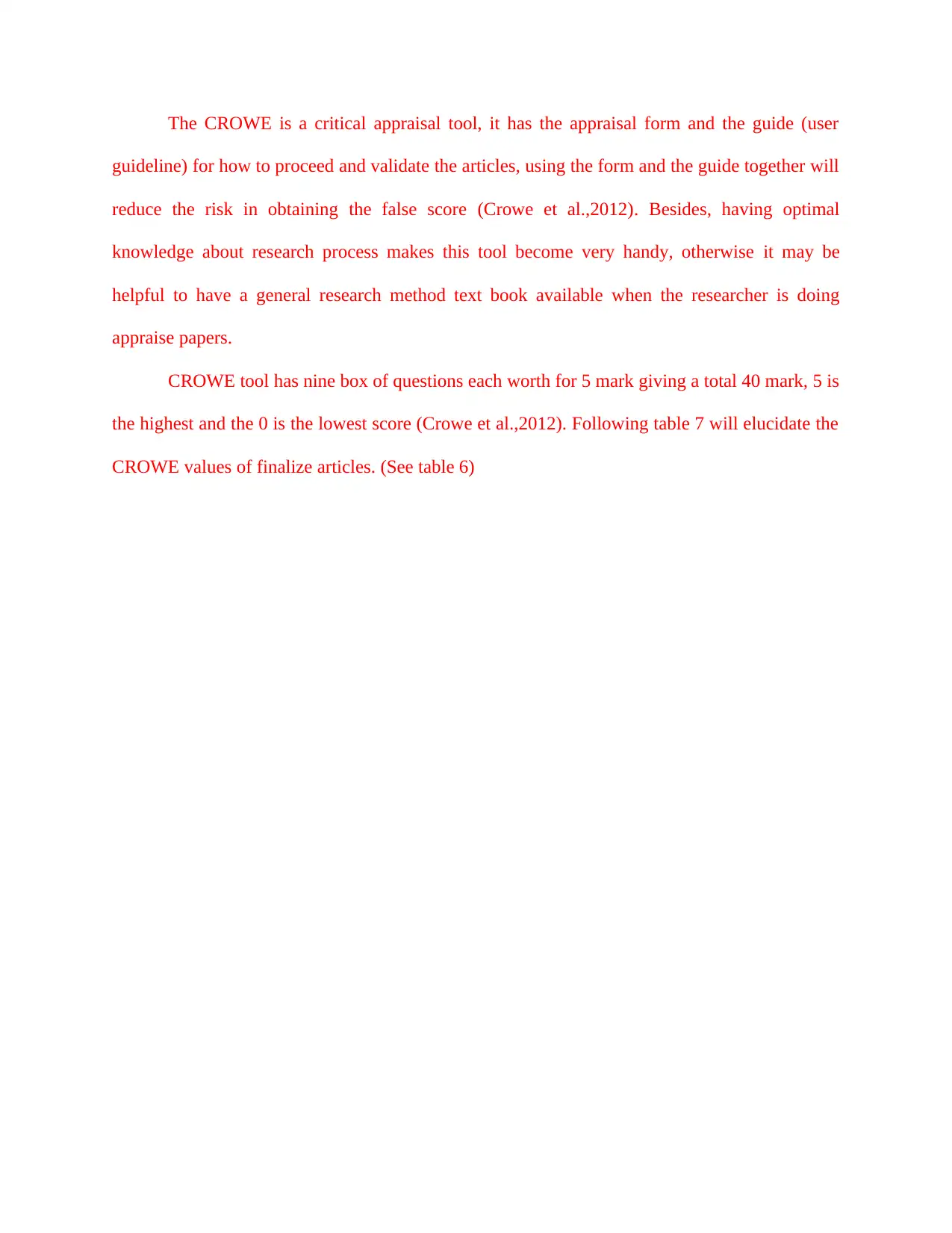
The CROWE is a critical appraisal tool, it has the appraisal form and the guide (user
guideline) for how to proceed and validate the articles, using the form and the guide together will
reduce the risk in obtaining the false score (Crowe et al.,2012). Besides, having optimal
knowledge about research process makes this tool become very handy, otherwise it may be
helpful to have a general research method text book available when the researcher is doing
appraise papers.
CROWE tool has nine box of questions each worth for 5 mark giving a total 40 mark, 5 is
the highest and the 0 is the lowest score (Crowe et al.,2012). Following table 7 will elucidate the
CROWE values of finalize articles. (See table 6)
guideline) for how to proceed and validate the articles, using the form and the guide together will
reduce the risk in obtaining the false score (Crowe et al.,2012). Besides, having optimal
knowledge about research process makes this tool become very handy, otherwise it may be
helpful to have a general research method text book available when the researcher is doing
appraise papers.
CROWE tool has nine box of questions each worth for 5 mark giving a total 40 mark, 5 is
the highest and the 0 is the lowest score (Crowe et al.,2012). Following table 7 will elucidate the
CROWE values of finalize articles. (See table 6)
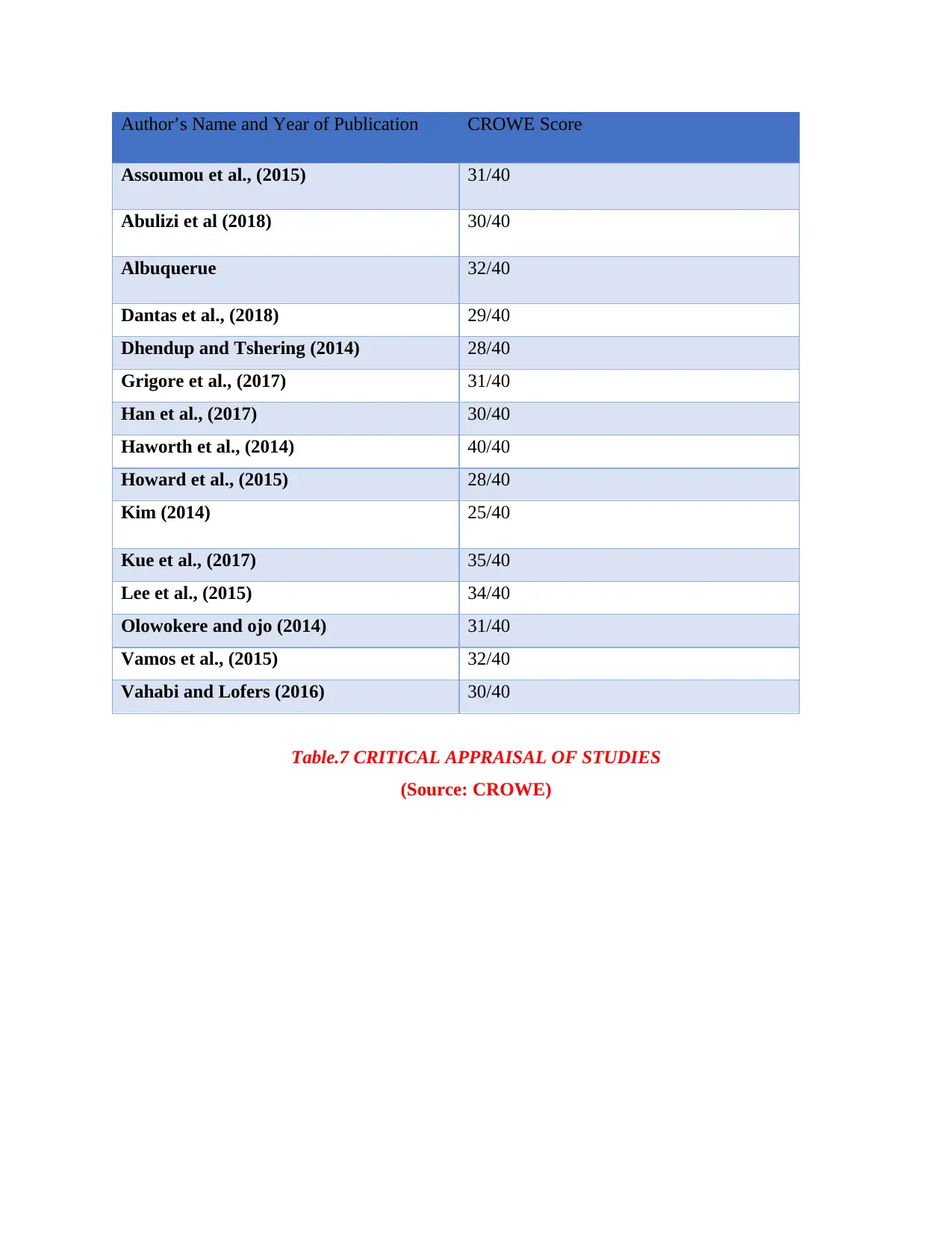
Author’s Name and Year of Publication CROWE Score
Assoumou et al., (2015) 31/40
Abulizi et al (2018) 30/40
Albuquerue 32/40
Dantas et al., (2018) 29/40
Dhendup and Tshering (2014) 28/40
Grigore et al., (2017) 31/40
Han et al., (2017) 30/40
Haworth et al., (2014) 40/40
Howard et al., (2015) 28/40
Kim (2014) 25/40
Kue et al., (2017) 35/40
Lee et al., (2015) 34/40
Olowokere and ojo (2014) 31/40
Vamos et al., (2015) 32/40
Vahabi and Lofers (2016) 30/40
Table.7 CRITICAL APPRAISAL OF STUDIES
(Source: CROWE)
Assoumou et al., (2015) 31/40
Abulizi et al (2018) 30/40
Albuquerue 32/40
Dantas et al., (2018) 29/40
Dhendup and Tshering (2014) 28/40
Grigore et al., (2017) 31/40
Han et al., (2017) 30/40
Haworth et al., (2014) 40/40
Howard et al., (2015) 28/40
Kim (2014) 25/40
Kue et al., (2017) 35/40
Lee et al., (2015) 34/40
Olowokere and ojo (2014) 31/40
Vamos et al., (2015) 32/40
Vahabi and Lofers (2016) 30/40
Table.7 CRITICAL APPRAISAL OF STUDIES
(Source: CROWE)
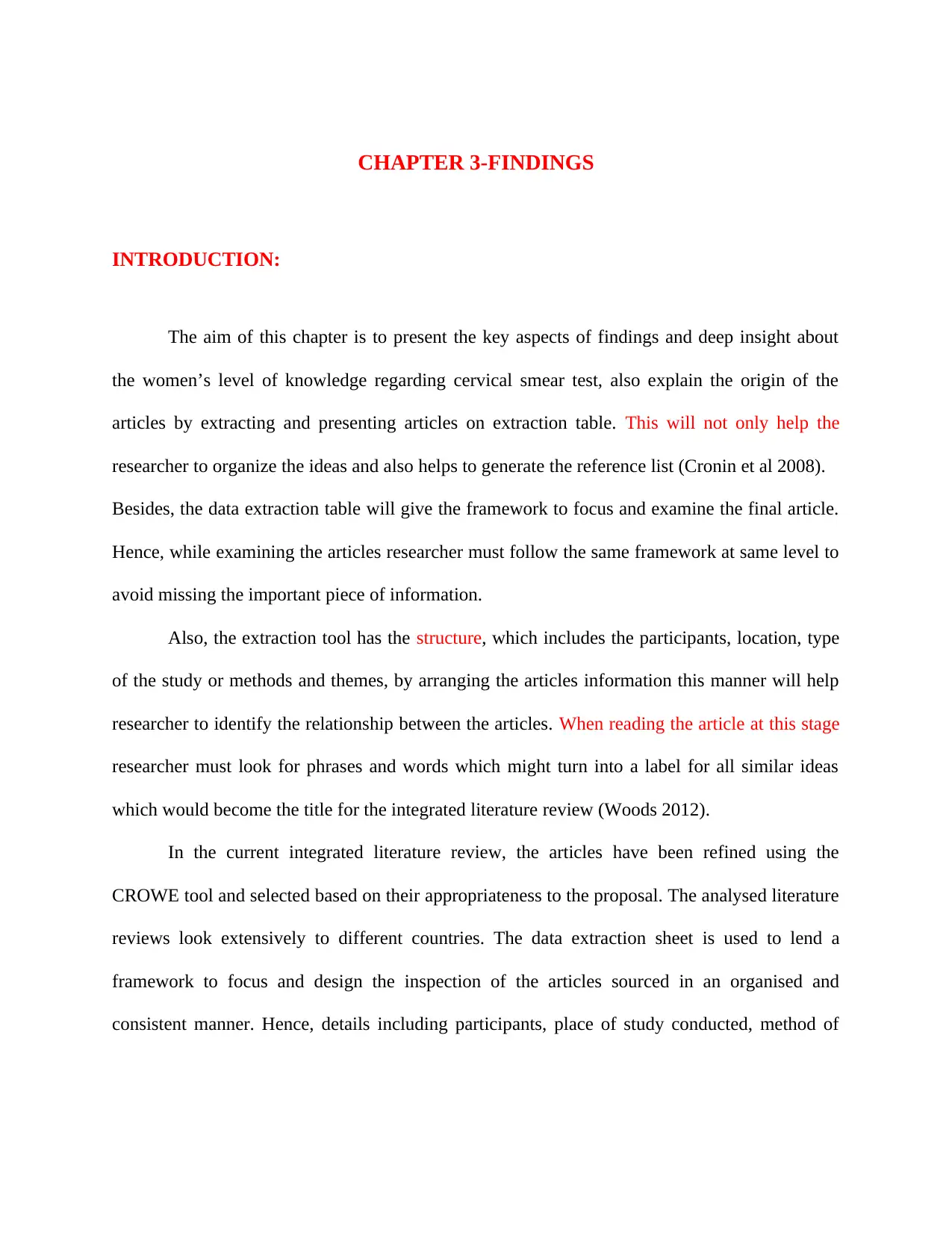
CHAPTER 3-FINDINGS
INTRODUCTION:
The aim of this chapter is to present the key aspects of findings and deep insight about
the women’s level of knowledge regarding cervical smear test, also explain the origin of the
articles by extracting and presenting articles on extraction table. This will not only help the
researcher to organize the ideas and also helps to generate the reference list (Cronin et al 2008).
Besides, the data extraction table will give the framework to focus and examine the final article.
Hence, while examining the articles researcher must follow the same framework at same level to
avoid missing the important piece of information.
Also, the extraction tool has the structure, which includes the participants, location, type
of the study or methods and themes, by arranging the articles information this manner will help
researcher to identify the relationship between the articles. When reading the article at this stage
researcher must look for phrases and words which might turn into a label for all similar ideas
which would become the title for the integrated literature review (Woods 2012).
In the current integrated literature review, the articles have been refined using the
CROWE tool and selected based on their appropriateness to the proposal. The analysed literature
reviews look extensively to different countries. The data extraction sheet is used to lend a
framework to focus and design the inspection of the articles sourced in an organised and
consistent manner. Hence, details including participants, place of study conducted, method of
INTRODUCTION:
The aim of this chapter is to present the key aspects of findings and deep insight about
the women’s level of knowledge regarding cervical smear test, also explain the origin of the
articles by extracting and presenting articles on extraction table. This will not only help the
researcher to organize the ideas and also helps to generate the reference list (Cronin et al 2008).
Besides, the data extraction table will give the framework to focus and examine the final article.
Hence, while examining the articles researcher must follow the same framework at same level to
avoid missing the important piece of information.
Also, the extraction tool has the structure, which includes the participants, location, type
of the study or methods and themes, by arranging the articles information this manner will help
researcher to identify the relationship between the articles. When reading the article at this stage
researcher must look for phrases and words which might turn into a label for all similar ideas
which would become the title for the integrated literature review (Woods 2012).
In the current integrated literature review, the articles have been refined using the
CROWE tool and selected based on their appropriateness to the proposal. The analysed literature
reviews look extensively to different countries. The data extraction sheet is used to lend a
framework to focus and design the inspection of the articles sourced in an organised and
consistent manner. Hence, details including participants, place of study conducted, method of
Paraphrase This Document
Need a fresh take? Get an instant paraphrase of this document with our AI Paraphraser
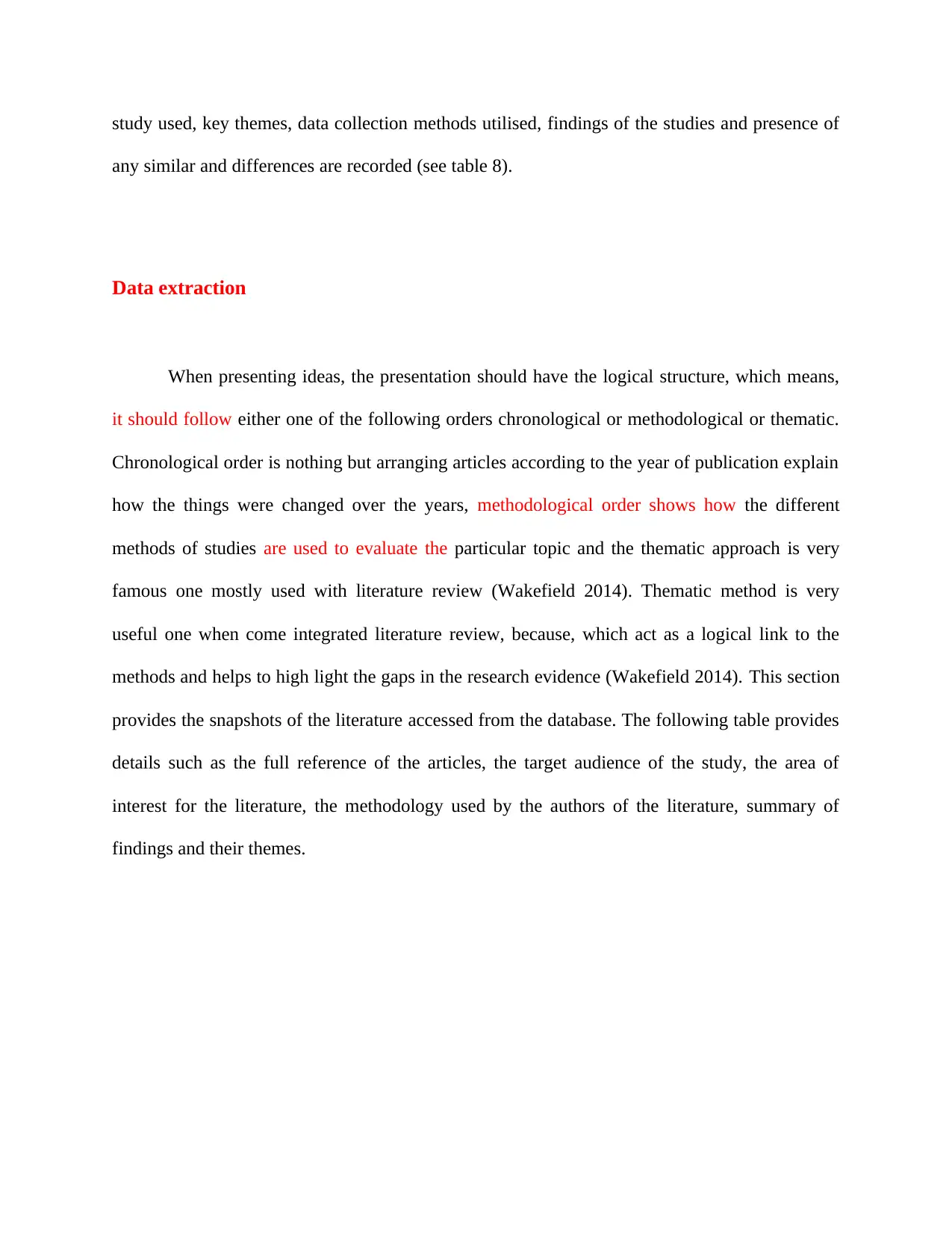
study used, key themes, data collection methods utilised, findings of the studies and presence of
any similar and differences are recorded (see table 8).
Data extraction
When presenting ideas, the presentation should have the logical structure, which means,
it should follow either one of the following orders chronological or methodological or thematic.
Chronological order is nothing but arranging articles according to the year of publication explain
how the things were changed over the years, methodological order shows how the different
methods of studies are used to evaluate the particular topic and the thematic approach is very
famous one mostly used with literature review (Wakefield 2014). Thematic method is very
useful one when come integrated literature review, because, which act as a logical link to the
methods and helps to high light the gaps in the research evidence (Wakefield 2014). This section
provides the snapshots of the literature accessed from the database. The following table provides
details such as the full reference of the articles, the target audience of the study, the area of
interest for the literature, the methodology used by the authors of the literature, summary of
findings and their themes.
any similar and differences are recorded (see table 8).
Data extraction
When presenting ideas, the presentation should have the logical structure, which means,
it should follow either one of the following orders chronological or methodological or thematic.
Chronological order is nothing but arranging articles according to the year of publication explain
how the things were changed over the years, methodological order shows how the different
methods of studies are used to evaluate the particular topic and the thematic approach is very
famous one mostly used with literature review (Wakefield 2014). Thematic method is very
useful one when come integrated literature review, because, which act as a logical link to the
methods and helps to high light the gaps in the research evidence (Wakefield 2014). This section
provides the snapshots of the literature accessed from the database. The following table provides
details such as the full reference of the articles, the target audience of the study, the area of
interest for the literature, the methodology used by the authors of the literature, summary of
findings and their themes.
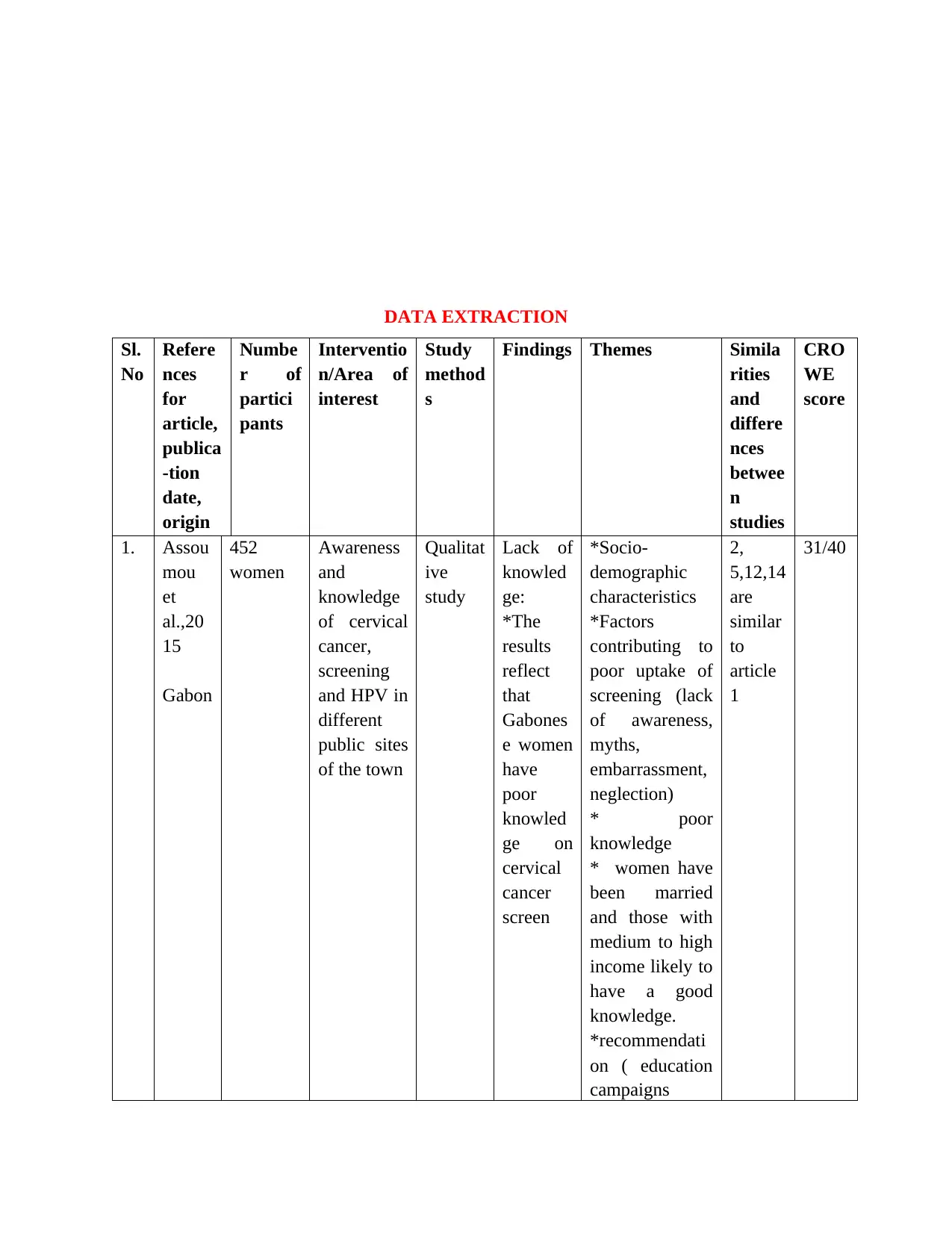
DATA EXTRACTION
Sl.
No
Refere
nces
for
article,
publica
-tion
date,
origin
Numbe
r of
partici
pants
Interventio
n/Area of
interest
Study
method
s
Findings Themes Simila
rities
and
differe
nces
betwee
n
studies
CRO
WE
score
1. Assou
mou
et
al.,20
15
Gabon
452
women
Awareness
and
knowledge
of cervical
cancer,
screening
and HPV in
different
public sites
of the town
Qualitat
ive
study
Lack of
knowled
ge:
*The
results
reflect
that
Gabones
e women
have
poor
knowled
ge on
cervical
cancer
screen
*Socio-
demographic
characteristics
*Factors
contributing to
poor uptake of
screening (lack
of awareness,
myths,
embarrassment,
neglection)
* poor
knowledge
* women have
been married
and those with
medium to high
income likely to
have a good
knowledge.
*recommendati
on ( education
campaigns
2,
5,12,14
are
similar
to
article
1
31/40
Sl.
No
Refere
nces
for
article,
publica
-tion
date,
origin
Numbe
r of
partici
pants
Interventio
n/Area of
interest
Study
method
s
Findings Themes Simila
rities
and
differe
nces
betwee
n
studies
CRO
WE
score
1. Assou
mou
et
al.,20
15
Gabon
452
women
Awareness
and
knowledge
of cervical
cancer,
screening
and HPV in
different
public sites
of the town
Qualitat
ive
study
Lack of
knowled
ge:
*The
results
reflect
that
Gabones
e women
have
poor
knowled
ge on
cervical
cancer
screen
*Socio-
demographic
characteristics
*Factors
contributing to
poor uptake of
screening (lack
of awareness,
myths,
embarrassment,
neglection)
* poor
knowledge
* women have
been married
and those with
medium to high
income likely to
have a good
knowledge.
*recommendati
on ( education
campaigns
2,
5,12,14
are
similar
to
article
1
31/40
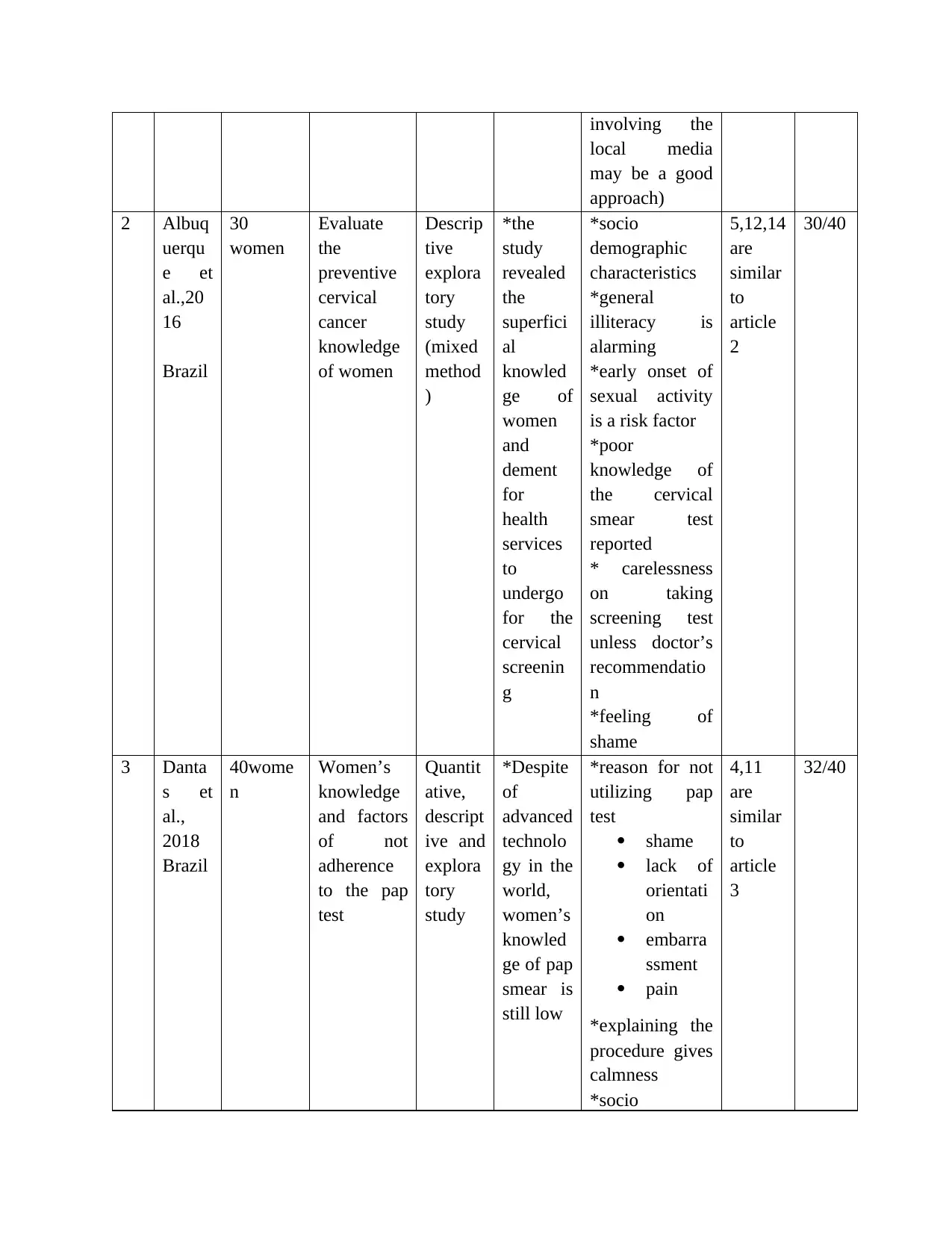
involving the
local media
may be a good
approach)
2 Albuq
uerqu
e et
al.,20
16
Brazil
30
women
Evaluate
the
preventive
cervical
cancer
knowledge
of women
Descrip
tive
explora
tory
study
(mixed
method
)
*the
study
revealed
the
superfici
al
knowled
ge of
women
and
dement
for
health
services
to
undergo
for the
cervical
screenin
g
*socio
demographic
characteristics
*general
illiteracy is
alarming
*early onset of
sexual activity
is a risk factor
*poor
knowledge of
the cervical
smear test
reported
* carelessness
on taking
screening test
unless doctor’s
recommendatio
n
*feeling of
shame
5,12,14
are
similar
to
article
2
30/40
3 Danta
s et
al.,
2018
Brazil
40wome
n
Women’s
knowledge
and factors
of not
adherence
to the pap
test
Quantit
ative,
descript
ive and
explora
tory
study
*Despite
of
advanced
technolo
gy in the
world,
women’s
knowled
ge of pap
smear is
still low
*reason for not
utilizing pap
test
shame
lack of
orientati
on
embarra
ssment
pain
*explaining the
procedure gives
calmness
*socio
4,11
are
similar
to
article
3
32/40
local media
may be a good
approach)
2 Albuq
uerqu
e et
al.,20
16
Brazil
30
women
Evaluate
the
preventive
cervical
cancer
knowledge
of women
Descrip
tive
explora
tory
study
(mixed
method
)
*the
study
revealed
the
superfici
al
knowled
ge of
women
and
dement
for
health
services
to
undergo
for the
cervical
screenin
g
*socio
demographic
characteristics
*general
illiteracy is
alarming
*early onset of
sexual activity
is a risk factor
*poor
knowledge of
the cervical
smear test
reported
* carelessness
on taking
screening test
unless doctor’s
recommendatio
n
*feeling of
shame
5,12,14
are
similar
to
article
2
30/40
3 Danta
s et
al.,
2018
Brazil
40wome
n
Women’s
knowledge
and factors
of not
adherence
to the pap
test
Quantit
ative,
descript
ive and
explora
tory
study
*Despite
of
advanced
technolo
gy in the
world,
women’s
knowled
ge of pap
smear is
still low
*reason for not
utilizing pap
test
shame
lack of
orientati
on
embarra
ssment
pain
*explaining the
procedure gives
calmness
*socio
4,11
are
similar
to
article
3
32/40
Secure Best Marks with AI Grader
Need help grading? Try our AI Grader for instant feedback on your assignments.
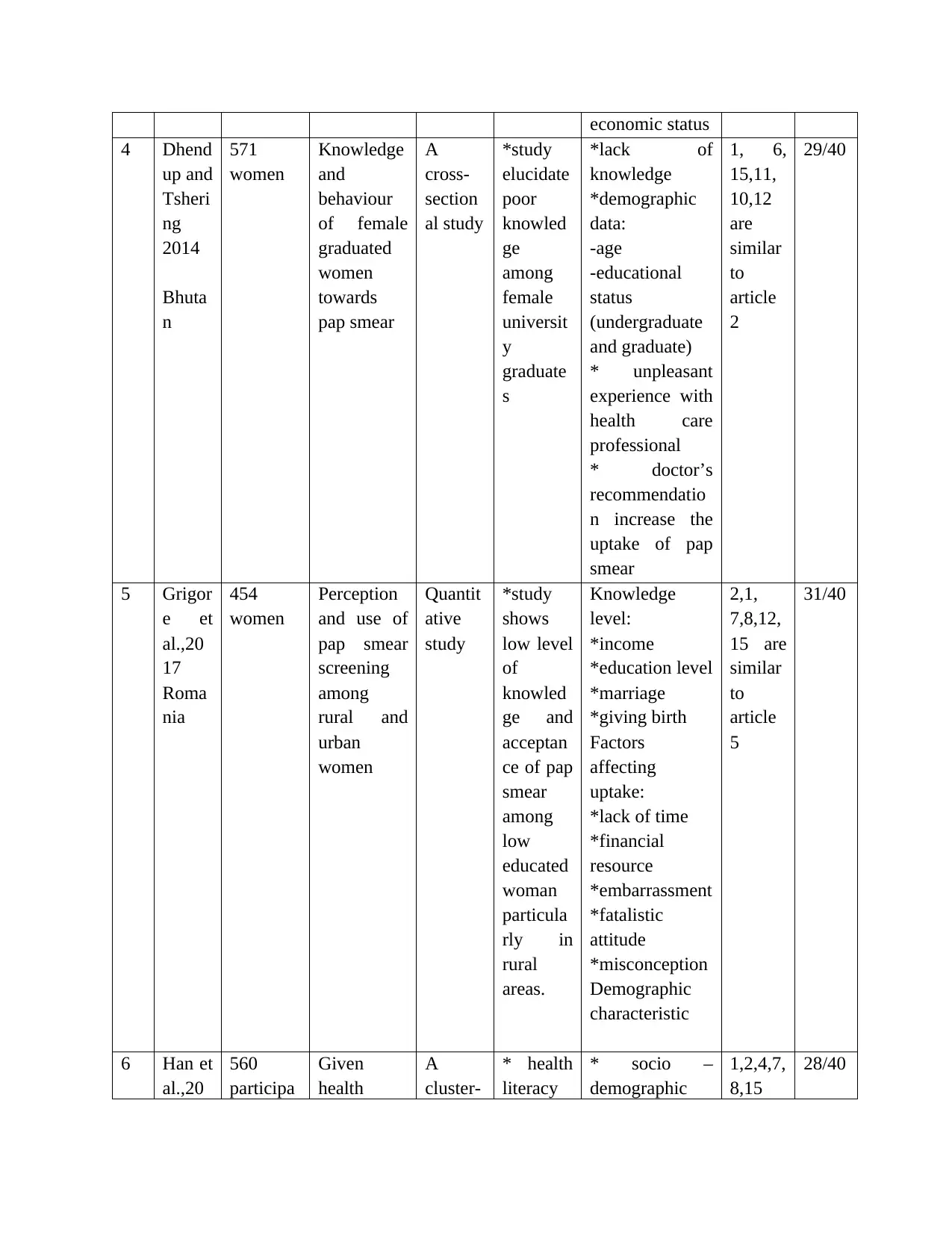
economic status
4 Dhend
up and
Tsheri
ng
2014
Bhuta
n
571
women
Knowledge
and
behaviour
of female
graduated
women
towards
pap smear
A
cross-
section
al study
*study
elucidate
poor
knowled
ge
among
female
universit
y
graduate
s
*lack of
knowledge
*demographic
data:
-age
-educational
status
(undergraduate
and graduate)
* unpleasant
experience with
health care
professional
* doctor’s
recommendatio
n increase the
uptake of pap
smear
1, 6,
15,11,
10,12
are
similar
to
article
2
29/40
5 Grigor
e et
al.,20
17
Roma
nia
454
women
Perception
and use of
pap smear
screening
among
rural and
urban
women
Quantit
ative
study
*study
shows
low level
of
knowled
ge and
acceptan
ce of pap
smear
among
low
educated
woman
particula
rly in
rural
areas.
Knowledge
level:
*income
*education level
*marriage
*giving birth
Factors
affecting
uptake:
*lack of time
*financial
resource
*embarrassment
*fatalistic
attitude
*misconception
Demographic
characteristic
2,1,
7,8,12,
15 are
similar
to
article
5
31/40
6 Han et
al.,20
560
participa
Given
health
A
cluster-
* health
literacy
* socio –
demographic
1,2,4,7,
8,15
28/40
4 Dhend
up and
Tsheri
ng
2014
Bhuta
n
571
women
Knowledge
and
behaviour
of female
graduated
women
towards
pap smear
A
cross-
section
al study
*study
elucidate
poor
knowled
ge
among
female
universit
y
graduate
s
*lack of
knowledge
*demographic
data:
-age
-educational
status
(undergraduate
and graduate)
* unpleasant
experience with
health care
professional
* doctor’s
recommendatio
n increase the
uptake of pap
smear
1, 6,
15,11,
10,12
are
similar
to
article
2
29/40
5 Grigor
e et
al.,20
17
Roma
nia
454
women
Perception
and use of
pap smear
screening
among
rural and
urban
women
Quantit
ative
study
*study
shows
low level
of
knowled
ge and
acceptan
ce of pap
smear
among
low
educated
woman
particula
rly in
rural
areas.
Knowledge
level:
*income
*education level
*marriage
*giving birth
Factors
affecting
uptake:
*lack of time
*financial
resource
*embarrassment
*fatalistic
attitude
*misconception
Demographic
characteristic
2,1,
7,8,12,
15 are
similar
to
article
5
31/40
6 Han et
al.,20
560
participa
Given
health
A
cluster-
* health
literacy
* socio –
demographic
1,2,4,7,
8,15
28/40
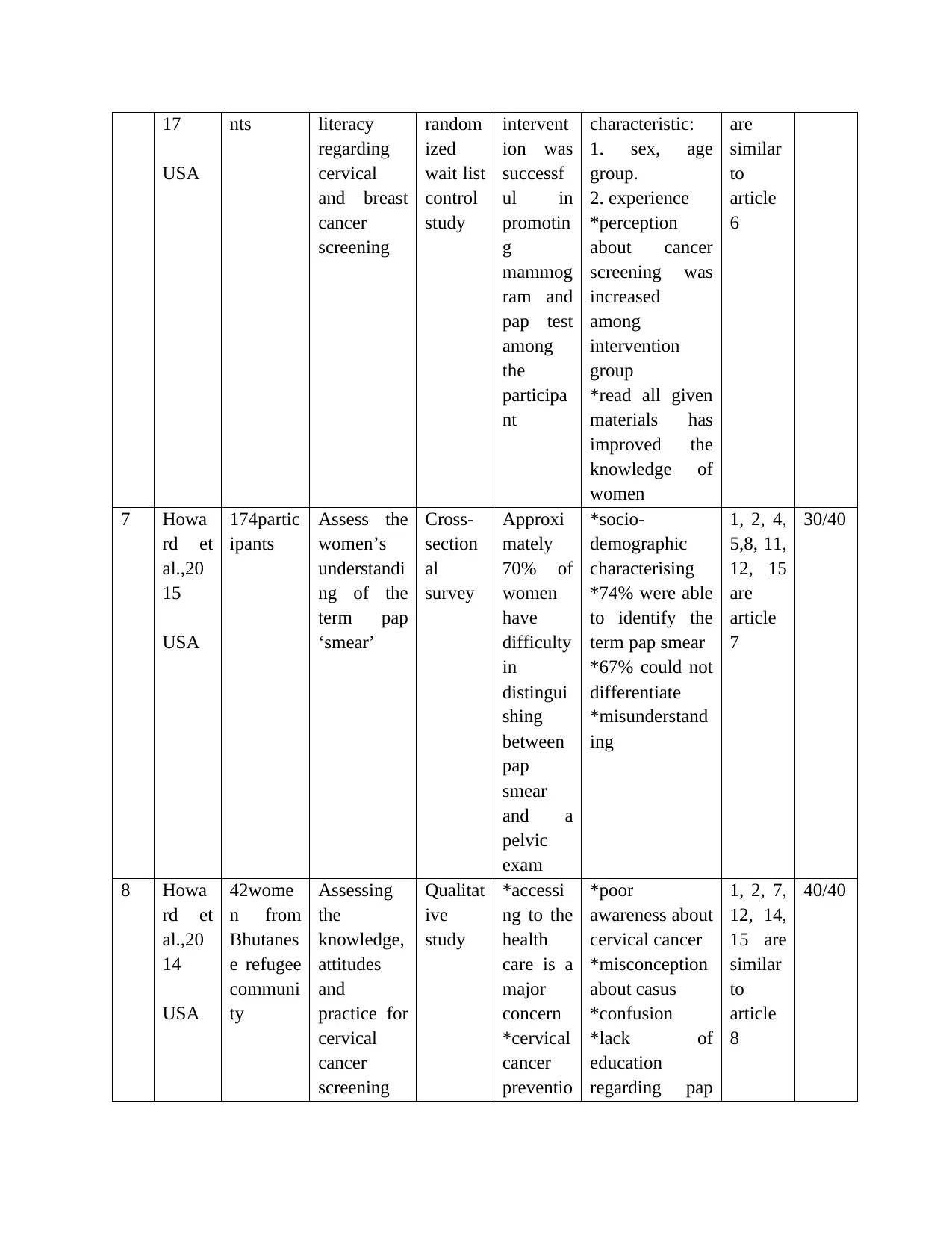
17
USA
nts literacy
regarding
cervical
and breast
cancer
screening
random
ized
wait list
control
study
intervent
ion was
successf
ul in
promotin
g
mammog
ram and
pap test
among
the
participa
nt
characteristic:
1. sex, age
group.
2. experience
*perception
about cancer
screening was
increased
among
intervention
group
*read all given
materials has
improved the
knowledge of
women
are
similar
to
article
6
7 Howa
rd et
al.,20
15
USA
174partic
ipants
Assess the
women’s
understandi
ng of the
term pap
‘smear’
Cross-
section
al
survey
Approxi
mately
70% of
women
have
difficulty
in
distingui
shing
between
pap
smear
and a
pelvic
exam
*socio-
demographic
characterising
*74% were able
to identify the
term pap smear
*67% could not
differentiate
*misunderstand
ing
1, 2, 4,
5,8, 11,
12, 15
are
article
7
30/40
8 Howa
rd et
al.,20
14
USA
42wome
n from
Bhutanes
e refugee
communi
ty
Assessing
the
knowledge,
attitudes
and
practice for
cervical
cancer
screening
Qualitat
ive
study
*accessi
ng to the
health
care is a
major
concern
*cervical
cancer
preventio
*poor
awareness about
cervical cancer
*misconception
about casus
*confusion
*lack of
education
regarding pap
1, 2, 7,
12, 14,
15 are
similar
to
article
8
40/40
USA
nts literacy
regarding
cervical
and breast
cancer
screening
random
ized
wait list
control
study
intervent
ion was
successf
ul in
promotin
g
mammog
ram and
pap test
among
the
participa
nt
characteristic:
1. sex, age
group.
2. experience
*perception
about cancer
screening was
increased
among
intervention
group
*read all given
materials has
improved the
knowledge of
women
are
similar
to
article
6
7 Howa
rd et
al.,20
15
USA
174partic
ipants
Assess the
women’s
understandi
ng of the
term pap
‘smear’
Cross-
section
al
survey
Approxi
mately
70% of
women
have
difficulty
in
distingui
shing
between
pap
smear
and a
pelvic
exam
*socio-
demographic
characterising
*74% were able
to identify the
term pap smear
*67% could not
differentiate
*misunderstand
ing
1, 2, 4,
5,8, 11,
12, 15
are
article
7
30/40
8 Howa
rd et
al.,20
14
USA
42wome
n from
Bhutanes
e refugee
communi
ty
Assessing
the
knowledge,
attitudes
and
practice for
cervical
cancer
screening
Qualitat
ive
study
*accessi
ng to the
health
care is a
major
concern
*cervical
cancer
preventio
*poor
awareness about
cervical cancer
*misconception
about casus
*confusion
*lack of
education
regarding pap
1, 2, 7,
12, 14,
15 are
similar
to
article
8
40/40
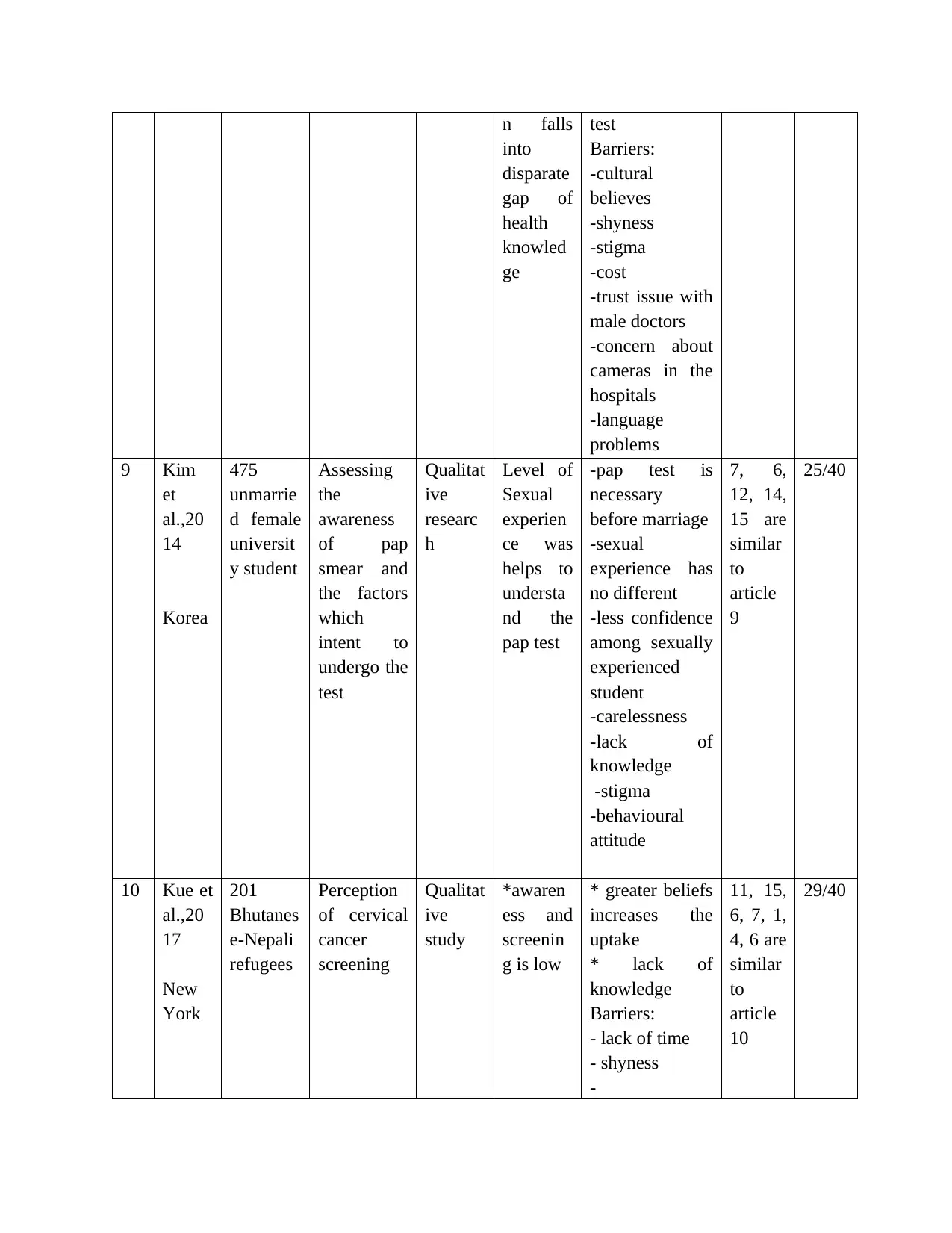
n falls
into
disparate
gap of
health
knowled
ge
test
Barriers:
-cultural
believes
-shyness
-stigma
-cost
-trust issue with
male doctors
-concern about
cameras in the
hospitals
-language
problems
9 Kim
et
al.,20
14
Korea
475
unmarrie
d female
universit
y student
Assessing
the
awareness
of pap
smear and
the factors
which
intent to
undergo the
test
Qualitat
ive
researc
h
Level of
Sexual
experien
ce was
helps to
understa
nd the
pap test
-pap test is
necessary
before marriage
-sexual
experience has
no different
-less confidence
among sexually
experienced
student
-carelessness
-lack of
knowledge
-stigma
-behavioural
attitude
7, 6,
12, 14,
15 are
similar
to
article
9
25/40
10 Kue et
al.,20
17
New
York
201
Bhutanes
e-Nepali
refugees
Perception
of cervical
cancer
screening
Qualitat
ive
study
*awaren
ess and
screenin
g is low
* greater beliefs
increases the
uptake
* lack of
knowledge
Barriers:
- lack of time
- shyness
-
11, 15,
6, 7, 1,
4, 6 are
similar
to
article
10
29/40
into
disparate
gap of
health
knowled
ge
test
Barriers:
-cultural
believes
-shyness
-stigma
-cost
-trust issue with
male doctors
-concern about
cameras in the
hospitals
-language
problems
9 Kim
et
al.,20
14
Korea
475
unmarrie
d female
universit
y student
Assessing
the
awareness
of pap
smear and
the factors
which
intent to
undergo the
test
Qualitat
ive
researc
h
Level of
Sexual
experien
ce was
helps to
understa
nd the
pap test
-pap test is
necessary
before marriage
-sexual
experience has
no different
-less confidence
among sexually
experienced
student
-carelessness
-lack of
knowledge
-stigma
-behavioural
attitude
7, 6,
12, 14,
15 are
similar
to
article
9
25/40
10 Kue et
al.,20
17
New
York
201
Bhutanes
e-Nepali
refugees
Perception
of cervical
cancer
screening
Qualitat
ive
study
*awaren
ess and
screenin
g is low
* greater beliefs
increases the
uptake
* lack of
knowledge
Barriers:
- lack of time
- shyness
-
11, 15,
6, 7, 1,
4, 6 are
similar
to
article
10
29/40
Paraphrase This Document
Need a fresh take? Get an instant paraphrase of this document with our AI Paraphraser
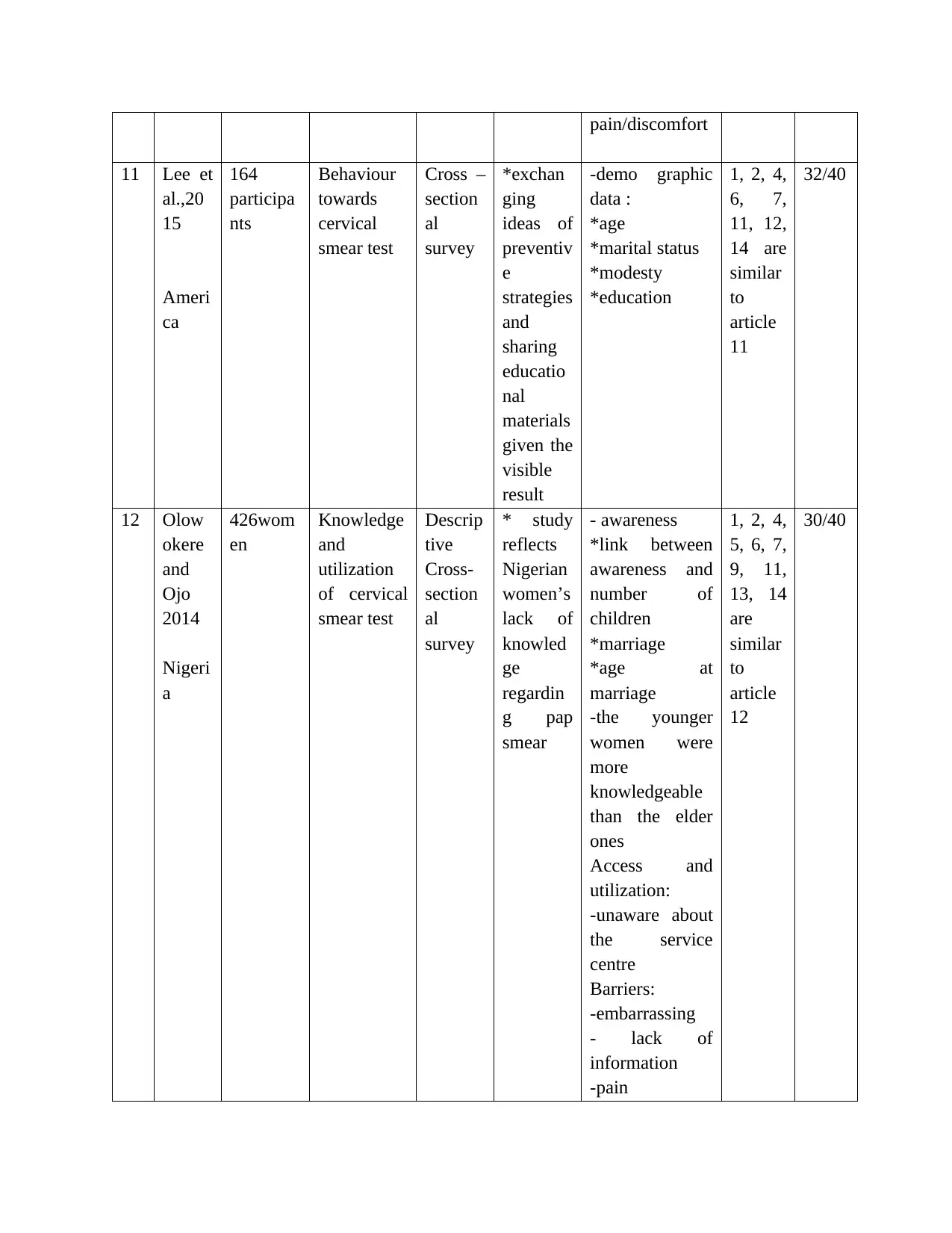
pain/discomfort
11 Lee et
al.,20
15
Ameri
ca
164
participa
nts
Behaviour
towards
cervical
smear test
Cross –
section
al
survey
*exchan
ging
ideas of
preventiv
e
strategies
and
sharing
educatio
nal
materials
given the
visible
result
-demo graphic
data :
*age
*marital status
*modesty
*education
1, 2, 4,
6, 7,
11, 12,
14 are
similar
to
article
11
32/40
12 Olow
okere
and
Ojo
2014
Nigeri
a
426wom
en
Knowledge
and
utilization
of cervical
smear test
Descrip
tive
Cross-
section
al
survey
* study
reflects
Nigerian
women’s
lack of
knowled
ge
regardin
g pap
smear
- awareness
*link between
awareness and
number of
children
*marriage
*age at
marriage
-the younger
women were
more
knowledgeable
than the elder
ones
Access and
utilization:
-unaware about
the service
centre
Barriers:
-embarrassing
- lack of
information
-pain
1, 2, 4,
5, 6, 7,
9, 11,
13, 14
are
similar
to
article
12
30/40
11 Lee et
al.,20
15
Ameri
ca
164
participa
nts
Behaviour
towards
cervical
smear test
Cross –
section
al
survey
*exchan
ging
ideas of
preventiv
e
strategies
and
sharing
educatio
nal
materials
given the
visible
result
-demo graphic
data :
*age
*marital status
*modesty
*education
1, 2, 4,
6, 7,
11, 12,
14 are
similar
to
article
11
32/40
12 Olow
okere
and
Ojo
2014
Nigeri
a
426wom
en
Knowledge
and
utilization
of cervical
smear test
Descrip
tive
Cross-
section
al
survey
* study
reflects
Nigerian
women’s
lack of
knowled
ge
regardin
g pap
smear
- awareness
*link between
awareness and
number of
children
*marriage
*age at
marriage
-the younger
women were
more
knowledgeable
than the elder
ones
Access and
utilization:
-unaware about
the service
centre
Barriers:
-embarrassing
- lack of
information
-pain
1, 2, 4,
5, 6, 7,
9, 11,
13, 14
are
similar
to
article
12
30/40
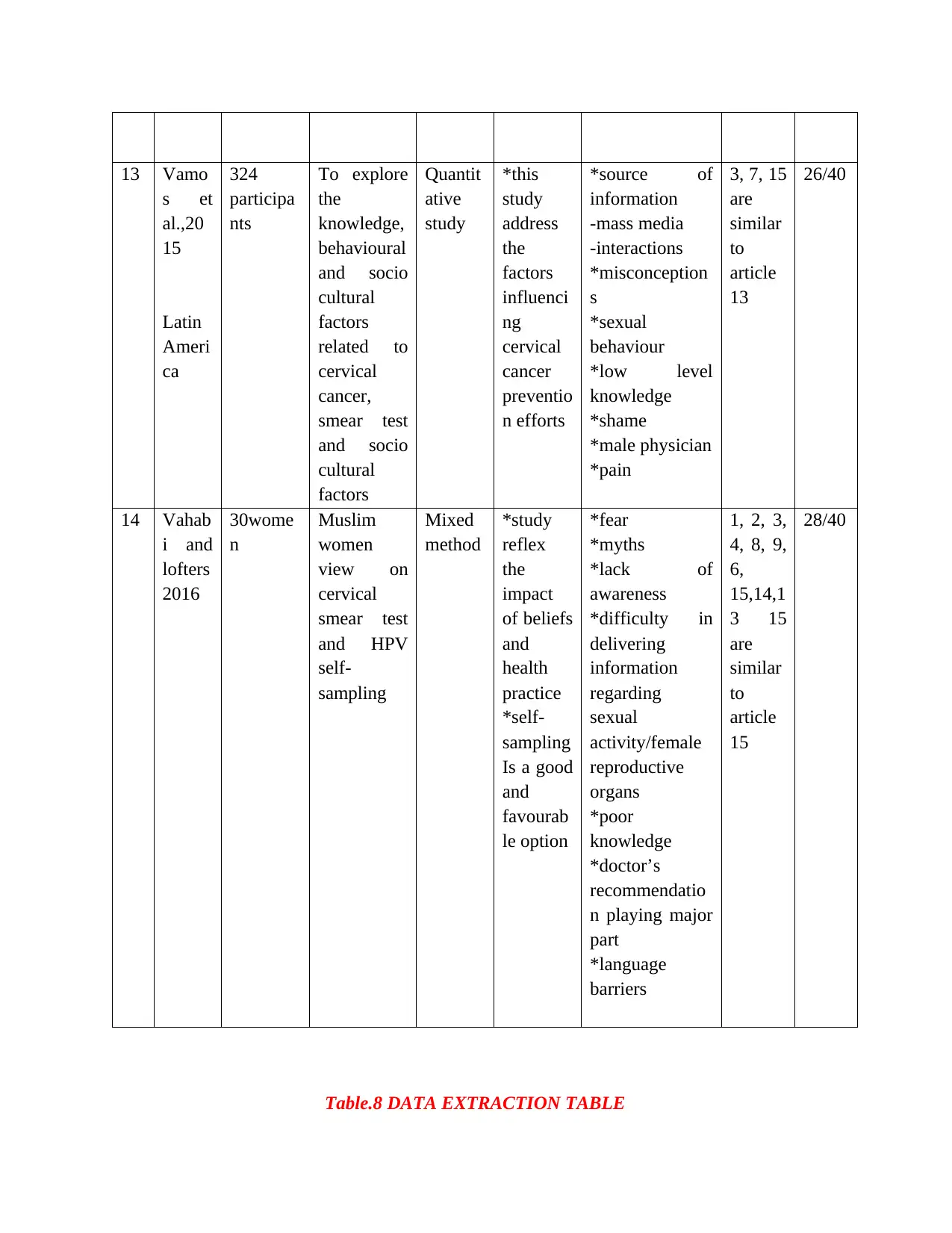
13 Vamo
s et
al.,20
15
Latin
Ameri
ca
324
participa
nts
To explore
the
knowledge,
behavioural
and socio
cultural
factors
related to
cervical
cancer,
smear test
and socio
cultural
factors
Quantit
ative
study
*this
study
address
the
factors
influenci
ng
cervical
cancer
preventio
n efforts
*source of
information
-mass media
-interactions
*misconception
s
*sexual
behaviour
*low level
knowledge
*shame
*male physician
*pain
3, 7, 15
are
similar
to
article
13
26/40
14 Vahab
i and
lofters
2016
30wome
n
Muslim
women
view on
cervical
smear test
and HPV
self-
sampling
Mixed
method
*study
reflex
the
impact
of beliefs
and
health
practice
*self-
sampling
Is a good
and
favourab
le option
*fear
*myths
*lack of
awareness
*difficulty in
delivering
information
regarding
sexual
activity/female
reproductive
organs
*poor
knowledge
*doctor’s
recommendatio
n playing major
part
*language
barriers
1, 2, 3,
4, 8, 9,
6,
15,14,1
3 15
are
similar
to
article
15
28/40
Table.8 DATA EXTRACTION TABLE
s et
al.,20
15
Latin
Ameri
ca
324
participa
nts
To explore
the
knowledge,
behavioural
and socio
cultural
factors
related to
cervical
cancer,
smear test
and socio
cultural
factors
Quantit
ative
study
*this
study
address
the
factors
influenci
ng
cervical
cancer
preventio
n efforts
*source of
information
-mass media
-interactions
*misconception
s
*sexual
behaviour
*low level
knowledge
*shame
*male physician
*pain
3, 7, 15
are
similar
to
article
13
26/40
14 Vahab
i and
lofters
2016
30wome
n
Muslim
women
view on
cervical
smear test
and HPV
self-
sampling
Mixed
method
*study
reflex
the
impact
of beliefs
and
health
practice
*self-
sampling
Is a good
and
favourab
le option
*fear
*myths
*lack of
awareness
*difficulty in
delivering
information
regarding
sexual
activity/female
reproductive
organs
*poor
knowledge
*doctor’s
recommendatio
n playing major
part
*language
barriers
1, 2, 3,
4, 8, 9,
6,
15,14,1
3 15
are
similar
to
article
15
28/40
Table.8 DATA EXTRACTION TABLE
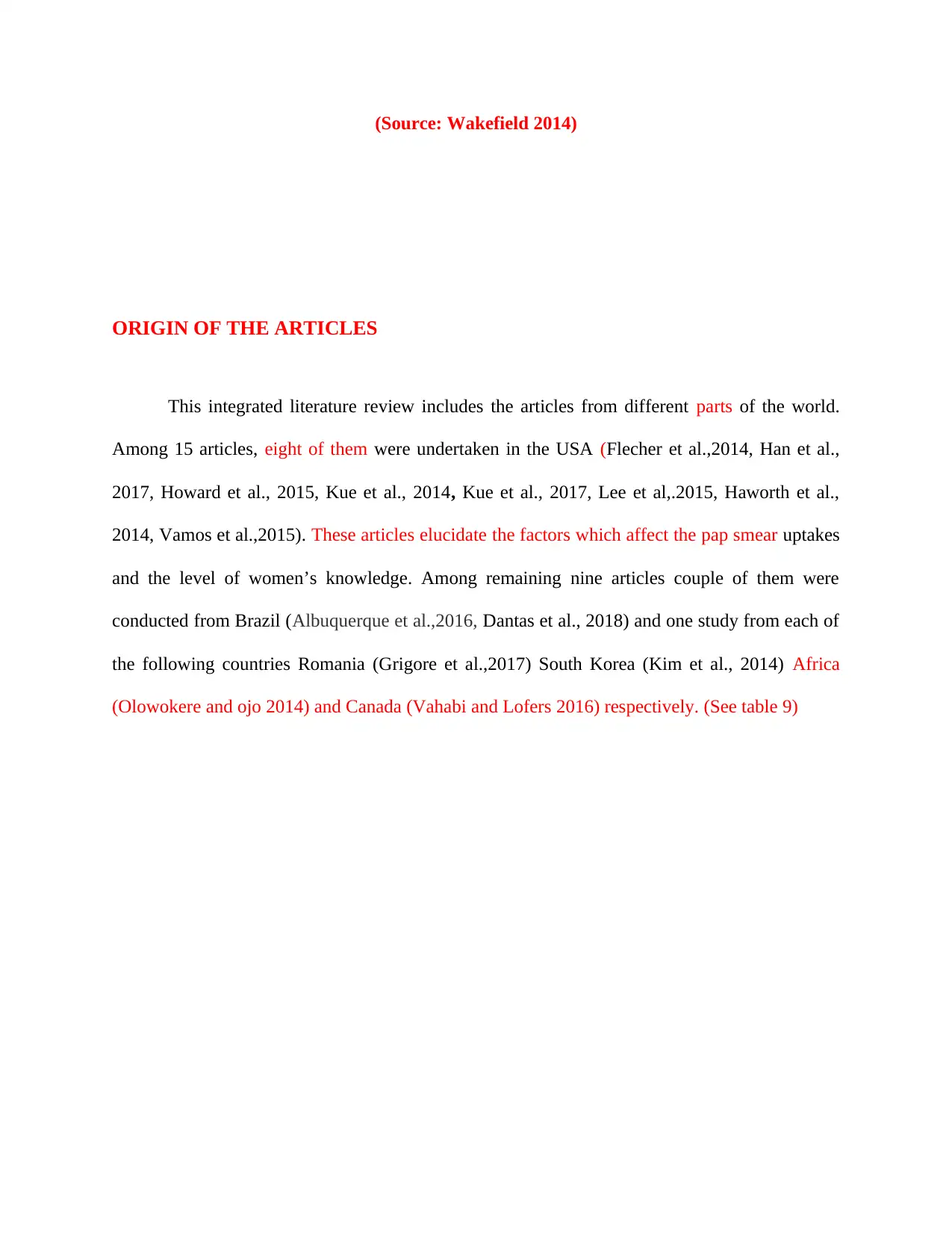
(Source: Wakefield 2014)
ORIGIN OF THE ARTICLES
This integrated literature review includes the articles from different parts of the world.
Among 15 articles, eight of them were undertaken in the USA (Flecher et al.,2014, Han et al.,
2017, Howard et al., 2015, Kue et al., 2014, Kue et al., 2017, Lee et al,.2015, Haworth et al.,
2014, Vamos et al.,2015). These articles elucidate the factors which affect the pap smear uptakes
and the level of women’s knowledge. Among remaining nine articles couple of them were
conducted from Brazil (Albuquerque et al.,2016, Dantas et al., 2018) and one study from each of
the following countries Romania (Grigore et al.,2017) South Korea (Kim et al., 2014) Africa
(Olowokere and ojo 2014) and Canada (Vahabi and Lofers 2016) respectively. (See table 9)
ORIGIN OF THE ARTICLES
This integrated literature review includes the articles from different parts of the world.
Among 15 articles, eight of them were undertaken in the USA (Flecher et al.,2014, Han et al.,
2017, Howard et al., 2015, Kue et al., 2014, Kue et al., 2017, Lee et al,.2015, Haworth et al.,
2014, Vamos et al.,2015). These articles elucidate the factors which affect the pap smear uptakes
and the level of women’s knowledge. Among remaining nine articles couple of them were
conducted from Brazil (Albuquerque et al.,2016, Dantas et al., 2018) and one study from each of
the following countries Romania (Grigore et al.,2017) South Korea (Kim et al., 2014) Africa
(Olowokere and ojo 2014) and Canada (Vahabi and Lofers 2016) respectively. (See table 9)
Secure Best Marks with AI Grader
Need help grading? Try our AI Grader for instant feedback on your assignments.
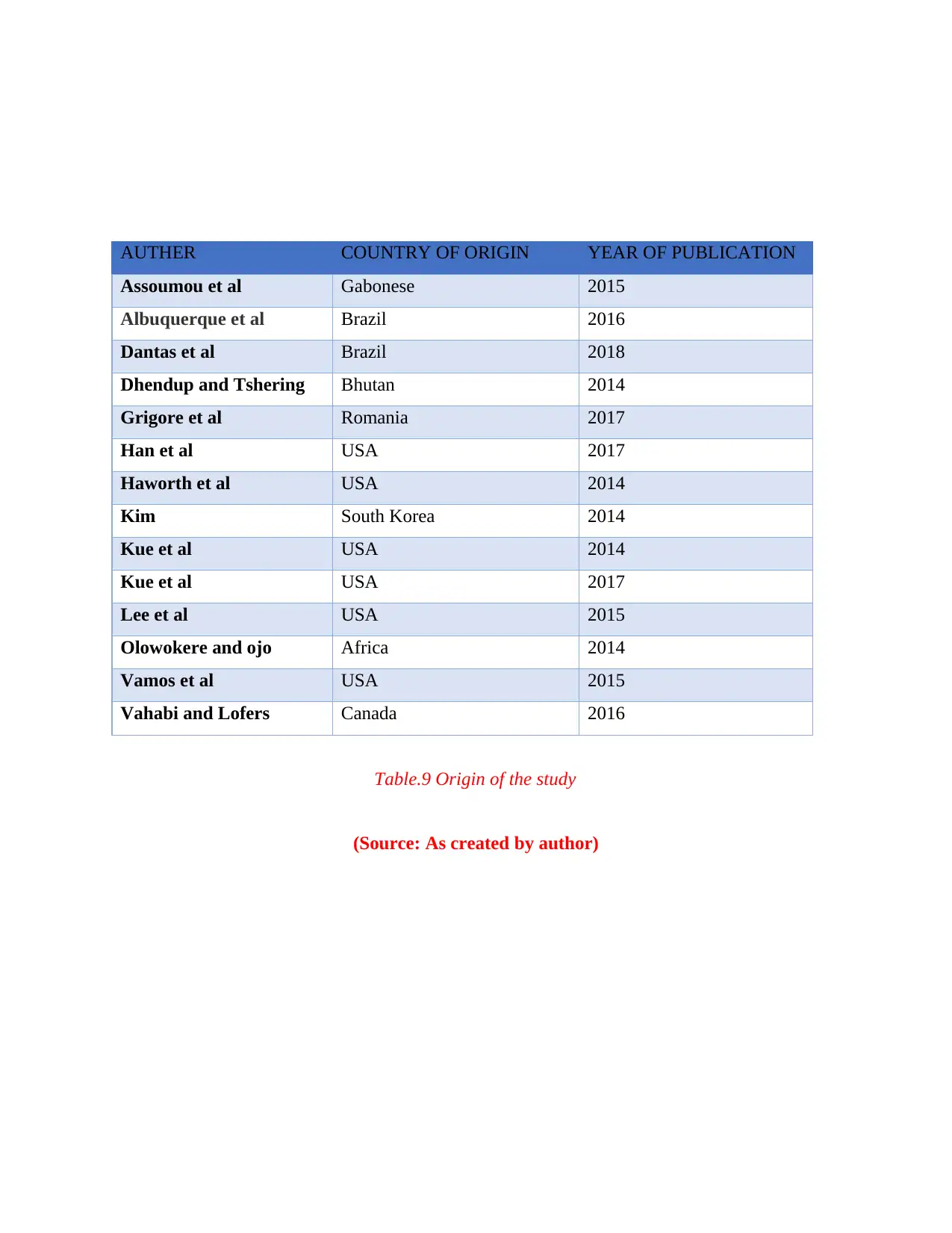
AUTHER COUNTRY OF ORIGIN YEAR OF PUBLICATION
Assoumou et al Gabonese 2015
Albuquerque et al Brazil 2016
Dantas et al Brazil 2018
Dhendup and Tshering Bhutan 2014
Grigore et al Romania 2017
Han et al USA 2017
Haworth et al USA 2014
Kim South Korea 2014
Kue et al USA 2014
Kue et al USA 2017
Lee et al USA 2015
Olowokere and ojo Africa 2014
Vamos et al USA 2015
Vahabi and Lofers Canada 2016
Table.9 Origin of the study
(Source: As created by author)
Assoumou et al Gabonese 2015
Albuquerque et al Brazil 2016
Dantas et al Brazil 2018
Dhendup and Tshering Bhutan 2014
Grigore et al Romania 2017
Han et al USA 2017
Haworth et al USA 2014
Kim South Korea 2014
Kue et al USA 2014
Kue et al USA 2017
Lee et al USA 2015
Olowokere and ojo Africa 2014
Vamos et al USA 2015
Vahabi and Lofers Canada 2016
Table.9 Origin of the study
(Source: As created by author)
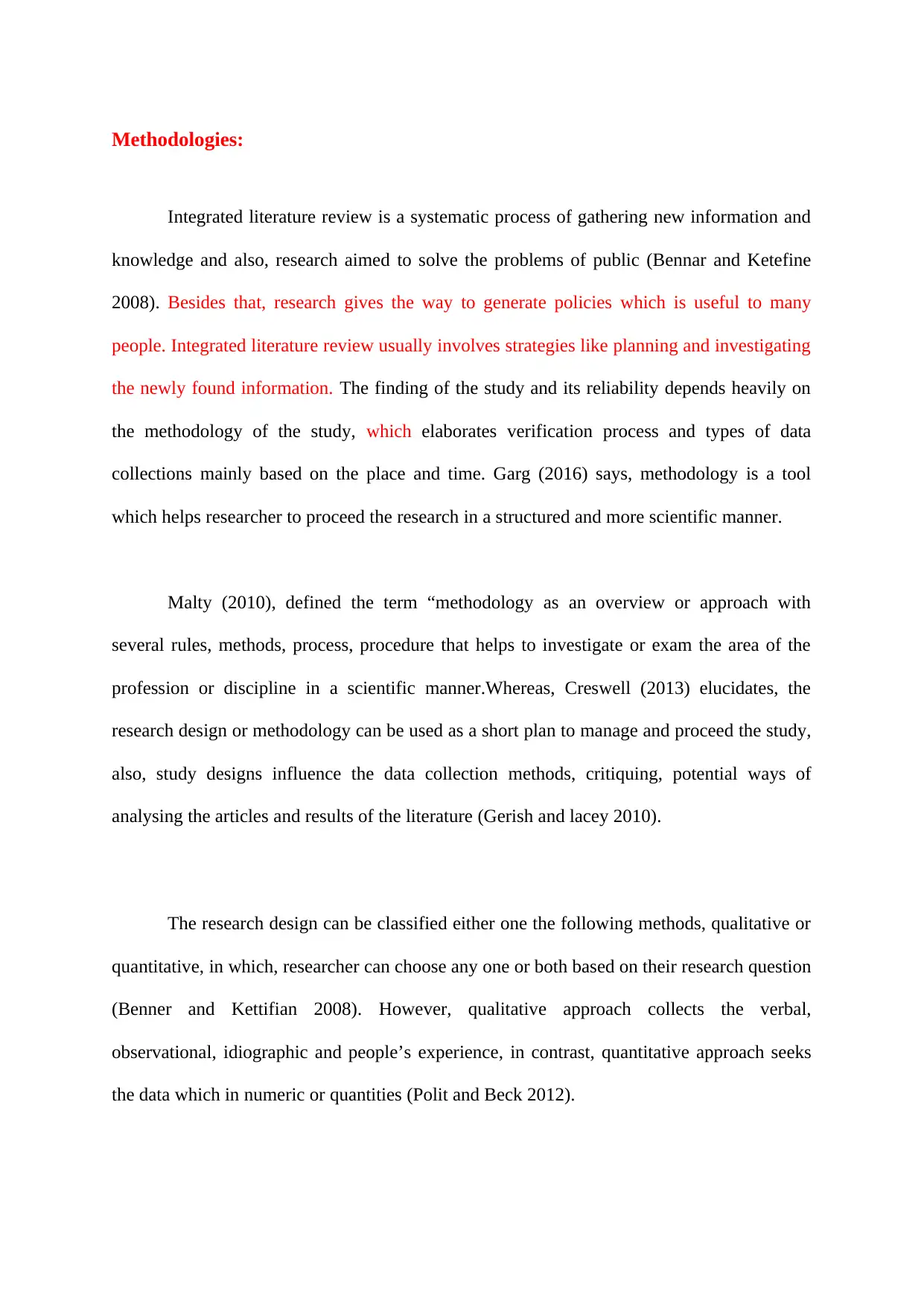
Methodologies:
Integrated literature review is a systematic process of gathering new information and
knowledge and also, research aimed to solve the problems of public (Bennar and Ketefine
2008). Besides that, research gives the way to generate policies which is useful to many
people. Integrated literature review usually involves strategies like planning and investigating
the newly found information. The finding of the study and its reliability depends heavily on
the methodology of the study, which elaborates verification process and types of data
collections mainly based on the place and time. Garg (2016) says, methodology is a tool
which helps researcher to proceed the research in a structured and more scientific manner.
Malty (2010), defined the term “methodology as an overview or approach with
several rules, methods, process, procedure that helps to investigate or exam the area of the
profession or discipline in a scientific manner.Whereas, Creswell (2013) elucidates, the
research design or methodology can be used as a short plan to manage and proceed the study,
also, study designs influence the data collection methods, critiquing, potential ways of
analysing the articles and results of the literature (Gerish and lacey 2010).
The research design can be classified either one the following methods, qualitative or
quantitative, in which, researcher can choose any one or both based on their research question
(Benner and Kettifian 2008). However, qualitative approach collects the verbal,
observational, idiographic and people’s experience, in contrast, quantitative approach seeks
the data which in numeric or quantities (Polit and Beck 2012).
Integrated literature review is a systematic process of gathering new information and
knowledge and also, research aimed to solve the problems of public (Bennar and Ketefine
2008). Besides that, research gives the way to generate policies which is useful to many
people. Integrated literature review usually involves strategies like planning and investigating
the newly found information. The finding of the study and its reliability depends heavily on
the methodology of the study, which elaborates verification process and types of data
collections mainly based on the place and time. Garg (2016) says, methodology is a tool
which helps researcher to proceed the research in a structured and more scientific manner.
Malty (2010), defined the term “methodology as an overview or approach with
several rules, methods, process, procedure that helps to investigate or exam the area of the
profession or discipline in a scientific manner.Whereas, Creswell (2013) elucidates, the
research design or methodology can be used as a short plan to manage and proceed the study,
also, study designs influence the data collection methods, critiquing, potential ways of
analysing the articles and results of the literature (Gerish and lacey 2010).
The research design can be classified either one the following methods, qualitative or
quantitative, in which, researcher can choose any one or both based on their research question
(Benner and Kettifian 2008). However, qualitative approach collects the verbal,
observational, idiographic and people’s experience, in contrast, quantitative approach seeks
the data which in numeric or quantities (Polit and Beck 2012).
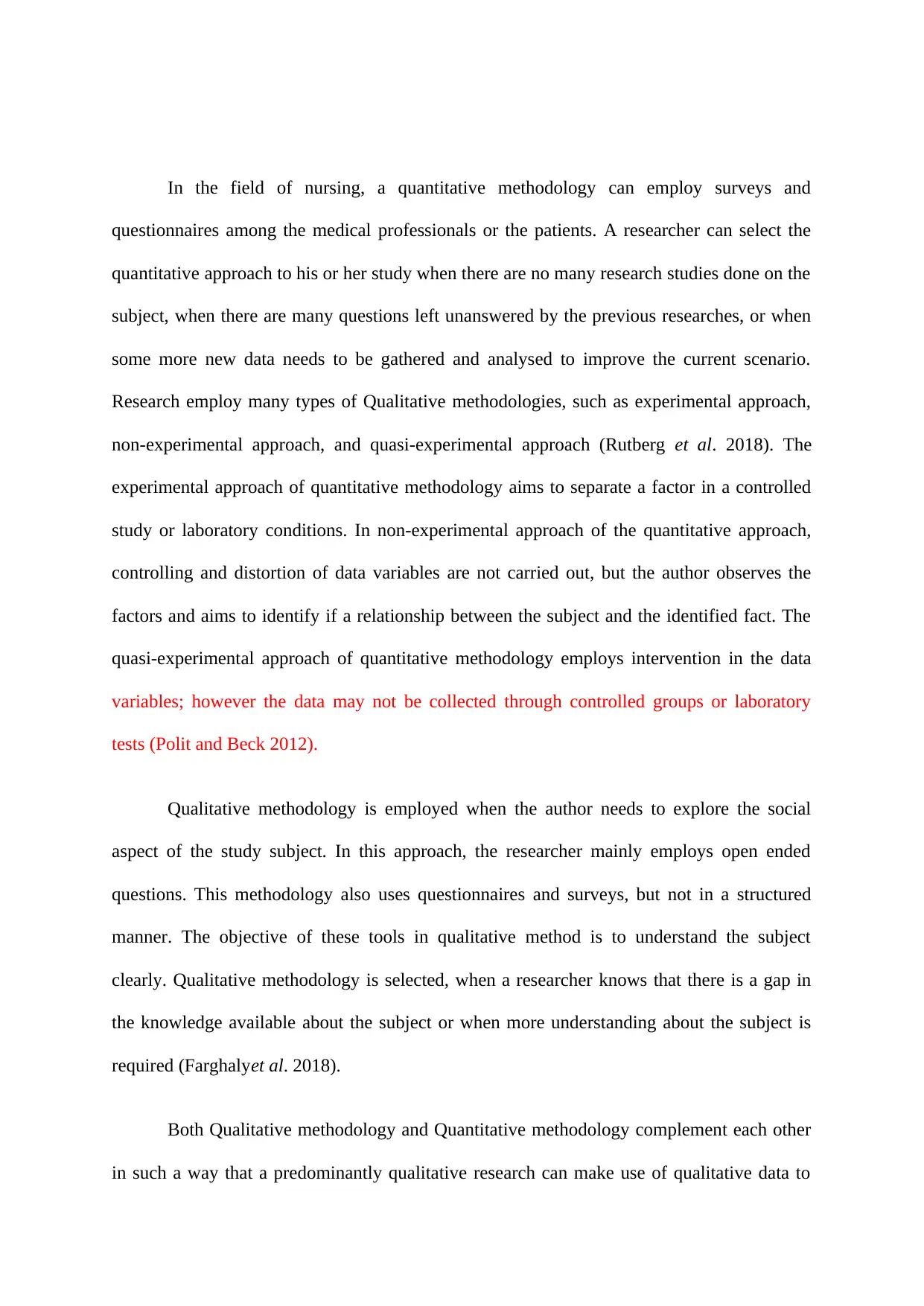
In the field of nursing, a quantitative methodology can employ surveys and
questionnaires among the medical professionals or the patients. A researcher can select the
quantitative approach to his or her study when there are no many research studies done on the
subject, when there are many questions left unanswered by the previous researches, or when
some more new data needs to be gathered and analysed to improve the current scenario.
Research employ many types of Qualitative methodologies, such as experimental approach,
non-experimental approach, and quasi-experimental approach (Rutberg et al. 2018). The
experimental approach of quantitative methodology aims to separate a factor in a controlled
study or laboratory conditions. In non-experimental approach of the quantitative approach,
controlling and distortion of data variables are not carried out, but the author observes the
factors and aims to identify if a relationship between the subject and the identified fact. The
quasi-experimental approach of quantitative methodology employs intervention in the data
variables; however the data may not be collected through controlled groups or laboratory
tests (Polit and Beck 2012).
Qualitative methodology is employed when the author needs to explore the social
aspect of the study subject. In this approach, the researcher mainly employs open ended
questions. This methodology also uses questionnaires and surveys, but not in a structured
manner. The objective of these tools in qualitative method is to understand the subject
clearly. Qualitative methodology is selected, when a researcher knows that there is a gap in
the knowledge available about the subject or when more understanding about the subject is
required (Farghalyet al. 2018).
Both Qualitative methodology and Quantitative methodology complement each other
in such a way that a predominantly qualitative research can make use of qualitative data to
questionnaires among the medical professionals or the patients. A researcher can select the
quantitative approach to his or her study when there are no many research studies done on the
subject, when there are many questions left unanswered by the previous researches, or when
some more new data needs to be gathered and analysed to improve the current scenario.
Research employ many types of Qualitative methodologies, such as experimental approach,
non-experimental approach, and quasi-experimental approach (Rutberg et al. 2018). The
experimental approach of quantitative methodology aims to separate a factor in a controlled
study or laboratory conditions. In non-experimental approach of the quantitative approach,
controlling and distortion of data variables are not carried out, but the author observes the
factors and aims to identify if a relationship between the subject and the identified fact. The
quasi-experimental approach of quantitative methodology employs intervention in the data
variables; however the data may not be collected through controlled groups or laboratory
tests (Polit and Beck 2012).
Qualitative methodology is employed when the author needs to explore the social
aspect of the study subject. In this approach, the researcher mainly employs open ended
questions. This methodology also uses questionnaires and surveys, but not in a structured
manner. The objective of these tools in qualitative method is to understand the subject
clearly. Qualitative methodology is selected, when a researcher knows that there is a gap in
the knowledge available about the subject or when more understanding about the subject is
required (Farghalyet al. 2018).
Both Qualitative methodology and Quantitative methodology complement each other
in such a way that a predominantly qualitative research can make use of qualitative data to
Paraphrase This Document
Need a fresh take? Get an instant paraphrase of this document with our AI Paraphraser
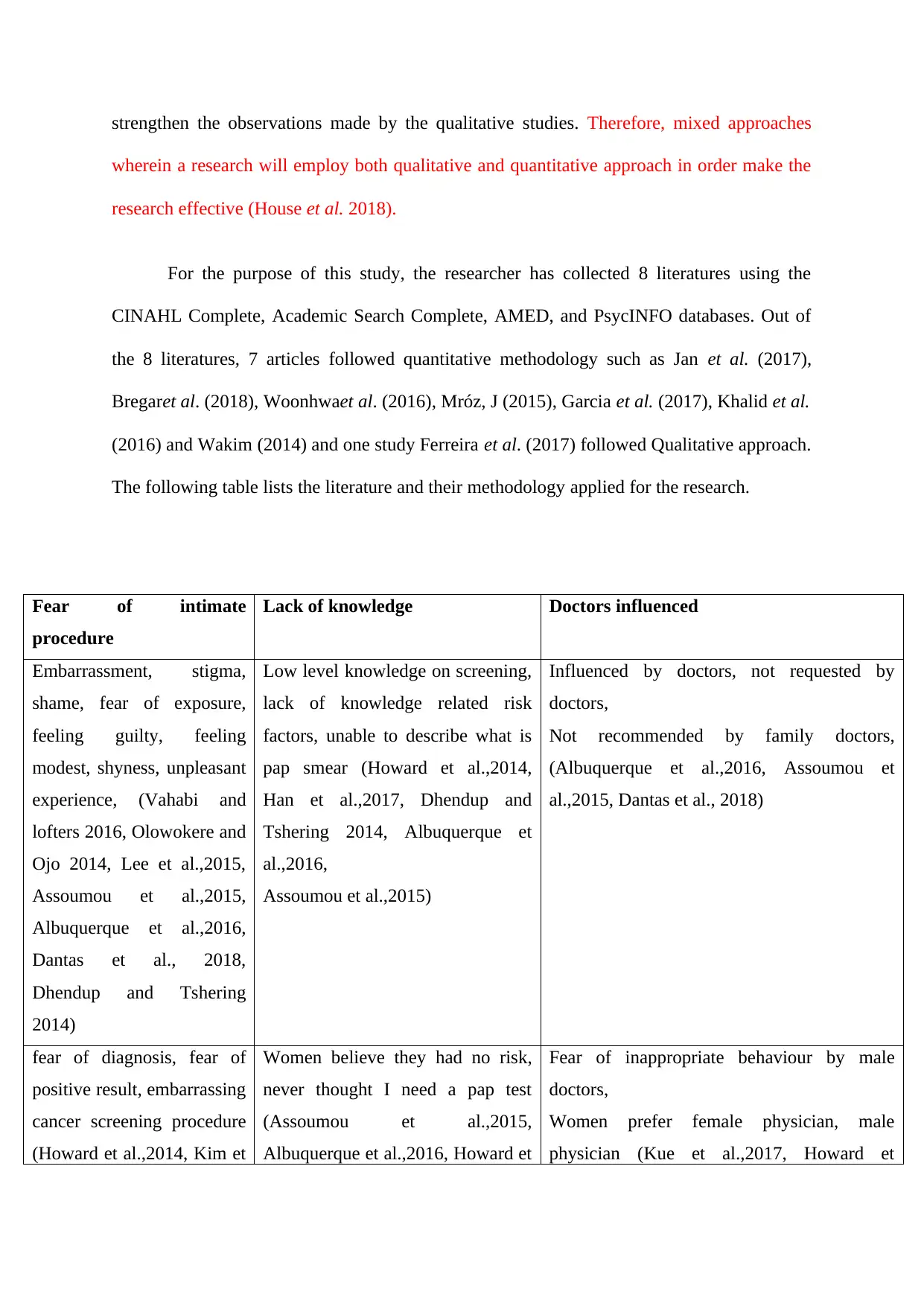
strengthen the observations made by the qualitative studies. Therefore, mixed approaches
wherein a research will employ both qualitative and quantitative approach in order make the
research effective (House et al. 2018).
For the purpose of this study, the researcher has collected 8 literatures using the
CINAHL Complete, Academic Search Complete, AMED, and PsycINFO databases. Out of
the 8 literatures, 7 articles followed quantitative methodology such as Jan et al. (2017),
Bregaret al. (2018), Woonhwaet al. (2016), Mróz, J (2015), Garcia et al. (2017), Khalid et al.
(2016) and Wakim (2014) and one study Ferreira et al. (2017) followed Qualitative approach.
The following table lists the literature and their methodology applied for the research.
Fear of intimate
procedure
Lack of knowledge Doctors influenced
Embarrassment, stigma,
shame, fear of exposure,
feeling guilty, feeling
modest, shyness, unpleasant
experience, (Vahabi and
lofters 2016, Olowokere and
Ojo 2014, Lee et al.,2015,
Assoumou et al.,2015,
Albuquerque et al.,2016,
Dantas et al., 2018,
Dhendup and Tshering
2014)
Low level knowledge on screening,
lack of knowledge related risk
factors, unable to describe what is
pap smear (Howard et al.,2014,
Han et al.,2017, Dhendup and
Tshering 2014, Albuquerque et
al.,2016,
Assoumou et al.,2015)
Influenced by doctors, not requested by
doctors,
Not recommended by family doctors,
(Albuquerque et al.,2016, Assoumou et
al.,2015, Dantas et al., 2018)
fear of diagnosis, fear of
positive result, embarrassing
cancer screening procedure
(Howard et al.,2014, Kim et
Women believe they had no risk,
never thought I need a pap test
(Assoumou et al.,2015,
Albuquerque et al.,2016, Howard et
Fear of inappropriate behaviour by male
doctors,
Women prefer female physician, male
physician (Kue et al.,2017, Howard et
wherein a research will employ both qualitative and quantitative approach in order make the
research effective (House et al. 2018).
For the purpose of this study, the researcher has collected 8 literatures using the
CINAHL Complete, Academic Search Complete, AMED, and PsycINFO databases. Out of
the 8 literatures, 7 articles followed quantitative methodology such as Jan et al. (2017),
Bregaret al. (2018), Woonhwaet al. (2016), Mróz, J (2015), Garcia et al. (2017), Khalid et al.
(2016) and Wakim (2014) and one study Ferreira et al. (2017) followed Qualitative approach.
The following table lists the literature and their methodology applied for the research.
Fear of intimate
procedure
Lack of knowledge Doctors influenced
Embarrassment, stigma,
shame, fear of exposure,
feeling guilty, feeling
modest, shyness, unpleasant
experience, (Vahabi and
lofters 2016, Olowokere and
Ojo 2014, Lee et al.,2015,
Assoumou et al.,2015,
Albuquerque et al.,2016,
Dantas et al., 2018,
Dhendup and Tshering
2014)
Low level knowledge on screening,
lack of knowledge related risk
factors, unable to describe what is
pap smear (Howard et al.,2014,
Han et al.,2017, Dhendup and
Tshering 2014, Albuquerque et
al.,2016,
Assoumou et al.,2015)
Influenced by doctors, not requested by
doctors,
Not recommended by family doctors,
(Albuquerque et al.,2016, Assoumou et
al.,2015, Dantas et al., 2018)
fear of diagnosis, fear of
positive result, embarrassing
cancer screening procedure
(Howard et al.,2014, Kim et
Women believe they had no risk,
never thought I need a pap test
(Assoumou et al.,2015,
Albuquerque et al.,2016, Howard et
Fear of inappropriate behaviour by male
doctors,
Women prefer female physician, male
physician (Kue et al.,2017, Howard et
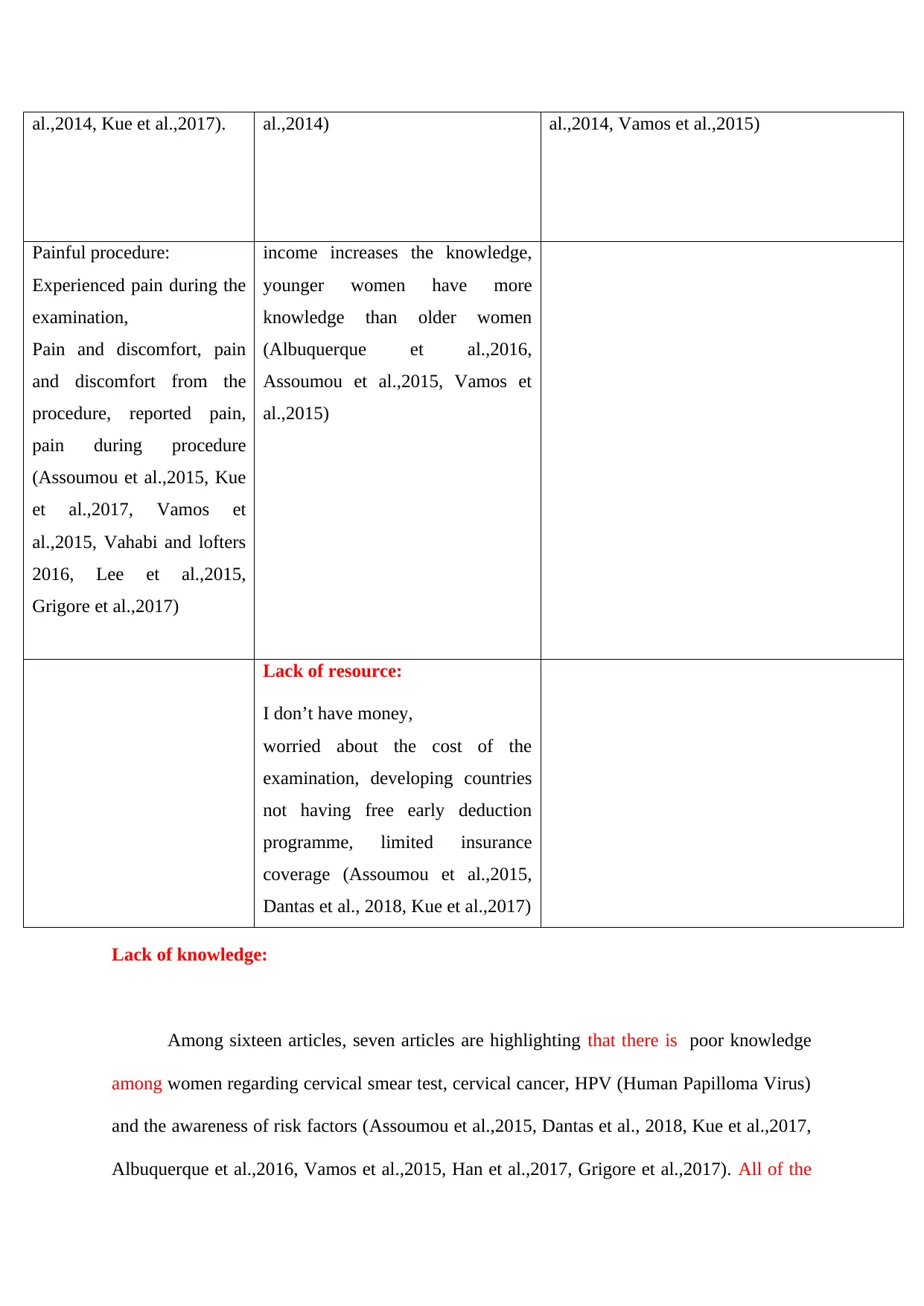
al.,2014, Kue et al.,2017). al.,2014) al.,2014, Vamos et al.,2015)
Painful procedure:
Experienced pain during the
examination,
Pain and discomfort, pain
and discomfort from the
procedure, reported pain,
pain during procedure
(Assoumou et al.,2015, Kue
et al.,2017, Vamos et
al.,2015, Vahabi and lofters
2016, Lee et al.,2015,
Grigore et al.,2017)
income increases the knowledge,
younger women have more
knowledge than older women
(Albuquerque et al.,2016,
Assoumou et al.,2015, Vamos et
al.,2015)
Lack of resource:
I don’t have money,
worried about the cost of the
examination, developing countries
not having free early deduction
programme, limited insurance
coverage (Assoumou et al.,2015,
Dantas et al., 2018, Kue et al.,2017)
Lack of knowledge:
Among sixteen articles, seven articles are highlighting that there is poor knowledge
among women regarding cervical smear test, cervical cancer, HPV (Human Papilloma Virus)
and the awareness of risk factors (Assoumou et al.,2015, Dantas et al., 2018, Kue et al.,2017,
Albuquerque et al.,2016, Vamos et al.,2015, Han et al.,2017, Grigore et al.,2017). All of the
Painful procedure:
Experienced pain during the
examination,
Pain and discomfort, pain
and discomfort from the
procedure, reported pain,
pain during procedure
(Assoumou et al.,2015, Kue
et al.,2017, Vamos et
al.,2015, Vahabi and lofters
2016, Lee et al.,2015,
Grigore et al.,2017)
income increases the knowledge,
younger women have more
knowledge than older women
(Albuquerque et al.,2016,
Assoumou et al.,2015, Vamos et
al.,2015)
Lack of resource:
I don’t have money,
worried about the cost of the
examination, developing countries
not having free early deduction
programme, limited insurance
coverage (Assoumou et al.,2015,
Dantas et al., 2018, Kue et al.,2017)
Lack of knowledge:
Among sixteen articles, seven articles are highlighting that there is poor knowledge
among women regarding cervical smear test, cervical cancer, HPV (Human Papilloma Virus)
and the awareness of risk factors (Assoumou et al.,2015, Dantas et al., 2018, Kue et al.,2017,
Albuquerque et al.,2016, Vamos et al.,2015, Han et al.,2017, Grigore et al.,2017). All of the
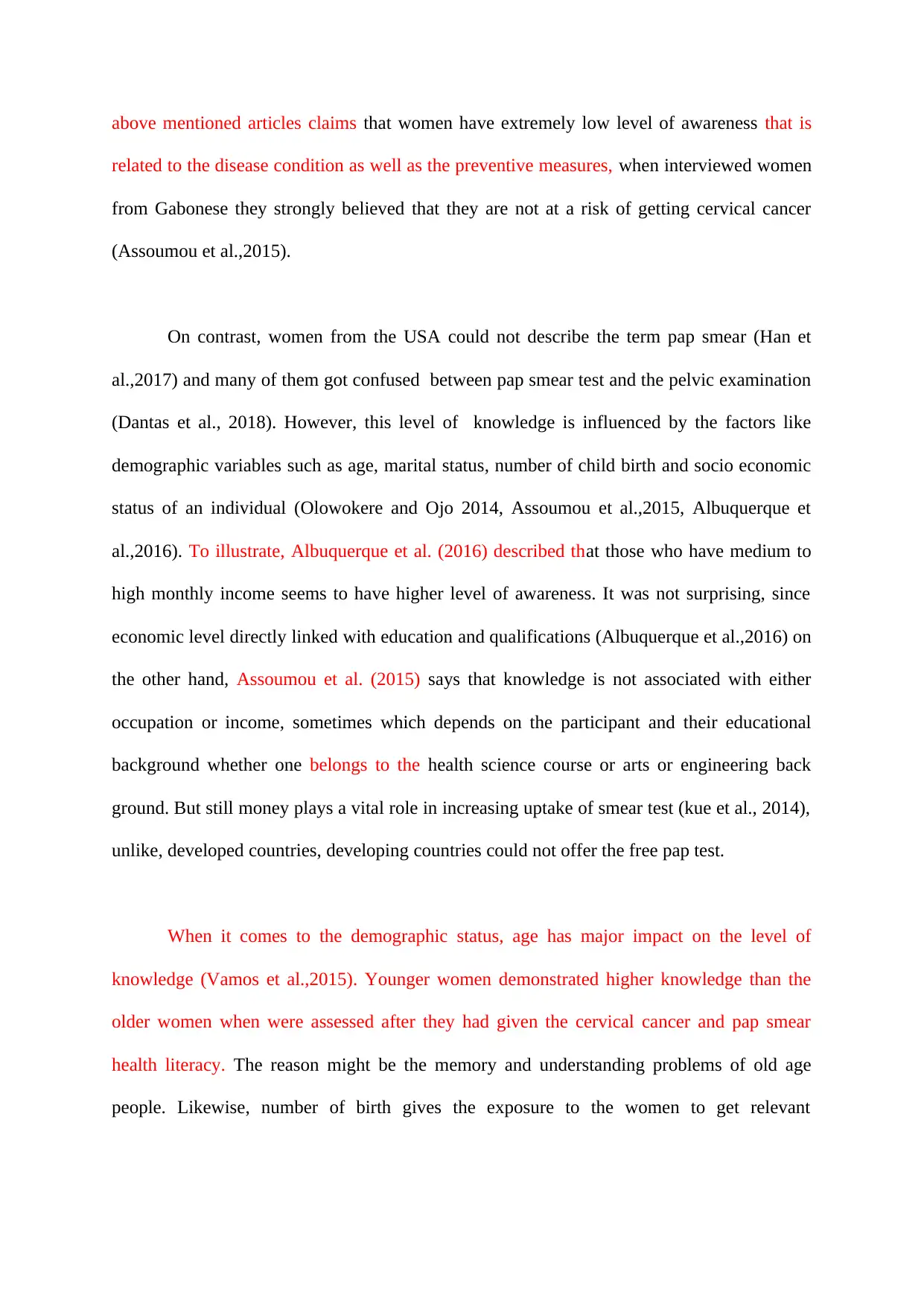
above mentioned articles claims that women have extremely low level of awareness that is
related to the disease condition as well as the preventive measures, when interviewed women
from Gabonese they strongly believed that they are not at a risk of getting cervical cancer
(Assoumou et al.,2015).
On contrast, women from the USA could not describe the term pap smear (Han et
al.,2017) and many of them got confused between pap smear test and the pelvic examination
(Dantas et al., 2018). However, this level of knowledge is influenced by the factors like
demographic variables such as age, marital status, number of child birth and socio economic
status of an individual (Olowokere and Ojo 2014, Assoumou et al.,2015, Albuquerque et
al.,2016). To illustrate, Albuquerque et al. (2016) described that those who have medium to
high monthly income seems to have higher level of awareness. It was not surprising, since
economic level directly linked with education and qualifications (Albuquerque et al.,2016) on
the other hand, Assoumou et al. (2015) says that knowledge is not associated with either
occupation or income, sometimes which depends on the participant and their educational
background whether one belongs to the health science course or arts or engineering back
ground. But still money plays a vital role in increasing uptake of smear test (kue et al., 2014),
unlike, developed countries, developing countries could not offer the free pap test.
When it comes to the demographic status, age has major impact on the level of
knowledge (Vamos et al.,2015). Younger women demonstrated higher knowledge than the
older women when were assessed after they had given the cervical cancer and pap smear
health literacy. The reason might be the memory and understanding problems of old age
people. Likewise, number of birth gives the exposure to the women to get relevant
related to the disease condition as well as the preventive measures, when interviewed women
from Gabonese they strongly believed that they are not at a risk of getting cervical cancer
(Assoumou et al.,2015).
On contrast, women from the USA could not describe the term pap smear (Han et
al.,2017) and many of them got confused between pap smear test and the pelvic examination
(Dantas et al., 2018). However, this level of knowledge is influenced by the factors like
demographic variables such as age, marital status, number of child birth and socio economic
status of an individual (Olowokere and Ojo 2014, Assoumou et al.,2015, Albuquerque et
al.,2016). To illustrate, Albuquerque et al. (2016) described that those who have medium to
high monthly income seems to have higher level of awareness. It was not surprising, since
economic level directly linked with education and qualifications (Albuquerque et al.,2016) on
the other hand, Assoumou et al. (2015) says that knowledge is not associated with either
occupation or income, sometimes which depends on the participant and their educational
background whether one belongs to the health science course or arts or engineering back
ground. But still money plays a vital role in increasing uptake of smear test (kue et al., 2014),
unlike, developed countries, developing countries could not offer the free pap test.
When it comes to the demographic status, age has major impact on the level of
knowledge (Vamos et al.,2015). Younger women demonstrated higher knowledge than the
older women when were assessed after they had given the cervical cancer and pap smear
health literacy. The reason might be the memory and understanding problems of old age
people. Likewise, number of birth gives the exposure to the women to get relevant
Secure Best Marks with AI Grader
Need help grading? Try our AI Grader for instant feedback on your assignments.
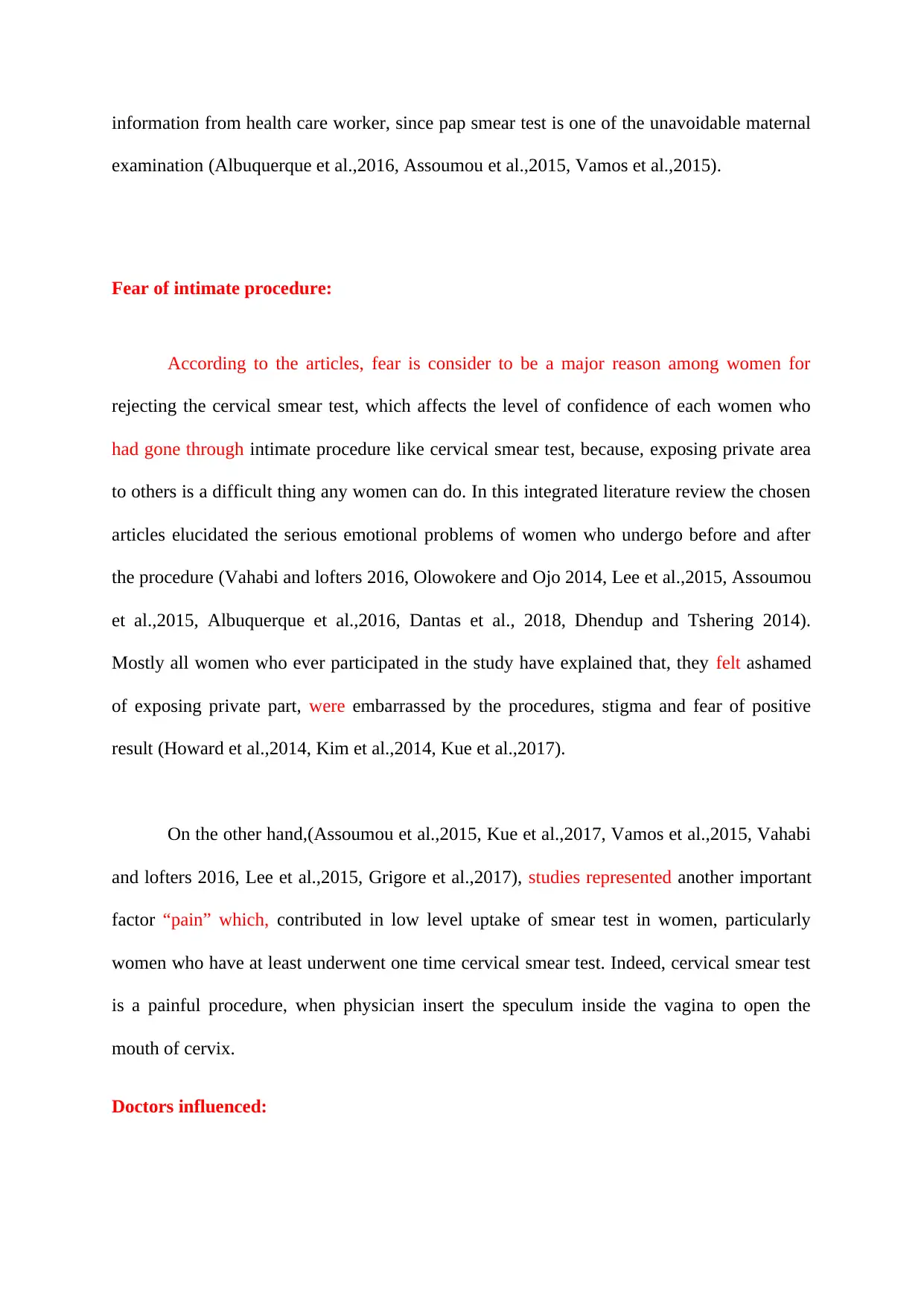
information from health care worker, since pap smear test is one of the unavoidable maternal
examination (Albuquerque et al.,2016, Assoumou et al.,2015, Vamos et al.,2015).
Fear of intimate procedure:
According to the articles, fear is consider to be a major reason among women for
rejecting the cervical smear test, which affects the level of confidence of each women who
had gone through intimate procedure like cervical smear test, because, exposing private area
to others is a difficult thing any women can do. In this integrated literature review the chosen
articles elucidated the serious emotional problems of women who undergo before and after
the procedure (Vahabi and lofters 2016, Olowokere and Ojo 2014, Lee et al.,2015, Assoumou
et al.,2015, Albuquerque et al.,2016, Dantas et al., 2018, Dhendup and Tshering 2014).
Mostly all women who ever participated in the study have explained that, they felt ashamed
of exposing private part, were embarrassed by the procedures, stigma and fear of positive
result (Howard et al.,2014, Kim et al.,2014, Kue et al.,2017).
On the other hand,(Assoumou et al.,2015, Kue et al.,2017, Vamos et al.,2015, Vahabi
and lofters 2016, Lee et al.,2015, Grigore et al.,2017), studies represented another important
factor “pain” which, contributed in low level uptake of smear test in women, particularly
women who have at least underwent one time cervical smear test. Indeed, cervical smear test
is a painful procedure, when physician insert the speculum inside the vagina to open the
mouth of cervix.
Doctors influenced:
examination (Albuquerque et al.,2016, Assoumou et al.,2015, Vamos et al.,2015).
Fear of intimate procedure:
According to the articles, fear is consider to be a major reason among women for
rejecting the cervical smear test, which affects the level of confidence of each women who
had gone through intimate procedure like cervical smear test, because, exposing private area
to others is a difficult thing any women can do. In this integrated literature review the chosen
articles elucidated the serious emotional problems of women who undergo before and after
the procedure (Vahabi and lofters 2016, Olowokere and Ojo 2014, Lee et al.,2015, Assoumou
et al.,2015, Albuquerque et al.,2016, Dantas et al., 2018, Dhendup and Tshering 2014).
Mostly all women who ever participated in the study have explained that, they felt ashamed
of exposing private part, were embarrassed by the procedures, stigma and fear of positive
result (Howard et al.,2014, Kim et al.,2014, Kue et al.,2017).
On the other hand,(Assoumou et al.,2015, Kue et al.,2017, Vamos et al.,2015, Vahabi
and lofters 2016, Lee et al.,2015, Grigore et al.,2017), studies represented another important
factor “pain” which, contributed in low level uptake of smear test in women, particularly
women who have at least underwent one time cervical smear test. Indeed, cervical smear test
is a painful procedure, when physician insert the speculum inside the vagina to open the
mouth of cervix.
Doctors influenced:
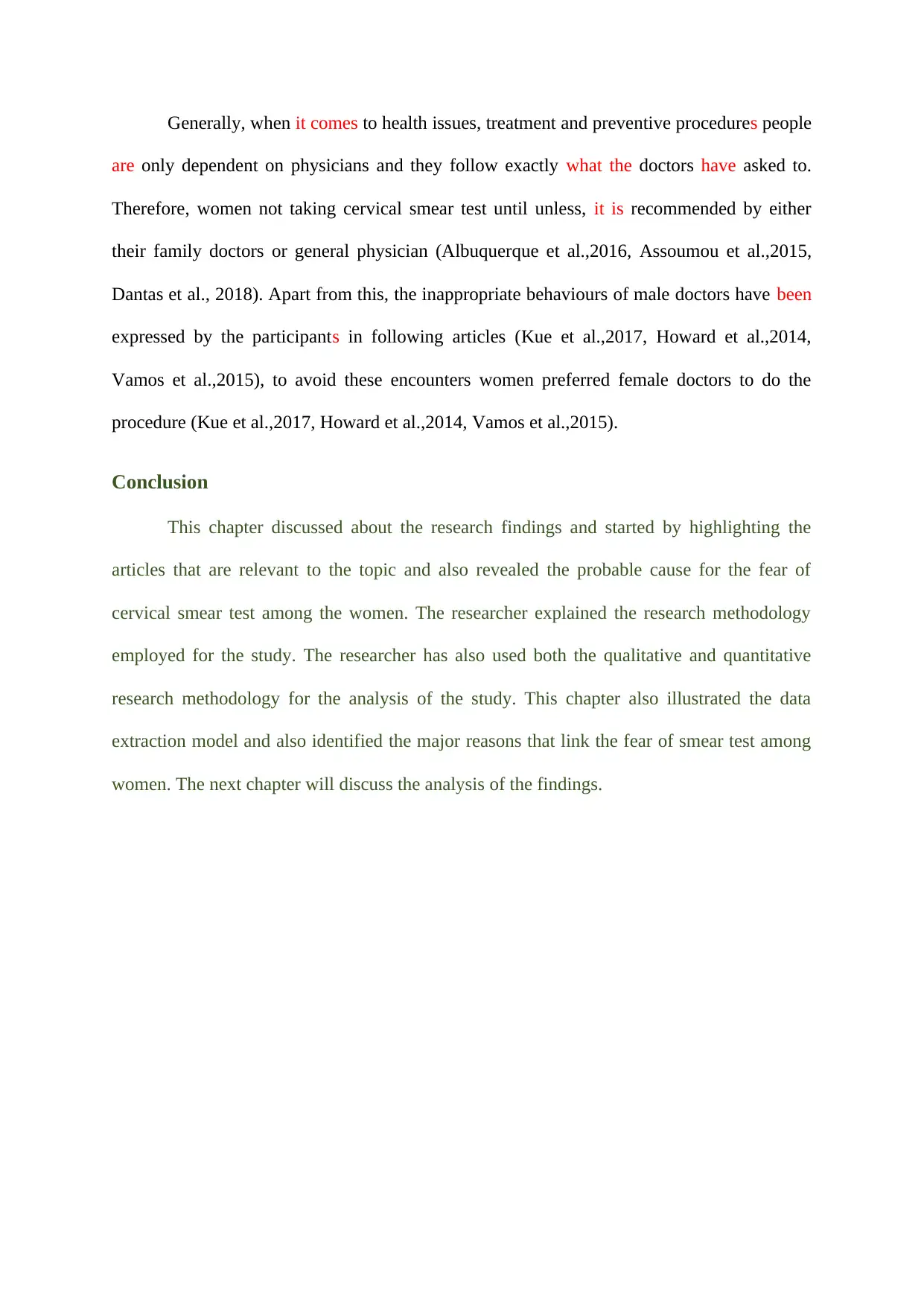
Generally, when it comes to health issues, treatment and preventive procedures people
are only dependent on physicians and they follow exactly what the doctors have asked to.
Therefore, women not taking cervical smear test until unless, it is recommended by either
their family doctors or general physician (Albuquerque et al.,2016, Assoumou et al.,2015,
Dantas et al., 2018). Apart from this, the inappropriate behaviours of male doctors have been
expressed by the participants in following articles (Kue et al.,2017, Howard et al.,2014,
Vamos et al.,2015), to avoid these encounters women preferred female doctors to do the
procedure (Kue et al.,2017, Howard et al.,2014, Vamos et al.,2015).
Conclusion
This chapter discussed about the research findings and started by highlighting the
articles that are relevant to the topic and also revealed the probable cause for the fear of
cervical smear test among the women. The researcher explained the research methodology
employed for the study. The researcher has also used both the qualitative and quantitative
research methodology for the analysis of the study. This chapter also illustrated the data
extraction model and also identified the major reasons that link the fear of smear test among
women. The next chapter will discuss the analysis of the findings.
are only dependent on physicians and they follow exactly what the doctors have asked to.
Therefore, women not taking cervical smear test until unless, it is recommended by either
their family doctors or general physician (Albuquerque et al.,2016, Assoumou et al.,2015,
Dantas et al., 2018). Apart from this, the inappropriate behaviours of male doctors have been
expressed by the participants in following articles (Kue et al.,2017, Howard et al.,2014,
Vamos et al.,2015), to avoid these encounters women preferred female doctors to do the
procedure (Kue et al.,2017, Howard et al.,2014, Vamos et al.,2015).
Conclusion
This chapter discussed about the research findings and started by highlighting the
articles that are relevant to the topic and also revealed the probable cause for the fear of
cervical smear test among the women. The researcher explained the research methodology
employed for the study. The researcher has also used both the qualitative and quantitative
research methodology for the analysis of the study. This chapter also illustrated the data
extraction model and also identified the major reasons that link the fear of smear test among
women. The next chapter will discuss the analysis of the findings.
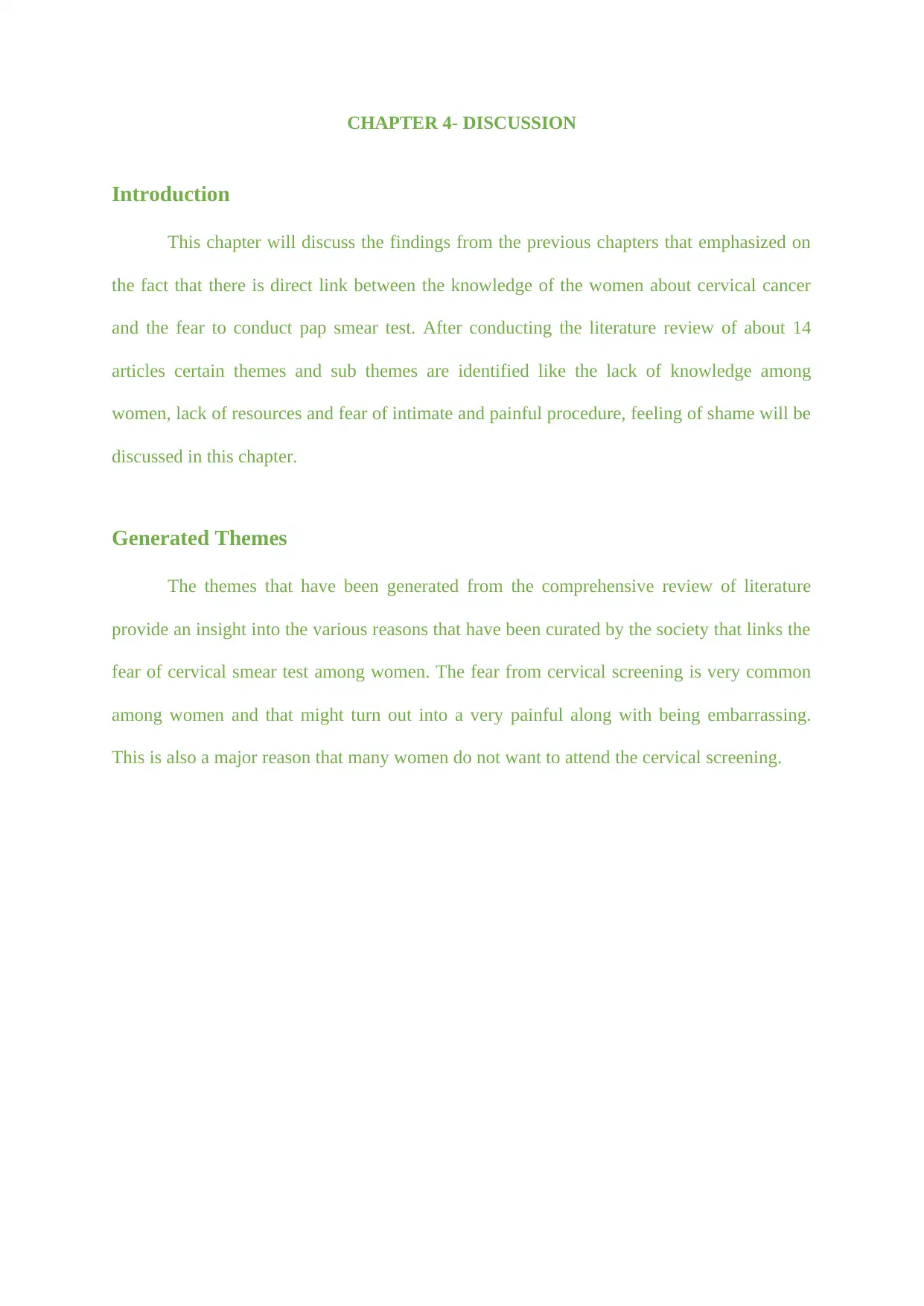
CHAPTER 4- DISCUSSION
Introduction
This chapter will discuss the findings from the previous chapters that emphasized on
the fact that there is direct link between the knowledge of the women about cervical cancer
and the fear to conduct pap smear test. After conducting the literature review of about 14
articles certain themes and sub themes are identified like the lack of knowledge among
women, lack of resources and fear of intimate and painful procedure, feeling of shame will be
discussed in this chapter.
Generated Themes
The themes that have been generated from the comprehensive review of literature
provide an insight into the various reasons that have been curated by the society that links the
fear of cervical smear test among women. The fear from cervical screening is very common
among women and that might turn out into a very painful along with being embarrassing.
This is also a major reason that many women do not want to attend the cervical screening.
Introduction
This chapter will discuss the findings from the previous chapters that emphasized on
the fact that there is direct link between the knowledge of the women about cervical cancer
and the fear to conduct pap smear test. After conducting the literature review of about 14
articles certain themes and sub themes are identified like the lack of knowledge among
women, lack of resources and fear of intimate and painful procedure, feeling of shame will be
discussed in this chapter.
Generated Themes
The themes that have been generated from the comprehensive review of literature
provide an insight into the various reasons that have been curated by the society that links the
fear of cervical smear test among women. The fear from cervical screening is very common
among women and that might turn out into a very painful along with being embarrassing.
This is also a major reason that many women do not want to attend the cervical screening.
Paraphrase This Document
Need a fresh take? Get an instant paraphrase of this document with our AI Paraphraser
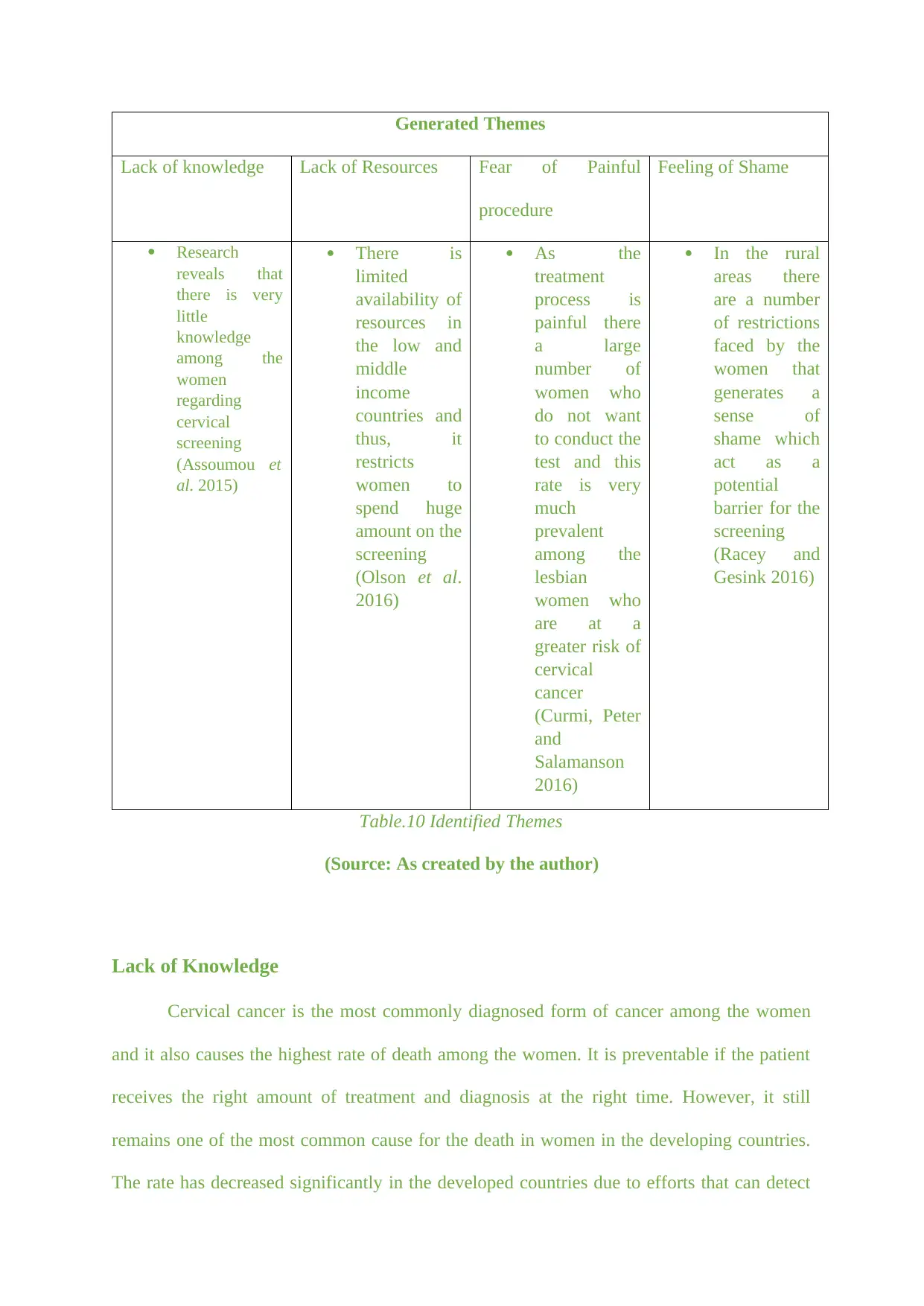
Generated Themes
Lack of knowledge Lack of Resources Fear of Painful
procedure
Feeling of Shame
Research
reveals that
there is very
little
knowledge
among the
women
regarding
cervical
screening
(Assoumou et
al. 2015)
There is
limited
availability of
resources in
the low and
middle
income
countries and
thus, it
restricts
women to
spend huge
amount on the
screening
(Olson et al.
2016)
As the
treatment
process is
painful there
a large
number of
women who
do not want
to conduct the
test and this
rate is very
much
prevalent
among the
lesbian
women who
are at a
greater risk of
cervical
cancer
(Curmi, Peter
and
Salamanson
2016)
In the rural
areas there
are a number
of restrictions
faced by the
women that
generates a
sense of
shame which
act as a
potential
barrier for the
screening
(Racey and
Gesink 2016)
Table.10 Identified Themes
(Source: As created by the author)
Lack of Knowledge
Cervical cancer is the most commonly diagnosed form of cancer among the women
and it also causes the highest rate of death among the women. It is preventable if the patient
receives the right amount of treatment and diagnosis at the right time. However, it still
remains one of the most common cause for the death in women in the developing countries.
The rate has decreased significantly in the developed countries due to efforts that can detect
Lack of knowledge Lack of Resources Fear of Painful
procedure
Feeling of Shame
Research
reveals that
there is very
little
knowledge
among the
women
regarding
cervical
screening
(Assoumou et
al. 2015)
There is
limited
availability of
resources in
the low and
middle
income
countries and
thus, it
restricts
women to
spend huge
amount on the
screening
(Olson et al.
2016)
As the
treatment
process is
painful there
a large
number of
women who
do not want
to conduct the
test and this
rate is very
much
prevalent
among the
lesbian
women who
are at a
greater risk of
cervical
cancer
(Curmi, Peter
and
Salamanson
2016)
In the rural
areas there
are a number
of restrictions
faced by the
women that
generates a
sense of
shame which
act as a
potential
barrier for the
screening
(Racey and
Gesink 2016)
Table.10 Identified Themes
(Source: As created by the author)
Lack of Knowledge
Cervical cancer is the most commonly diagnosed form of cancer among the women
and it also causes the highest rate of death among the women. It is preventable if the patient
receives the right amount of treatment and diagnosis at the right time. However, it still
remains one of the most common cause for the death in women in the developing countries.
The rate has decreased significantly in the developed countries due to efforts that can detect
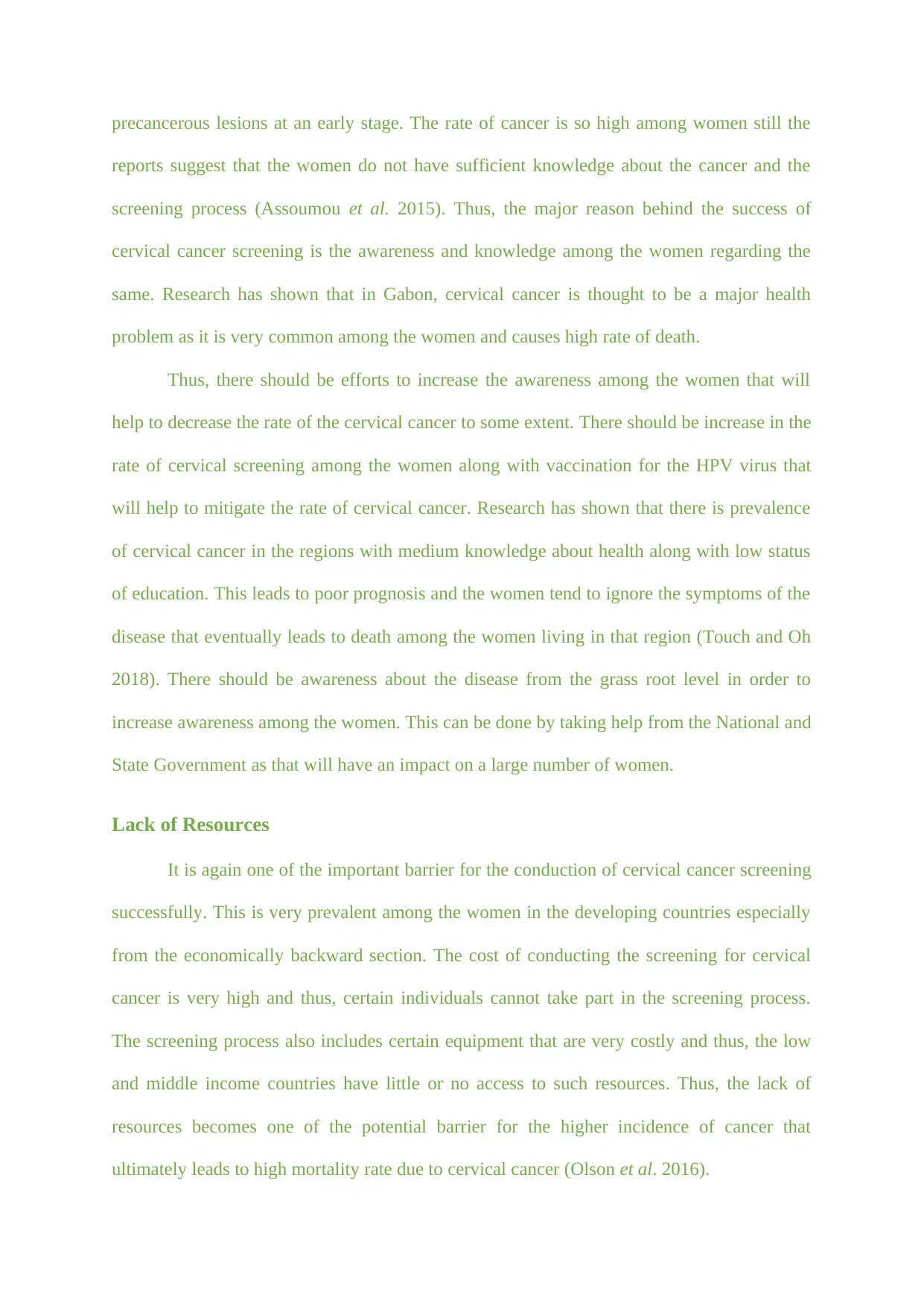
precancerous lesions at an early stage. The rate of cancer is so high among women still the
reports suggest that the women do not have sufficient knowledge about the cancer and the
screening process (Assoumou et al. 2015). Thus, the major reason behind the success of
cervical cancer screening is the awareness and knowledge among the women regarding the
same. Research has shown that in Gabon, cervical cancer is thought to be a major health
problem as it is very common among the women and causes high rate of death.
Thus, there should be efforts to increase the awareness among the women that will
help to decrease the rate of the cervical cancer to some extent. There should be increase in the
rate of cervical screening among the women along with vaccination for the HPV virus that
will help to mitigate the rate of cervical cancer. Research has shown that there is prevalence
of cervical cancer in the regions with medium knowledge about health along with low status
of education. This leads to poor prognosis and the women tend to ignore the symptoms of the
disease that eventually leads to death among the women living in that region (Touch and Oh
2018). There should be awareness about the disease from the grass root level in order to
increase awareness among the women. This can be done by taking help from the National and
State Government as that will have an impact on a large number of women.
Lack of Resources
It is again one of the important barrier for the conduction of cervical cancer screening
successfully. This is very prevalent among the women in the developing countries especially
from the economically backward section. The cost of conducting the screening for cervical
cancer is very high and thus, certain individuals cannot take part in the screening process.
The screening process also includes certain equipment that are very costly and thus, the low
and middle income countries have little or no access to such resources. Thus, the lack of
resources becomes one of the potential barrier for the higher incidence of cancer that
ultimately leads to high mortality rate due to cervical cancer (Olson et al. 2016).
reports suggest that the women do not have sufficient knowledge about the cancer and the
screening process (Assoumou et al. 2015). Thus, the major reason behind the success of
cervical cancer screening is the awareness and knowledge among the women regarding the
same. Research has shown that in Gabon, cervical cancer is thought to be a major health
problem as it is very common among the women and causes high rate of death.
Thus, there should be efforts to increase the awareness among the women that will
help to decrease the rate of the cervical cancer to some extent. There should be increase in the
rate of cervical screening among the women along with vaccination for the HPV virus that
will help to mitigate the rate of cervical cancer. Research has shown that there is prevalence
of cervical cancer in the regions with medium knowledge about health along with low status
of education. This leads to poor prognosis and the women tend to ignore the symptoms of the
disease that eventually leads to death among the women living in that region (Touch and Oh
2018). There should be awareness about the disease from the grass root level in order to
increase awareness among the women. This can be done by taking help from the National and
State Government as that will have an impact on a large number of women.
Lack of Resources
It is again one of the important barrier for the conduction of cervical cancer screening
successfully. This is very prevalent among the women in the developing countries especially
from the economically backward section. The cost of conducting the screening for cervical
cancer is very high and thus, certain individuals cannot take part in the screening process.
The screening process also includes certain equipment that are very costly and thus, the low
and middle income countries have little or no access to such resources. Thus, the lack of
resources becomes one of the potential barrier for the higher incidence of cancer that
ultimately leads to high mortality rate due to cervical cancer (Olson et al. 2016).
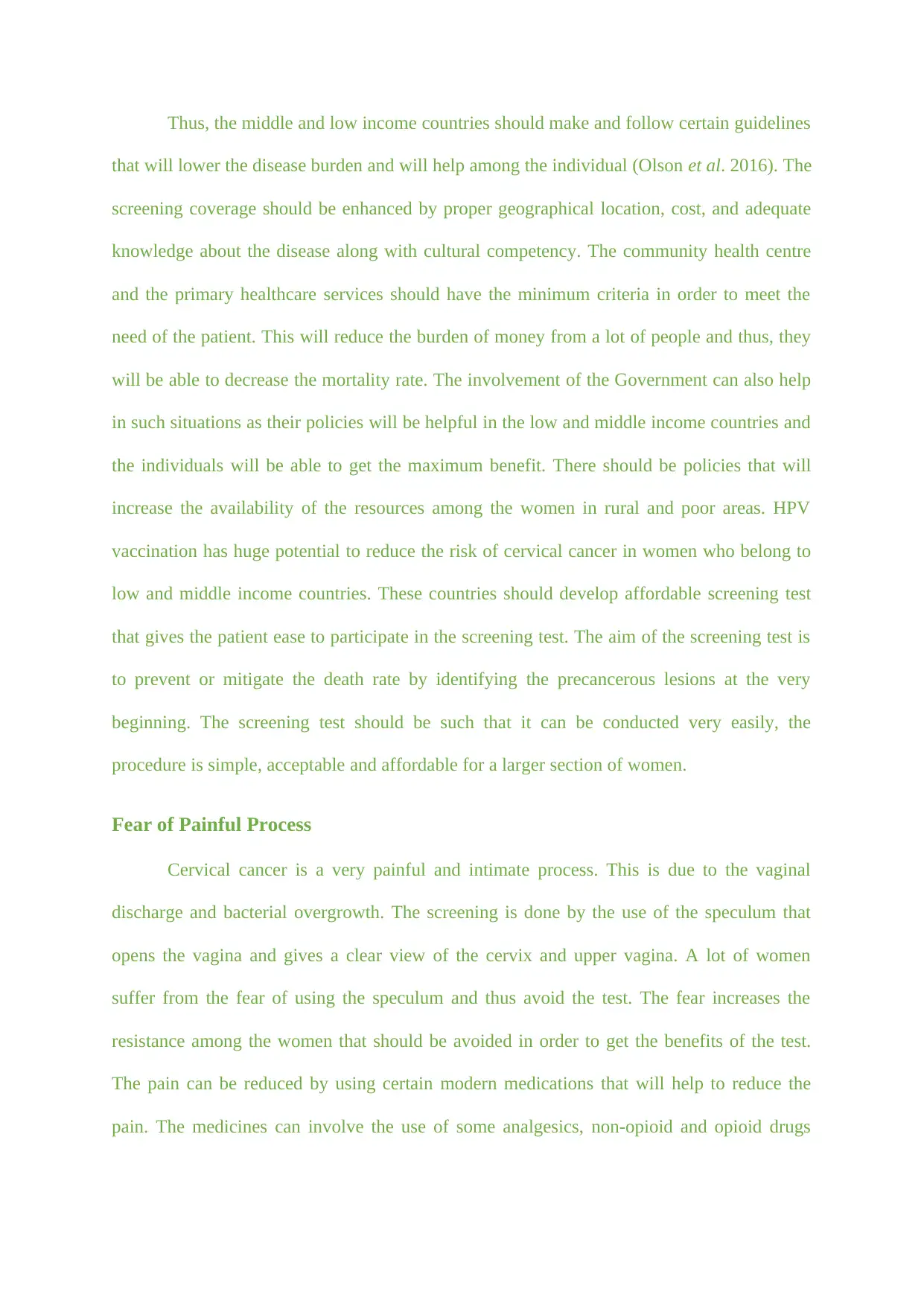
Thus, the middle and low income countries should make and follow certain guidelines
that will lower the disease burden and will help among the individual (Olson et al. 2016). The
screening coverage should be enhanced by proper geographical location, cost, and adequate
knowledge about the disease along with cultural competency. The community health centre
and the primary healthcare services should have the minimum criteria in order to meet the
need of the patient. This will reduce the burden of money from a lot of people and thus, they
will be able to decrease the mortality rate. The involvement of the Government can also help
in such situations as their policies will be helpful in the low and middle income countries and
the individuals will be able to get the maximum benefit. There should be policies that will
increase the availability of the resources among the women in rural and poor areas. HPV
vaccination has huge potential to reduce the risk of cervical cancer in women who belong to
low and middle income countries. These countries should develop affordable screening test
that gives the patient ease to participate in the screening test. The aim of the screening test is
to prevent or mitigate the death rate by identifying the precancerous lesions at the very
beginning. The screening test should be such that it can be conducted very easily, the
procedure is simple, acceptable and affordable for a larger section of women.
Fear of Painful Process
Cervical cancer is a very painful and intimate process. This is due to the vaginal
discharge and bacterial overgrowth. The screening is done by the use of the speculum that
opens the vagina and gives a clear view of the cervix and upper vagina. A lot of women
suffer from the fear of using the speculum and thus avoid the test. The fear increases the
resistance among the women that should be avoided in order to get the benefits of the test.
The pain can be reduced by using certain modern medications that will help to reduce the
pain. The medicines can involve the use of some analgesics, non-opioid and opioid drugs
that will lower the disease burden and will help among the individual (Olson et al. 2016). The
screening coverage should be enhanced by proper geographical location, cost, and adequate
knowledge about the disease along with cultural competency. The community health centre
and the primary healthcare services should have the minimum criteria in order to meet the
need of the patient. This will reduce the burden of money from a lot of people and thus, they
will be able to decrease the mortality rate. The involvement of the Government can also help
in such situations as their policies will be helpful in the low and middle income countries and
the individuals will be able to get the maximum benefit. There should be policies that will
increase the availability of the resources among the women in rural and poor areas. HPV
vaccination has huge potential to reduce the risk of cervical cancer in women who belong to
low and middle income countries. These countries should develop affordable screening test
that gives the patient ease to participate in the screening test. The aim of the screening test is
to prevent or mitigate the death rate by identifying the precancerous lesions at the very
beginning. The screening test should be such that it can be conducted very easily, the
procedure is simple, acceptable and affordable for a larger section of women.
Fear of Painful Process
Cervical cancer is a very painful and intimate process. This is due to the vaginal
discharge and bacterial overgrowth. The screening is done by the use of the speculum that
opens the vagina and gives a clear view of the cervix and upper vagina. A lot of women
suffer from the fear of using the speculum and thus avoid the test. The fear increases the
resistance among the women that should be avoided in order to get the benefits of the test.
The pain can be reduced by using certain modern medications that will help to reduce the
pain. The medicines can involve the use of some analgesics, non-opioid and opioid drugs
Secure Best Marks with AI Grader
Need help grading? Try our AI Grader for instant feedback on your assignments.
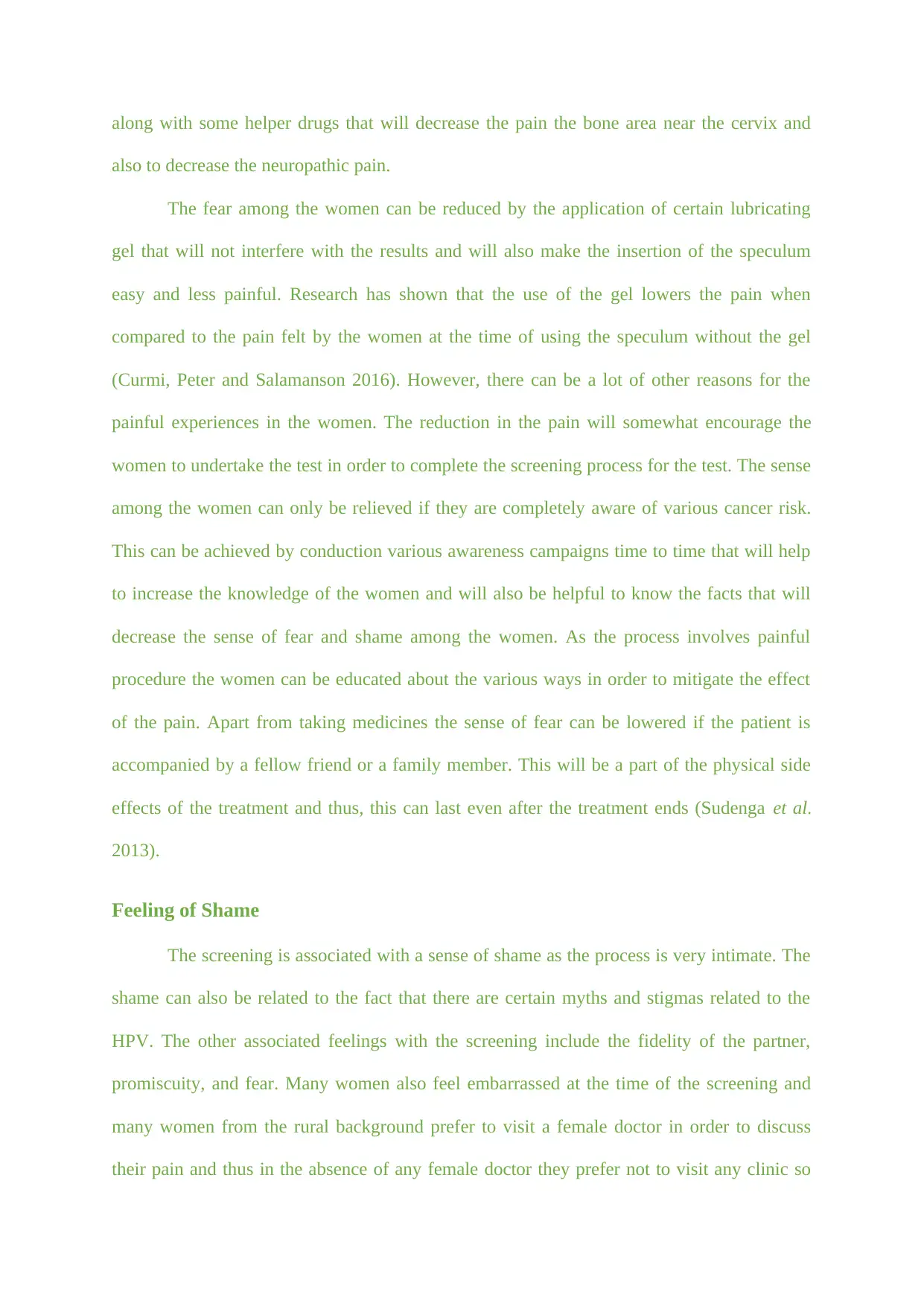
along with some helper drugs that will decrease the pain the bone area near the cervix and
also to decrease the neuropathic pain.
The fear among the women can be reduced by the application of certain lubricating
gel that will not interfere with the results and will also make the insertion of the speculum
easy and less painful. Research has shown that the use of the gel lowers the pain when
compared to the pain felt by the women at the time of using the speculum without the gel
(Curmi, Peter and Salamanson 2016). However, there can be a lot of other reasons for the
painful experiences in the women. The reduction in the pain will somewhat encourage the
women to undertake the test in order to complete the screening process for the test. The sense
among the women can only be relieved if they are completely aware of various cancer risk.
This can be achieved by conduction various awareness campaigns time to time that will help
to increase the knowledge of the women and will also be helpful to know the facts that will
decrease the sense of fear and shame among the women. As the process involves painful
procedure the women can be educated about the various ways in order to mitigate the effect
of the pain. Apart from taking medicines the sense of fear can be lowered if the patient is
accompanied by a fellow friend or a family member. This will be a part of the physical side
effects of the treatment and thus, this can last even after the treatment ends (Sudenga et al.
2013).
Feeling of Shame
The screening is associated with a sense of shame as the process is very intimate. The
shame can also be related to the fact that there are certain myths and stigmas related to the
HPV. The other associated feelings with the screening include the fidelity of the partner,
promiscuity, and fear. Many women also feel embarrassed at the time of the screening and
many women from the rural background prefer to visit a female doctor in order to discuss
their pain and thus in the absence of any female doctor they prefer not to visit any clinic so
also to decrease the neuropathic pain.
The fear among the women can be reduced by the application of certain lubricating
gel that will not interfere with the results and will also make the insertion of the speculum
easy and less painful. Research has shown that the use of the gel lowers the pain when
compared to the pain felt by the women at the time of using the speculum without the gel
(Curmi, Peter and Salamanson 2016). However, there can be a lot of other reasons for the
painful experiences in the women. The reduction in the pain will somewhat encourage the
women to undertake the test in order to complete the screening process for the test. The sense
among the women can only be relieved if they are completely aware of various cancer risk.
This can be achieved by conduction various awareness campaigns time to time that will help
to increase the knowledge of the women and will also be helpful to know the facts that will
decrease the sense of fear and shame among the women. As the process involves painful
procedure the women can be educated about the various ways in order to mitigate the effect
of the pain. Apart from taking medicines the sense of fear can be lowered if the patient is
accompanied by a fellow friend or a family member. This will be a part of the physical side
effects of the treatment and thus, this can last even after the treatment ends (Sudenga et al.
2013).
Feeling of Shame
The screening is associated with a sense of shame as the process is very intimate. The
shame can also be related to the fact that there are certain myths and stigmas related to the
HPV. The other associated feelings with the screening include the fidelity of the partner,
promiscuity, and fear. Many women also feel embarrassed at the time of the screening and
many women from the rural background prefer to visit a female doctor in order to discuss
their pain and thus in the absence of any female doctor they prefer not to visit any clinic so
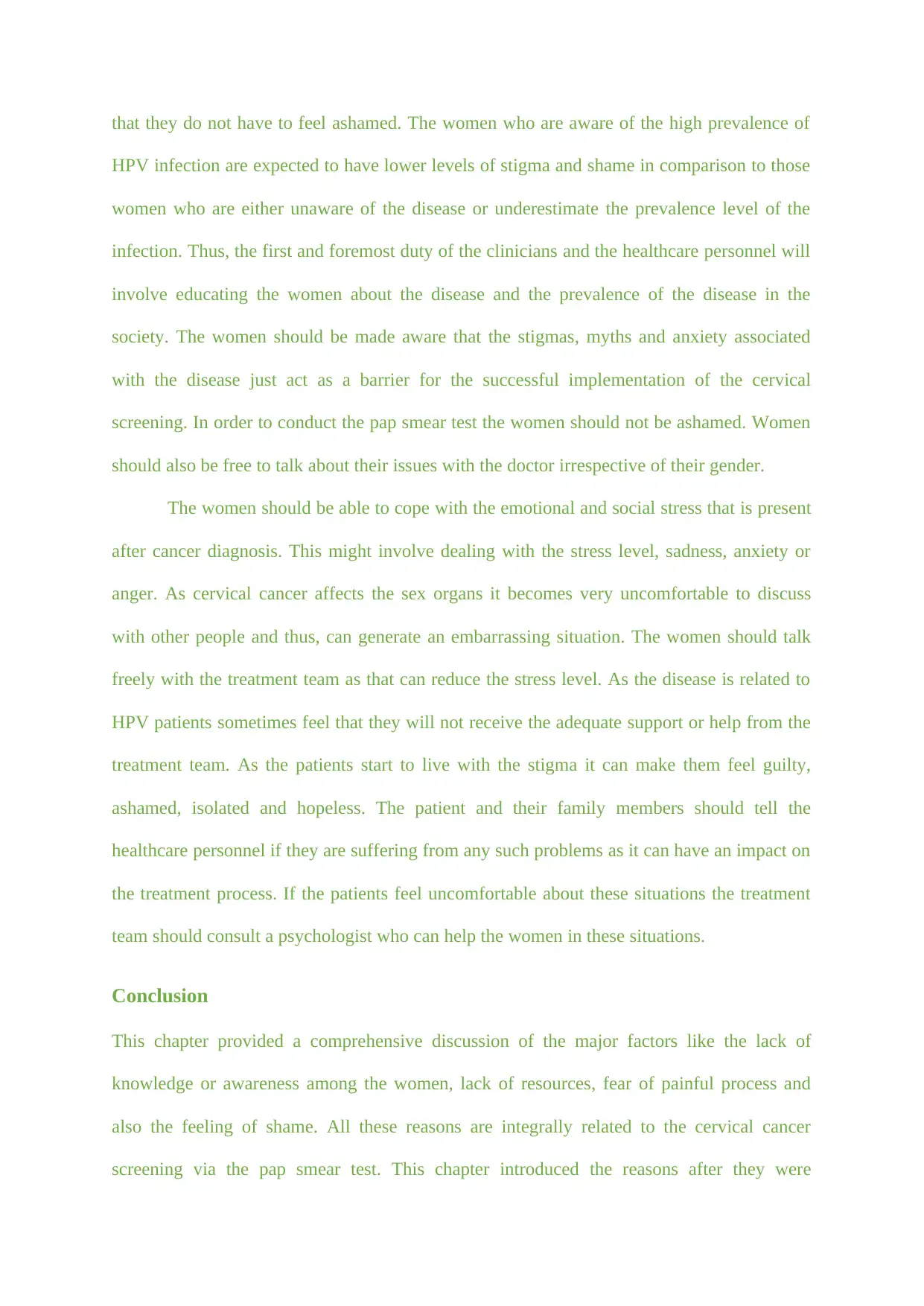
that they do not have to feel ashamed. The women who are aware of the high prevalence of
HPV infection are expected to have lower levels of stigma and shame in comparison to those
women who are either unaware of the disease or underestimate the prevalence level of the
infection. Thus, the first and foremost duty of the clinicians and the healthcare personnel will
involve educating the women about the disease and the prevalence of the disease in the
society. The women should be made aware that the stigmas, myths and anxiety associated
with the disease just act as a barrier for the successful implementation of the cervical
screening. In order to conduct the pap smear test the women should not be ashamed. Women
should also be free to talk about their issues with the doctor irrespective of their gender.
The women should be able to cope with the emotional and social stress that is present
after cancer diagnosis. This might involve dealing with the stress level, sadness, anxiety or
anger. As cervical cancer affects the sex organs it becomes very uncomfortable to discuss
with other people and thus, can generate an embarrassing situation. The women should talk
freely with the treatment team as that can reduce the stress level. As the disease is related to
HPV patients sometimes feel that they will not receive the adequate support or help from the
treatment team. As the patients start to live with the stigma it can make them feel guilty,
ashamed, isolated and hopeless. The patient and their family members should tell the
healthcare personnel if they are suffering from any such problems as it can have an impact on
the treatment process. If the patients feel uncomfortable about these situations the treatment
team should consult a psychologist who can help the women in these situations.
Conclusion
This chapter provided a comprehensive discussion of the major factors like the lack of
knowledge or awareness among the women, lack of resources, fear of painful process and
also the feeling of shame. All these reasons are integrally related to the cervical cancer
screening via the pap smear test. This chapter introduced the reasons after they were
HPV infection are expected to have lower levels of stigma and shame in comparison to those
women who are either unaware of the disease or underestimate the prevalence level of the
infection. Thus, the first and foremost duty of the clinicians and the healthcare personnel will
involve educating the women about the disease and the prevalence of the disease in the
society. The women should be made aware that the stigmas, myths and anxiety associated
with the disease just act as a barrier for the successful implementation of the cervical
screening. In order to conduct the pap smear test the women should not be ashamed. Women
should also be free to talk about their issues with the doctor irrespective of their gender.
The women should be able to cope with the emotional and social stress that is present
after cancer diagnosis. This might involve dealing with the stress level, sadness, anxiety or
anger. As cervical cancer affects the sex organs it becomes very uncomfortable to discuss
with other people and thus, can generate an embarrassing situation. The women should talk
freely with the treatment team as that can reduce the stress level. As the disease is related to
HPV patients sometimes feel that they will not receive the adequate support or help from the
treatment team. As the patients start to live with the stigma it can make them feel guilty,
ashamed, isolated and hopeless. The patient and their family members should tell the
healthcare personnel if they are suffering from any such problems as it can have an impact on
the treatment process. If the patients feel uncomfortable about these situations the treatment
team should consult a psychologist who can help the women in these situations.
Conclusion
This chapter provided a comprehensive discussion of the major factors like the lack of
knowledge or awareness among the women, lack of resources, fear of painful process and
also the feeling of shame. All these reasons are integrally related to the cervical cancer
screening via the pap smear test. This chapter introduced the reasons after they were
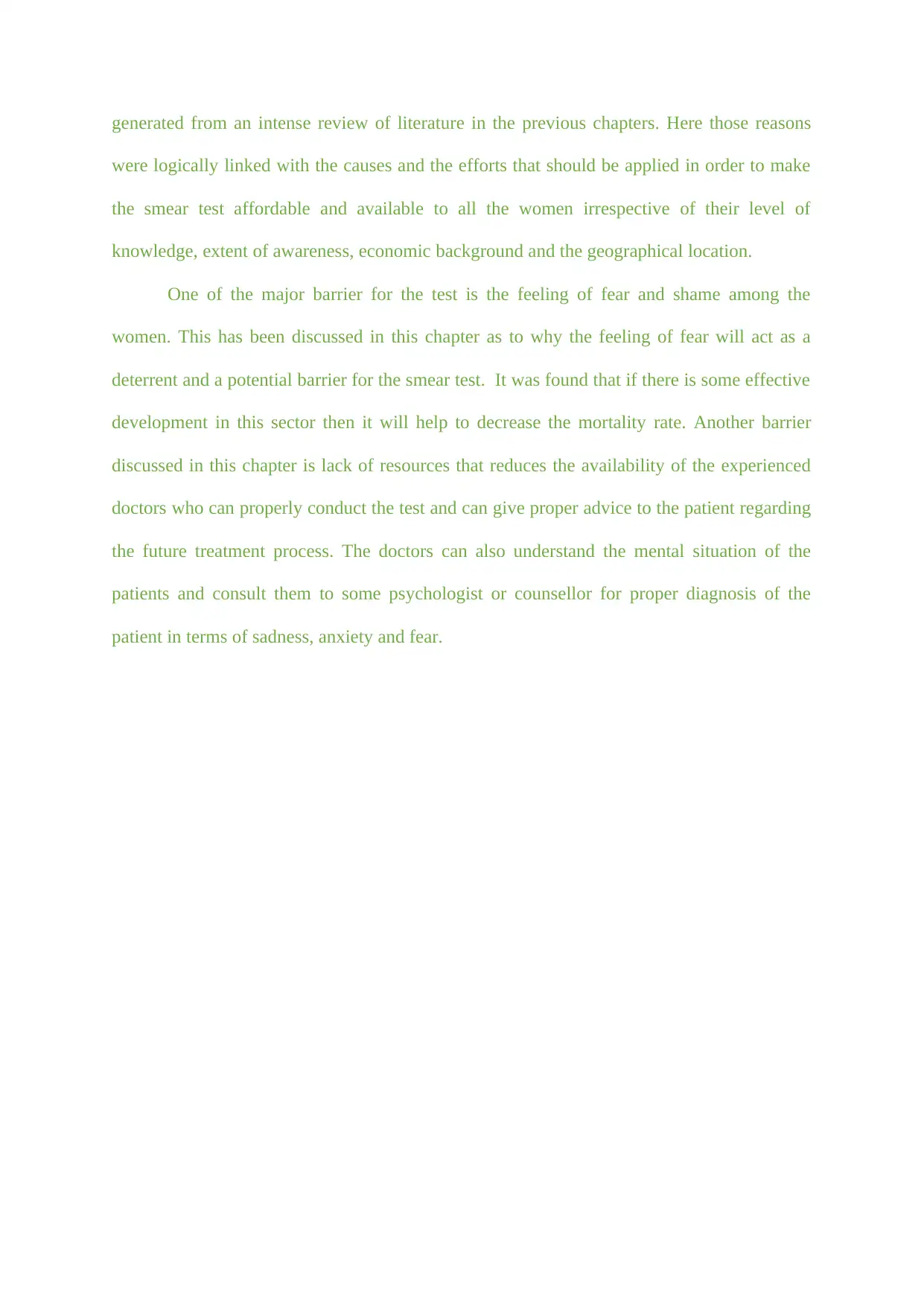
generated from an intense review of literature in the previous chapters. Here those reasons
were logically linked with the causes and the efforts that should be applied in order to make
the smear test affordable and available to all the women irrespective of their level of
knowledge, extent of awareness, economic background and the geographical location.
One of the major barrier for the test is the feeling of fear and shame among the
women. This has been discussed in this chapter as to why the feeling of fear will act as a
deterrent and a potential barrier for the smear test. It was found that if there is some effective
development in this sector then it will help to decrease the mortality rate. Another barrier
discussed in this chapter is lack of resources that reduces the availability of the experienced
doctors who can properly conduct the test and can give proper advice to the patient regarding
the future treatment process. The doctors can also understand the mental situation of the
patients and consult them to some psychologist or counsellor for proper diagnosis of the
patient in terms of sadness, anxiety and fear.
were logically linked with the causes and the efforts that should be applied in order to make
the smear test affordable and available to all the women irrespective of their level of
knowledge, extent of awareness, economic background and the geographical location.
One of the major barrier for the test is the feeling of fear and shame among the
women. This has been discussed in this chapter as to why the feeling of fear will act as a
deterrent and a potential barrier for the smear test. It was found that if there is some effective
development in this sector then it will help to decrease the mortality rate. Another barrier
discussed in this chapter is lack of resources that reduces the availability of the experienced
doctors who can properly conduct the test and can give proper advice to the patient regarding
the future treatment process. The doctors can also understand the mental situation of the
patients and consult them to some psychologist or counsellor for proper diagnosis of the
patient in terms of sadness, anxiety and fear.
Paraphrase This Document
Need a fresh take? Get an instant paraphrase of this document with our AI Paraphraser
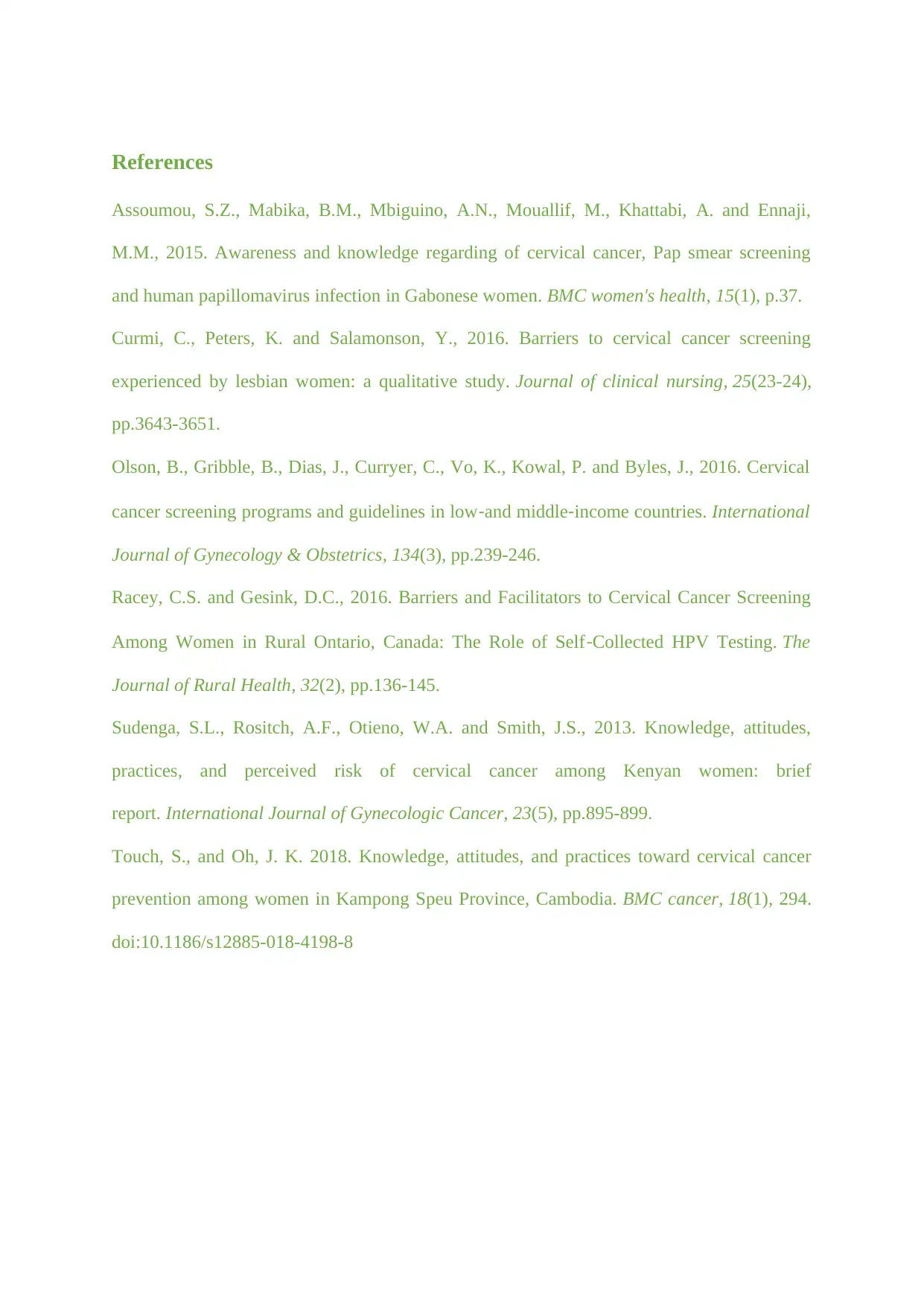
References
Assoumou, S.Z., Mabika, B.M., Mbiguino, A.N., Mouallif, M., Khattabi, A. and Ennaji,
M.M., 2015. Awareness and knowledge regarding of cervical cancer, Pap smear screening
and human papillomavirus infection in Gabonese women. BMC women's health, 15(1), p.37.
Curmi, C., Peters, K. and Salamonson, Y., 2016. Barriers to cervical cancer screening
experienced by lesbian women: a qualitative study. Journal of clinical nursing, 25(23-24),
pp.3643-3651.
Olson, B., Gribble, B., Dias, J., Curryer, C., Vo, K., Kowal, P. and Byles, J., 2016. Cervical
cancer screening programs and guidelines in low‐and middle‐income countries. International
Journal of Gynecology & Obstetrics, 134(3), pp.239-246.
Racey, C.S. and Gesink, D.C., 2016. Barriers and Facilitators to Cervical Cancer Screening
Among Women in Rural Ontario, Canada: The Role of Self‐Collected HPV Testing. The
Journal of Rural Health, 32(2), pp.136-145.
Sudenga, S.L., Rositch, A.F., Otieno, W.A. and Smith, J.S., 2013. Knowledge, attitudes,
practices, and perceived risk of cervical cancer among Kenyan women: brief
report. International Journal of Gynecologic Cancer, 23(5), pp.895-899.
Touch, S., and Oh, J. K. 2018. Knowledge, attitudes, and practices toward cervical cancer
prevention among women in Kampong Speu Province, Cambodia. BMC cancer, 18(1), 294.
doi:10.1186/s12885-018-4198-8
Assoumou, S.Z., Mabika, B.M., Mbiguino, A.N., Mouallif, M., Khattabi, A. and Ennaji,
M.M., 2015. Awareness and knowledge regarding of cervical cancer, Pap smear screening
and human papillomavirus infection in Gabonese women. BMC women's health, 15(1), p.37.
Curmi, C., Peters, K. and Salamonson, Y., 2016. Barriers to cervical cancer screening
experienced by lesbian women: a qualitative study. Journal of clinical nursing, 25(23-24),
pp.3643-3651.
Olson, B., Gribble, B., Dias, J., Curryer, C., Vo, K., Kowal, P. and Byles, J., 2016. Cervical
cancer screening programs and guidelines in low‐and middle‐income countries. International
Journal of Gynecology & Obstetrics, 134(3), pp.239-246.
Racey, C.S. and Gesink, D.C., 2016. Barriers and Facilitators to Cervical Cancer Screening
Among Women in Rural Ontario, Canada: The Role of Self‐Collected HPV Testing. The
Journal of Rural Health, 32(2), pp.136-145.
Sudenga, S.L., Rositch, A.F., Otieno, W.A. and Smith, J.S., 2013. Knowledge, attitudes,
practices, and perceived risk of cervical cancer among Kenyan women: brief
report. International Journal of Gynecologic Cancer, 23(5), pp.895-899.
Touch, S., and Oh, J. K. 2018. Knowledge, attitudes, and practices toward cervical cancer
prevention among women in Kampong Speu Province, Cambodia. BMC cancer, 18(1), 294.
doi:10.1186/s12885-018-4198-8
1 out of 56
Your All-in-One AI-Powered Toolkit for Academic Success.
+13062052269
info@desklib.com
Available 24*7 on WhatsApp / Email
![[object Object]](/_next/static/media/star-bottom.7253800d.svg)
Unlock your academic potential
© 2024 | Zucol Services PVT LTD | All rights reserved.